- Our Heymondo Review - Why We Always Get Travel Insurance
- Our Favorite 10 Beaches from 20 Years of Travel
- How to Start Teaching Abroad: Tips from Expert Georgie from Teacher's Friend
- Sync.com for Travelers: Our Hands-on Review After 3 Years
- Hiking with Kids: Essential Gear for a Fun and Safe Adventure
- Discover Branson's Finest Hiking Trails
- Work With Us

How to Get High-Speed Wi-Fi When Traveling
Looking for reliable, fast wi-fi when traveling?
If you’re having trouble getting affordable, reliable internet on the road, we feel your pain. In almost 20 years of traveling together, we’ve suffered through weak wi-fi signals at hotels, cafes, and in more restaurants than we can count. Sure, sometimes we luck out and get reliable internet, but that’s not always the case.
At this point, we’ve used almost every kind of internet connection available when we travel, whether overseas or domestically.
The Best Options for Wi-Fi When Traveling
In this post, we’ll guide you through your options for getting reliable, fast wi-fi when traveling, and the pros and cons of each type.
Whether you’re looking for temporary internet for a vacation home, internet for a laptop or phone while you travel, or even internet while traveling in an RV on a road trip, here are some of your best options.
Beg, Borrow, or Steal Free Wi-Fi
When we first started traveling together, we spent a lot of time and hassle trying to find free internet for travelers. Over the years, I swear we’ve used the free wi-fi at every hotel chain and fast food chain around.
Sometimes the wi-fi is fast and reliable, but most of the time it’s spotty and unreliable. We’ve had more than our share of times where the internet was completely down, or where we couldn’t get the wi-fi signal in our room.
Pros : It’s free. Most hotel, restaurant, and public place wi-fi is free (though there are exceptions). It’s also easy to access.
Cons : Security is a major issue here, as it’s relatively easy to intercept your data. A password manager and a VPN can help with security, but you’re always taking your chances with free wi-fi. If you use a VPN, be sure to pick one that has a no logs policy, like the reputable Private Internet Access (PIA) VPN .
Use Roaming from Your Mobile Provider
Likely the easiest way to get wi-fi on the road is to simply use roaming data from your existing cell phone provider.
The danger of this is that you’ll get slammed with outrageously expensive roaming fees when you get home. To avoid the price shock, contact your cell provider and see if they offer a more affordable roaming plan.
Pro : Easy, instant and generally reliable and secure.
Con : May be prohibitively expensive. To share your cell’s data with a computer or other mobile, you’ll need share your connection via wi-fi, USB, or Bluetooth. This is called tethering, and can result in slowing down the data connection, and may drain your phone’s battery quickly.
Get a Mobile Hotspot
In the last five years, we’ve become huge fans of mobile hotspots for internet access.
A mobile hotspot is a small device (usually the size of a deck of cards) that gets you internet access wherever you go, whether that’s on a road trip near home, or in a country half way around the world.
You’ll pay a fee to rent the portable wi-fi hotspot for travel (or you can buy it outright), and then pay for a data plan. Depending on where you are in the world, data plans can run from $8 a day internationally, or $49 for unlimited internet in the USA for up to a week.
Most hotspots let you connect up to 10 devices, so they’re great for groups or families, but they don’t offer SMS texts or voice phone calls (though you can always use an app like Fongo or Google Voice to call).
- GlocalMe portable Wi-Fi hotspot review
- Skyroam Solis portable Wi-Fi review
- Keepgo MiFi device review .
Pros : Convenient, easy to use, reliable connection in most countries and fast speeds, some with unlimited data. Great for groups.
Cons : More expensive than free hotel Wi-Fi.
Buy a SIM Card at Your Destination
Buying a local SIM card at your destination can be a great way to save money, and save you from expensive roaming charges or scrounging free wi-fi.
Companies like Orange Travel can offer great savings, when compared to roaming or paying for a Wi-Fi hotspot.
Right now they have an Orange Holiday Europe 20GB deal on, which includes includes unlimited calls and texts in Europe.
However, depending on your destination country, tracking down a local SIM card can be tricky. Occasionally, you can find a kiosk selling SIMs in the airport, but we’ve often had to schlep around a new city to find a cell provider. You can usually get a local SIM at convenience stores, news stands, and vending machines.
The biggest negative with a SIM card is that if you’re traveling to multiple countries, a local SIM may not work in all of the countries you visit. It’s also harder to share your connection with other members of your family or group.
Some countries may also require that you’re a citizen, or need a local address, to get a local SIM card, so a local SIM isn’t an option everywhere.
You’ll also have to physically remove your mobile phone’s old SIM card, store it somewhere, and insert the new SIM card, which isn’t everyone’s cup of tea.
Pros : Generally affordable, and speeds are usually good.
Cons : Finding a local SIM can be inconvenient, and it may not work in more than one country. You’ll also need an unlocked phone for this to work. To share your connection, you’ll need to create an internet tethering connection or a hotspot on your phone to share the internet connection to a laptop, tablet, or other phones.
Buy a Roaming SIM Card at Home
You can buy a local SIM card when you get to your destination, but that can be inconvenient, especially if you’re short on time.
Some companies simplify travel internet by letting you buy a SIM card at home for use as you travel. The SIM comes with a data plan, and also usually lets you make phone calls and get SMS messages while abroad. To use it, you’ll just need to remove your old SIM card, and insert the travel SIM once you arrive in your destination country.
Pros : Affordable (generally under $50).
Cons : Same as the previous one. To use internet on computers or other phones, you’ll need to create a mobile hotspot connection (called tethering). You’ll also need an unlocked phone.
Internet Cafe
We’re really showing our age here, but when we first started traveling together back in 2001, we relied almost exclusively on Internet cafes (also called cyber cafés) for how to get internet away from home.
Their rows of boxy monitors and beat up desktop computers used to mean an instant connection to the internet, for the cost of a small hourly fee. In 2001, internet cafes were used by almost all travelers as a place to get together, and get good internet. Today, cell phones and free wi-fi have all but obliterated the good old internet café.
While you’d be hard pressed to find an internet café in most tourist spots today, they do exist in much less developed areas. If you’re looking for one as you travel, also look out for gaming centers or gaming cafes since many have gone that route, however their gaming computers can still be used to browse the web, print things off and chat with loved ones back home.
BTW, the last time we used a dedicated internet café was in the Philippines back in 2008, and we used it to access a printer, not for the internet connection, though we have jumped into a few gaming centers over the years to cool down with their aircon and let the kids game for a while.
Pros: No computer or mobile phone needed, affordably hourly cost, generally high connection speeds.
Cons : Security issues with using a shared computer, often noisy environment and overall lack of privacy.
What’s your preferred method of internet access when you travel? Let us know in the comments.
Finding reliable wifi when traveling is always a concern. Free wifi always has security concerns. I like your idea about purchasing a local SIM card to avoid roaming charges.
Getting high speed Wi-Fi when travelling is such a blessing! Sometime the connection at your hotel is weak and I completely understand the security threat. Great to learn a few options on having Wi-Fi on the go. Thanks for this informative post.
We have been begging, borrowing and stealing while on the go when it comes to Wi-Fi connection. A local sim card is a great option to get affordable and uninterrupted connection I feel. Besides it is easy to contact the provider and promptly get things sorted in case of technical glitches. Wonderful post!
Informative Post. I think buying a sim card at the destination is always a good choice, however its best to do your own research since there are many vendors at airports looking to get your on their most expensive plan which is overpriced.
My favorite part of this article is a password manager and a VPN can assist with security, but with free wi-fi, you’re constantly taking chances. Someone recently told me about this and it is different from what I understand. Thanks for helping me understand internet service plans.
Loved your blog, thanks for the information, I find it really interesting.
My favorite hotspot is the local library. Most towns even small have one and they are free to hook up to their WiFi as a guest.
Leave a Reply Cancel reply
Your email address will not be published. Required fields are marked *
This site uses Akismet to reduce spam. Learn how your comment data is processed .
Finding the Universe
Travel tales, photography and a dash of humor

Internet Access when Traveling: How to Get Online On The Go
Last updated: November 4, 2023 . Written by Laurence Norah - 26 Comments
If you are planning an international trip, you might be wondering the best way to access the internet when traveling. High-speed internet access on the go is definitely achievable, and doesn’t have to cost a fortune either.
I’m sure you’ve heard horror stories from people who’ve gone away on an international trip and then returned home to a huge bill thanks to their mobile phone roaming on data networks when they’re away.
The good news is, this doesn’t have to be you. There are lots of options for getting on the internet when you travel, ranging from entirely free through to more premium options.
In today’s post I want to help guide you through the options available to you when you travel for getting online.
This will include options for getting internet on your phone whilst you are away from home, as well as on any other devices you might have with you, including tablets and laptops. I’ll cover options that work for a variety of travel styles, including options for getting online in an RV.
My guide will focus purely on internet access while traveling, rather than texting or calling, although some of the solutions below will also work for texting and calling.
These are based on our personal experiences travelling through multiple countries each year, and are listed in order of our personal preference for how we get online when travelling. We’ve also included any discount codes that we’ve been able to find from suppliers for you guys.
Table of Contents:
The Best Options for Internet Access when Traveling
Below are all the options you have for getting online when traveling abroad. These cover a wide range of options and we think at least one of these options should work for you!
1. Use Your Mobile Provider
The first thing to do is check with your mobile phone company if they offer any form of roaming as part of your package for the countries you are visiting – often referred to as an international plan. This might be the easiest and cheapest way to get online when you travel.
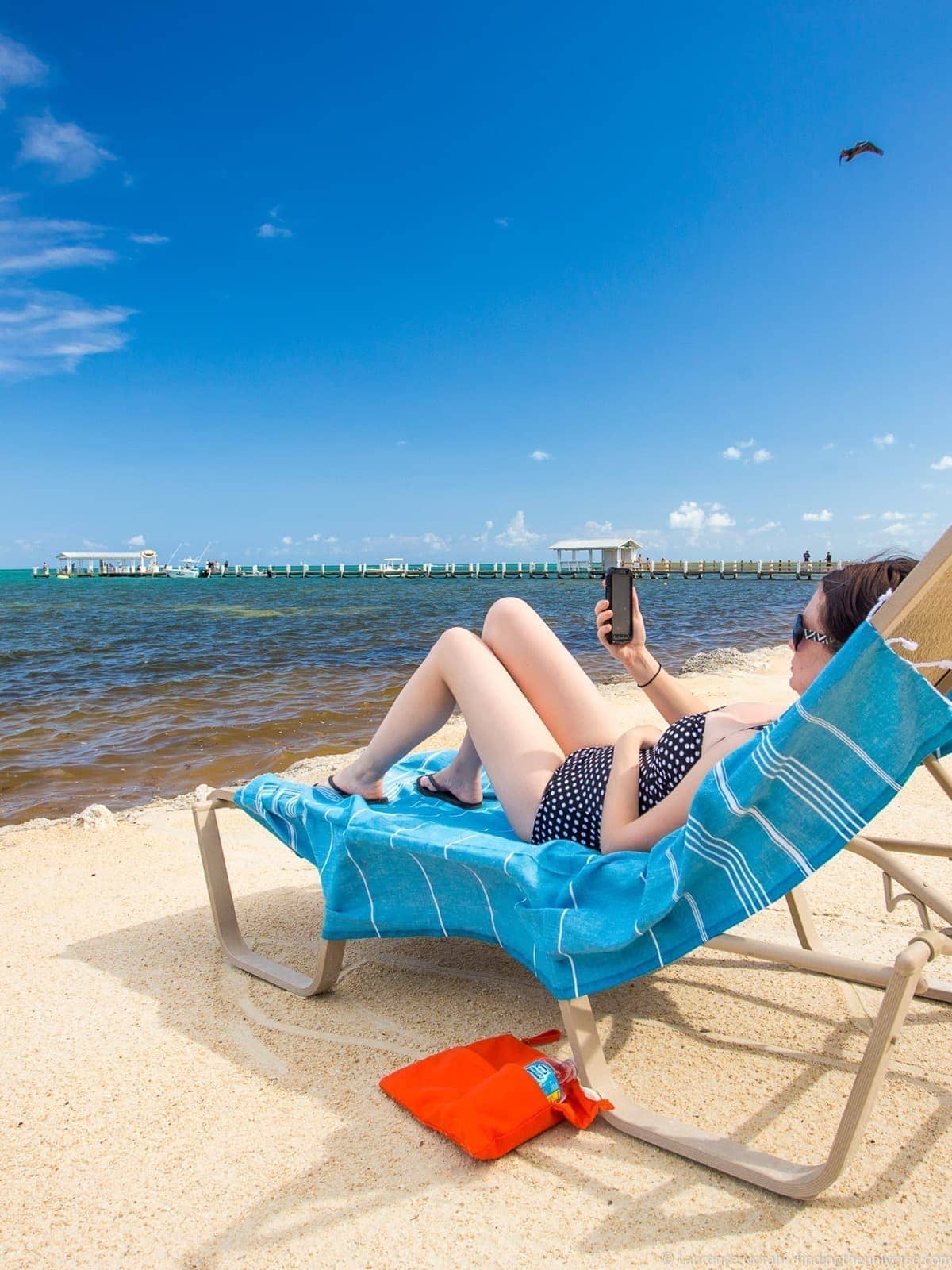
In the US, T-Mobile users on a qualifying plan have access to 2G speeds in over 140 countries with no additional charges.
Whilst 2G isn’t super-fast, it’s certainly good enough for the essentials like e-mail, messaging, and getting directions.
Google’s Fi offering is also excellent, letting you use your data allowance pretty much everywhere you go if you are on the appropriate plan.
Some mobile providers, like Three in the UK, also either include roaming data, or allow you to purchase overseas roaming packages on a day-to-day basis. These let you get online on the days you really need to.
This can be cost effective if you only need to get online on a small number of days, but can add up over a prolonged period, in which case you might want to investigate the other options below.
Note that if you aren’t planning on using your provider’s mobile data when you go abroad, it’s really important to disable data roaming before you leave, to avoid running up hefty charges when you arrive in your destination country. Here’s a guide on how to do that for Android , and one for iOS (Apple).
Advantages of using your mobile provider: If your provider supports roaming at no or minimal cost in the destination you are visiting, this can be the easiest and most cost-effective way to get online with minimum cost and effort.
Disadvantages of using your mobile provider: Even if your provider supports it, speeds may not be as fast as you would get with the other solutions below, due to throttling by your provider.
2. Buy a SIM Card for your trip
Depending on the country you are travelling to, you might find the most cost-effective way to get online when you travel is to purchase a SIM card for your device for the country you are travelling to. This is generally what we do if possible, although some countries make it hard to buy local SIM cards due to local regulations.
You can either do this on arrival, or in some cases, you can buy the SIM card before you leave – such as this option for travellers from the USA to Europe. You can see more options here .
Once you have the SIM card in your phone, you can just use this for your data needs.
For this to work you need an unlocked handset – you can check with your carrier if your handset is unlocked, and they should be able to assist you with unlocking it if you are allowed to.
If your device is unlocked, then you will be able to put any SIM card that you like into it. This has the advantage that you’ll be able to get the maximum speeds available in that country as the provider will be local, and you’ll also generally be able to do things like tether other devices to your handset.
Tethering allows you to set up your phone as a WiFi hotspot, meaning you can connect your laptop to the internet through your device connection. See this guide for instructions on setting up a WiFi hotspot on Android , and this guide for how to do it on Apple iOS devices.
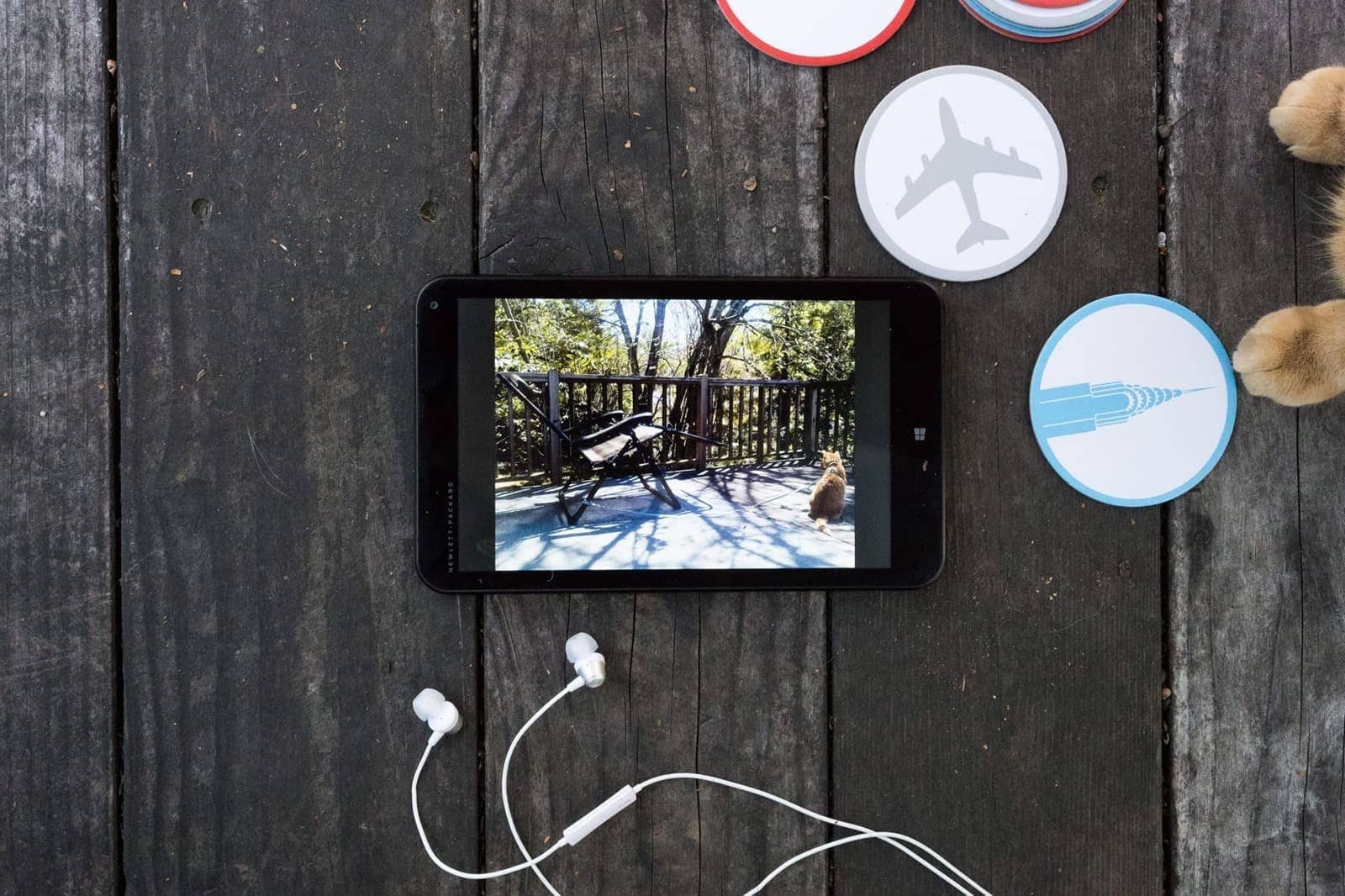
Depending on the country you’re visiting there will be different packages and providers available. We’re big fans of Three for visitors to the UK – their Pay as You Go SIMS are great value for visitors, and they can be picked up on arrival in many stores as well as airport kiosks.
If you are travelling from the USA, you can pick up a Three SIM card in advance of your trip here , which comes preloaded with data.
For full details on SIM cards for a wide range of countries across the globe, take a look at the Pre Paid Data SIM Card wiki site , which has all the advice you could ever need on the best SIM card options for the majority of countries in the world.
For short trips, or for trips where you are hopping across many countries, purchasing a SIM card everywhere you go might be more hassle than it is worth.
The exception is for travel in the EU – regulations introduced in June 2017 mean that providers can no longer charge for roaming in these countries, so a SIM card bought in one EU country should work across all other EU countries without additional charge.
Also be aware that some countries make it quite hard to purchase a SIM card, requiring you to have the equivalent of a social security number or other local government issued unique identifier in order to activate the service. In these countries, you’re probably better off investigating other options.
Advantages of buying a local SIM card : Buying a SIM card abroad will usually give you the fastest local speeds available at the most cost-effective price, and is a great option if you have an unlocked phone, and will be in the country for more than a day or two.
Disadvantages of buying a local SIM card : A local SIM card will take a bit of effort on your part to find, depending on the country you visit, and activation can sometimes be tricky. It also requires an unlocked handset to work. For short stays, or multiple country trips (excluding the EU), it’s probably not worth it. Also, when you take your home SIM card out, you won’t receive calls or texts to your home number.
3. Use a Mobile Hotspot
A mobile hotspot is a standalone device which connects to a cellular network for data, and creates a local WiFi hotspot that you can connect your devices to.
This lets you get all your devices online (handy if you have multiple people travelling together!), and means you don’t have to worry about unlocking your phone. Some even offer 5G speeds, meaning you’ll get super-fast speeds as well.
This is possibly the easiest way to get online when travelling. A mobile hotspot is also an option if you are trying to get online in an RV. Some mobile hotspots allow you to connect an external antenna to boost your signal, which you can mount on your RV for improved reception.
The downside to all this awesome is that for connecting a single device, a mobile hotspot will usually work out to be more expensive than the other options, and they don’t offer voice or text capabilities – just data. We would definitely advise checking with your carrier first to see if they offer data roaming packages for your phone, as these often work out cheaper if budget is a concern.
However, if data and ease of use is what you are after, and you have multiple devices that you want to connect (if you’re travelling as a couple or family for example), then these can be a cost effective and very easy to use option.
You have two main options for mobile hotspots. You can rent them for one-off trips, or you can buy one, and then pay as you go. We summarise these options below, and we also have a full guide to the best mobile hotspots for you to read if you are interested in one of these devices.
Option 1: Rent a mobile hotspot for travel
For rentals, prices vary depending on where you are travelling and how much data you want to use. In general you are looking at around $7 – $12 per day of travel for unlimited internet. Do check the terms and conditions on your rental though as many providers throttle speeds after a certain amount of usage each day (usually 1GB).
There are a number of providers we recommend you look at. Prices vary depending on the country or countries you are visiting, so we suggest taking a look at a few options before settling on one.
First, we recommend GlocalMe . They have a range of data plans supporting 4G speeds around the world, with prices starting from just over $5 a day.
Next up is TravelWiFi . They offer free delivery of their device to your home before you travel, as well as very competitive rates. For some countries you can pick up and drop off the device as well when you get to the destination, which can be convenient. These start at around $7 day for 4G.
We also have a discount code for TravelWifi, use discount code “findingtheuniverse” for a 5% discount on their prices. They also offer the option to purchase the device out right and then pay as you go for data.
Another option is mywebspot . They offer 4G data speeds in a number of countries around the world, with a daily fair usage policy of 1 GB in Europe and the USA, 2GB in Mexico, and unlimited 4G in SE Asia, Japan and China.
Prices for mywebspot are around $11 / day for fast 4G speeds, although this varies by destination, and they have a variety of ways you can get the device before your trip, many with free delivery.
Another option for visitors to Europe looking to rent a device is Hippocketwifi . They currently focus on Europe exclusively, and they have a number of competitive packages available, depending on how much data you need and for how long.
Speeds are at 4G, and prices start at around $7 a day if you rent for two weeks, with a 1GB data cap per day. They also offer more expensive unlimited plans. If you are just visiting France, they have a specific package at a very competitive price.
We have a discount code that will give you 5% off your Hippocketwifi rental – just enter coupon code “ TRAVELCATS5 ” at checkout in the coupon code section to claim.
Option 2: Buy a mobile hotspot for travel
If you think you are going to be taking a number of trips, or one longer trip, it will likely be more cost effective to buy a device that you can just add data to. This is also the case if you are planning on fitting a device with external antenna to an RV.
If you are looking to purchase a hotspot device for travel, prices for the device are generally in the region of $50 – $300. Prices vary, and some come with data.
First, we again recommend GlocalMe . They have a range of products, and we particularly like the GlocalMe DuoTurbo . This comes with a touchscreen and offers a range of reasonably priced data packages. You can also add your own SIM card if you prefer. This might be a better option for sporadic use where you want to pay as you go rather than by the day.
Another option to check out is My Webspot . They have a service where you can buy their device outright and get a pack of 20 1 day 4G passes (a value of around $220 at current prices). For regular users, this can be a good option. See that here .
There are also a number of other 4G wireless hotspots available, many of which you can add a local SIM to when you arrive in a destination.
We currently have and travel with this Netgear 4G capable wireless hotspot , which also works as a travel router and portable charger. Note that this doesn’t work with every SIM card in the world, so you will want to check with Netgear prior to travel to be sure.
Advantages of using a mobile hotspot: A mobile hotspot will let you connect multiple devices at high speeds, perfect for a family trip together.
Disadvantages of using a mobile hotspot: It’s another device to carry with you and keep charged. It’s also not the cheapest option. In addition, you obviously need to be in range of the hotspot for it to work, so if your group splits up this could cause issues!
4. Use a specialist roaming SIM
If your operator doesn’t offer good roaming prices and you don’t want the hassle of switching SIMs in and out of your phone as you travel, you might want to look into a solution that is designed for travellers – a travel SIM.
These can be a more expensive option than getting a local SIM card, depending on destination, but they can also be more convenient depending on your situation.
We have tried a few of these in our travels. We would recommend checking out Airalo , Alosim , Nomad , OneSim or Holafly . Which will be best for you will depend on your destination, duration of trip and how much data you require.
Generally, we have found Airalo offers some of the better deals although a lot will depend on where you are traveling and how much data you want.
Airalo (get $3 credit with code LAUREN8516 ) offers an eSIM solution. This is a virtual SIM card which is supported by many phones including recent Android and iPhone models. If your phone is compatible, an eSIM works in parallel with your existing SIM, so you can still receive texts or calls when abroad on your existing number.
Airalo has data packs for over 190 countries worldwide. You can pick up an eSIM for a single country, a region (i,e, Europe, Africa) or for global use. Just be aware the global SIM only covers around 90 countries, so you will want to check your destinations are on the list.
Airalo offers some of the better value SIM cards for travel, even compared to buying a local SIM, so this would be our first port of call if you have a supported phone model. An eSim also has the advantage that your current phone number will continue to work. This is helpful if you receive codes for things like online banking as it will save you swapping out SIM cards. See our full review of Airalo to see if it might be right for you.
Alternative eSIM providers to check out include Nomad (good for heavy data users) and Alosim .
Free credit for eSIMs
if you want to try out one of my recommended eSIM providers you can get free credit with the following codes:
- You can get $3 in free credit with Airalo if you use code LAUREN8516 when you sign up .
- You can get $3 in free credit with Nomad if you use code LAUR82DF when you sign up .
- You can get $3 in free credit with Alosim on your first data purchase (note purchase not sign up) with code: 5INUXOH
The OneSim prepaid international SIM card includes two phone numbers, as well as free incoming calls to an EU number in 162 countries. Mobile data is available from 1c/ MB, with bundles available offering up to 10GB of data.
They offer a universal sim card which can be used in over 200 countries, as well as an option that focuses on providing better value in Europe.
Like Airalo, Holafly offers an eSIM product. Holafly offers a range of data packages for destinations around the world. Their eSims can also be delivered instantly via e-mail, so you don’t have to wait for delivery if this is a last-minute purchase. Their pricing is reasonable for larger amounts of data.
Price Comparison
As a quick price comparison, here are some data packages. Prices are correct as of May 2022.
- UK, 10GB, 30 days. Airalo: $22.50. Holafly: $49. OneSIM: $200
- Europe, 10GB, 30 days. Airalo: $37. Holafly: $49. OneSIM: $200.
- USA, 10GB, 30 days. Airalo: $26. Holafly: $67 (20GB). OneSIM: $200
Of course, you will want to plug in your own information in terms of destination, duration and data required, but this should give you a rough idea of cost.
In my research Airalo most often comes up with the best value plan but this can vary. It’s also one of the few travel focused SIMs that is competitive even against buying a local SIM in some scenarios. You can also get a $3 credit with code LAUREN8516 when signing up for further savings.
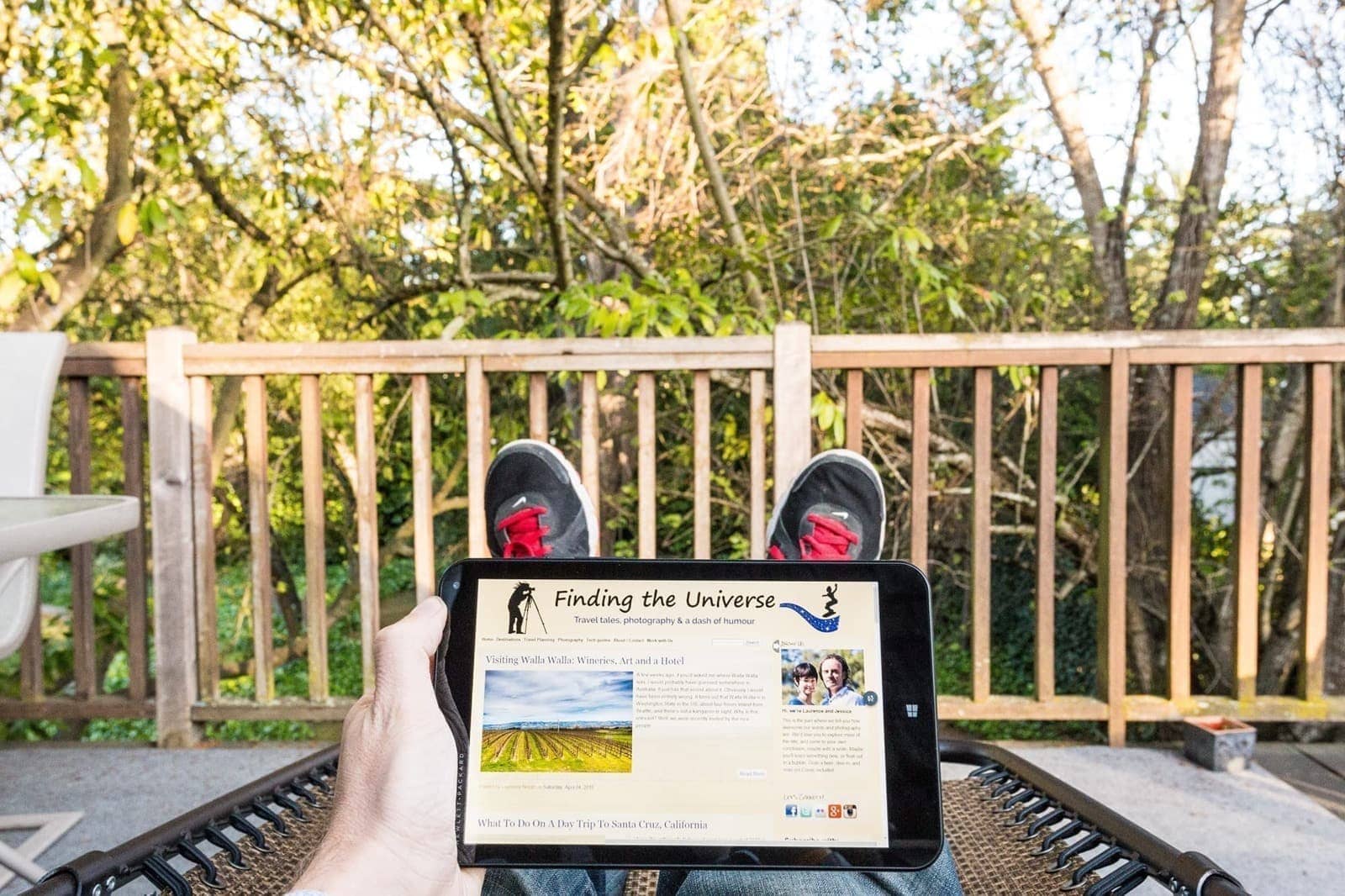
Advantages of using a specialist SIM: A specialist travel SIM is usually a really simple option that will let you get online quickly and easily at high speeds, without having to worry about roaming fees. It’s perfect for travelling across multiple countries, and will just work as soon as you arrive in the country. If you’re looking for the easiest option, this is likely it.
Disadvantages of using a specialist SIM: A specialist SIM can be one of the more expensive options for getting online, and requires an unlocked mobile. In the case of an eSIM, you will need a handset which supports eSIM technology.
5. Consider Satellite Internet
This option is primarily for those of you who are looking for options for getting online when traveling in an RV, boat or other type of transport which offers space for larger devices.
In this situation, you have a bit more choice. This is because you have access to more physical space as well as a power source. Your average traveler is unlikely to want to travel with a satellite dish in their luggage, but an RV or boat owner can easily afford the space for such a setup.
Whilst many RV owners use a mobile hotspot device, these are not without their downsides. The main downside is that they require cellular coverage to work, and many remote locations just don’t have cellular service. Whilst you can boost the signal with an external antenna, if there’s no signal to boost this won’t help!
This is also the case with boat owners, as the open sea tends to be without cell towers!
The other issue relating to cellular coverage is that in very popular locations the cell networks can overload. You will notice this if you ever attend a large event with tens of thousands of people – the internet will slow to a crawl or stop working altogether. As many people attend large events in their RVs, this problem also affects their mobile hotspots which use the cell network to send and receive data.
The solution to all this is a satellite internet connection. This consists of a satellite receiver that you normally mount on or near your RV, which points to a satellite in the sky. This provides the internet.
This gets around the issue of not having a signal, because satellites can cover a vast area. As long as you have a clear view of the sky, you should be able to get connected in most locations (although you’ll want to check coverage of your provider of course).
Currently, satellite usage is also not very common, so there is a low chance of the signal being overloaded.
The downside to satellite internet is that it tends to be one of the more expensive options. Some options can be slower as well. However, costs are coming down and speeds are going up, and more companies are rolling out satellite options. The availability of satellite providers will vary depending on your country. In the US for example, consider Starlink , HughesNet , Viasat and DISH .
Starlink is the standout option as it uses satellites which are closer to earth and thus is able to offer faster speeds and more data. It’s also relatively cost-effective compared to the other satellite options. They also have an RV specific satellite service which offers pay as you go monthly billing, and the ability to pause and resume the service when you want.
Just be aware that Starlink has proven very popular so depending on the service you choose and your location you might have to join a waiting list. The good news is that other companies, including Amazon, are due to launch competing services in the coming years.
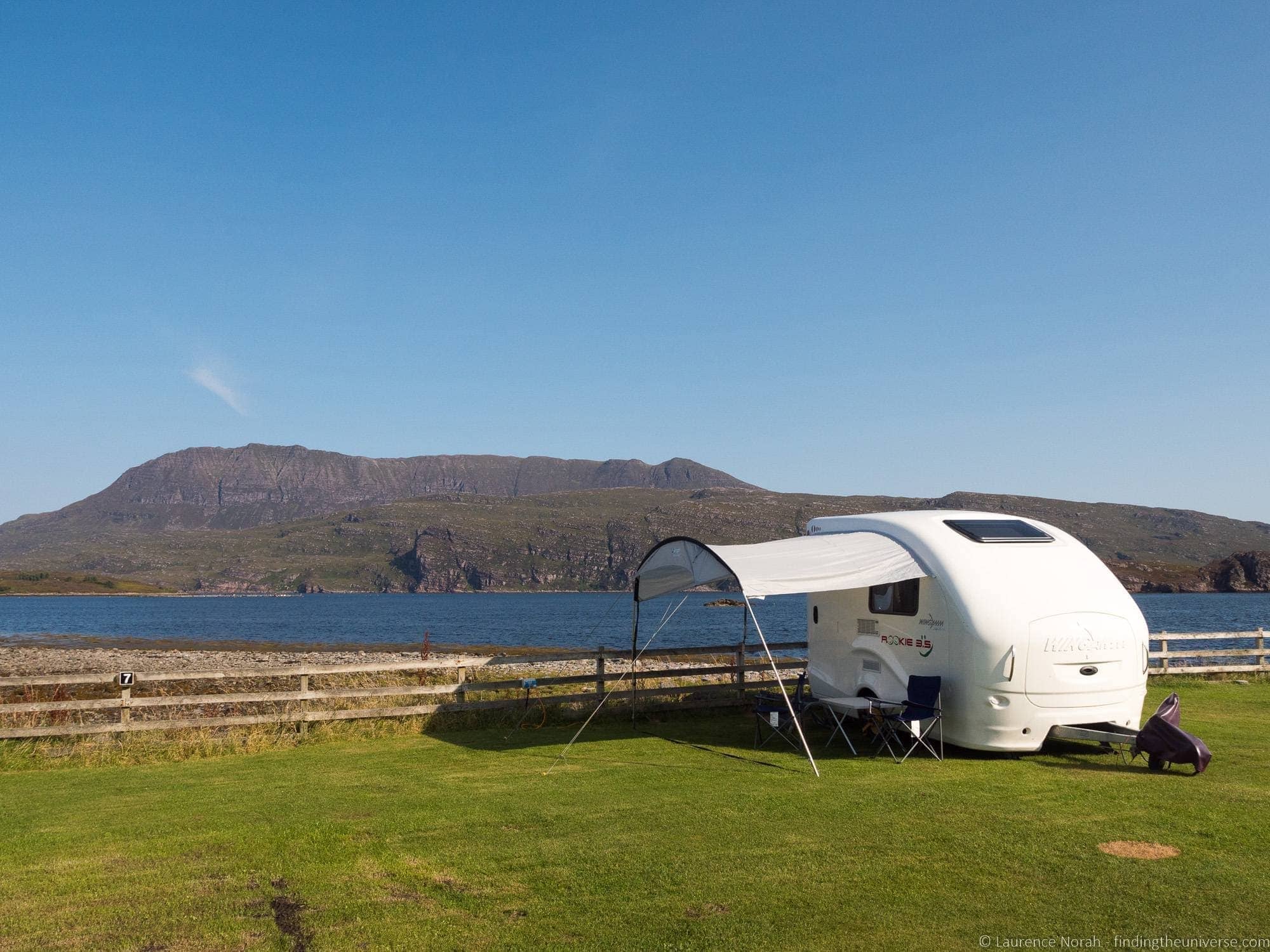
6. Just use WiFi for Internet Access
If all the above sounds like a lot of work, and you don’t think you really need to be online every minute of the day, then our suggestion would be just to use free WiFi networks as you go.
In many countries around the world you can find free WiFi all over the place. In the UK for example, most restaurants, bars, museums and many public spaces as well as public transport operators offer easy, hassle free connections.
The same can be said for the US and much of Europe. Reliable locations to find WiFi include McDonalds, Starbucks, and many others. Your hotel or lodging will nearly always include free WiFi as well – thankfully we’re almost past the days when hotels feel they can charge for WiFi access.

You might also want to consider investing in a wireless range extender, also known as a travel router. This is a small device that can boost a weak wireless signal, allowing you to connect your devices from further away to something like a hotel or coffee shop that you might not have been able to previously connect to.
We’ve done a round up of the best travel routers to give you an idea of what these devices do and how they work. Our current suggestion is the this TP-Link Travel Router , which is well reviewed and very cost effective.
A travel router can also be used at home, but if you are trying to improve your home WiFi, check out our guide to the best home WiFi routers as well.
Advantages of using WiFi: This definitely one of the easiest option for internet access when traveling, because all you have to do is disable your phones data roaming and then just find WiFi as you go. It’s also the cheapest option, and WiFi is usually faster than mobile data in many cases. If you don’t urgently need the internet at every waking moment, this is a great option.
Disdvantages of using WiFi: WiFi is not yet ubiquitous, so you won’t be online all the time. There are also some security risks to using unsecured wireless networks, so you are likely still going to have to pay for a VPN.
Summary of Best Options for Getting Online When Traveling
Here’s a quick summary of your main options for getting online when traveling:
- If your carrier supports data roaming, check out what packages are available and the prices in the country you are traveling to.
- If your phone is unlocked or supports eSIM technology, look at either purchasing a local SIM card or using a travel SIM service. In our experience, Airalo offers good value in the eSIM space.
- If you have multiple devices you want to connect, think about using a mobile hotspot . You can rent or buy these.
- If you are trying to get online in an RV, consider a satellite internet service like Starlink
- If you are not bothered about being always connected, save money by connecting to free WiFi hotspots when you travel
Don’t Forget the VPN!
However you choose to connect to the internet when travelling, we highly recommend you use a VPN to keep your data secure. This is especially the case when connecting to public WiFi networks, but it’s a good habit to get into regardless of how you connect to the internet.
You definitely don’t want your browsing data to be exploited as you browse, and a VPN will protect you from hackers looking to sniff out your sensitive data, from passwords to banking information.
We have a detailed guide to why you need a VPN and the best travel VPNs here . However, in brief, here are some VPN services we recommend you check out to keep your data safe when travelling.
- Private Internet Access – PIA offers one of the most competitively priced VPN services on the market, and have all the features you need from a VPN – lots of servers to choose from, support for streaming platforms, and support for all the main devices and operating systems on the market, from smartphones to laptops and tablets. Check them out here .
- NordVPN is o ne of the most highly reviewed and respected VPN services in the world . They offer competitive pricing, especially on their multi-year plans, and by connecting through their VPN software on your devices you’ll know your sensitive data is safe from prying eyes. We also have a NordVPN discount code . If you enter “travelcats” at checkout you can save 65% on the 2 year plan.
We definitely recommend investing in a VPN, either one of the above, or one you find yourself, to protect your data when travelling and browsing the web.

Further Reading
And that sums up our guide to getting online when traveling! As you can see, there are plenty of options for you, ranging from free through to more premium solutions.
The best option for you will vary depending on your destination country, budget, and number of people travelling, but certainly we believe that one of the options above will help you get online and avoid nasty bill shock when you get home!
We’ve also got a lot of other resources you might find useful, including the following.
- Depending on your travel plans, you might need a travel router. See our guide to travel routers to help you decide which is right for you.
- We also have a full guide to the best mobile hotspots for you to read if you are interested in one of these devices.
- Fast internet access at home is also important! See our guide to the best home wifi routers for improving your home internet speeds.
- Staying safe online when you travel is important. See our guide to the best travel VPNs for tips on keeping your personal data safe when you’re on the road.
- You’re going to need to power all your devices when you travel – see our guide to the best travel adapters
- If you are heading out onto the road and looking for a laptop to get some work done, see our guide to the best laptops for photo editing
- Thinking of buying a new camera? See our guide to the best cameras for travel
And that’s it! As always, if you have any feedback about the post, or questions for us, just pop them in the comments below and we’ll get back to you as soon as we can.
Enjoyed this post? Why not share it!
There are 26 comments on this post
Please scroll to the end to leave a comment
PATRICIA ANN GARLAND says
6th March 2023 at 1:00 am
Thanks so much for this info. I am technologically illiterate but I think I have a clearer picture of what I need for my trip to the UK. You provide such valuable info for someone like me.
Laurence Norah says
6th March 2023 at 3:54 pm
Thanks very much Patricia! If you have any questions about your trip, feel free to ask. Have a great time!
Gotheglobals says
31st October 2022 at 12:03 pm
Thank you for your outstanding article.
31st October 2022 at 2:37 pm
It’s my pleasure, I’m glad you found it helpful! Safe travels 🙂
Amy Saunders says
12th April 2022 at 1:58 am
Phew! You certainly managed to make me calm down the moment you specified that a mobile hotspot can be shared by numerous devices simultaneously, making it highly convenient. My son and his friends are going on a trip to Montana next weekend but they just received a last minute assignment which needs to be submitted online the day after the trip. I’ll make sure they’re aware about this option so they can select the right plan pretty soon.
12th April 2022 at 10:05 am
Thanks Amy, happy I was able to help, I hope your son has a great trip!
Chance Cook says
15th October 2021 at 4:18 pm
I’ll try and use my mobile provider for my trip. That way I don’t have to buy anything else. Well, unless they ask for me to pay more for out of Country service.
15th October 2021 at 4:24 pm
That is often the best option if they provide this as a service and it’s reasonably priced.
Bridgette says
8th September 2020 at 7:28 pm
Sorry, but other questions came to mind as I’m researching this topic. If I’m abroad, Europe or Asia and get a SIM card for that country for my unlocked phone for a month, would my personal data be protected if I’m not using WIFI? And if yes, then I would not need the use of a VPN? Also if I chose to get a SIM card for one family member in the group, then my husband or son can tether off me using my Mobile Hotspot? And would a VPN still be required for them?
9th September 2020 at 12:00 pm
Hi Bridgette,
No problem at all. So if you have an unlocked phone, then getting a local SIM will nearly always be the most cost effective way to get online. And yes, if you use that instead of WiFi your data will be much more secure because phone networks are much more secure than public WiFi. So a VPN is less necessary. In addition, if you get a SIM card you can then tether your other devices as you say, and as this is a secure local network that only your devices are accessing, again, a VPN isn’t really necessary either 🙂 You just need to be sure that the SIM card allows for tethering (most do, but worth checking).
Let me know if I can answer any more questions!
25th October 2020 at 2:14 pm
Hi Laurence and Jessica ,
This article is great and very informative. Specially for those who are traviling a lot. Any tips on how to make sure that when you are overseas you are using the free wifi and not your own data? There are some instances when the signal is weak my phone is auto switching to my data.
25th October 2020 at 2:47 pm
Thanks very much! So there are a few ways you can do this, depending on your phone.
On Android devices you can: – disable data roaming, so it won’t use data when the phone is not on your home network – enable airplane mode, which disables all the radios, and then just enable wifi – disable mobile data but leave wifi on
On iPhone you can do the same sort of thing. You can disable data roaming. You can also disable wi-fi assist, which will switch from WiFi to data if there’s a weak wifi signal.
Let me know if you need more detailed instructions – I’d need to know your device type to help further though 🙂
Taylor says
6th December 2019 at 5:58 pm
Thanks so much for this post. Sorry, but I’ve got a few techno-dunce questions for you. 1) if I got a “specialist SIM” would I need to worry about getting a VPN or would I be protected?
2) if I got a “specialist SIM,” would that mean I could get on the internet on my phone wherever I might be, in Europe?
3) With this specialist SIM, about how much does 1G give you? I don’t even know what “1G” means! So, for example, if I watched a YouTube video, would I burn through my daily allowance? Or checked email? Or streamed a movie?
Apologies for my lack of savvy and thanks in advance for any answers you’re willing to provide. I’m basically looking for something that will let me send occasional texts w/photos attached, back to the States, and to get on the internet during downtimes (like long bus rides). Thanks again.
7th December 2019 at 8:37 am
My pleasure 🙂 Let me try to help!
1 – While you are using the data on your phone through your SIM, you would be protected from most of the issues. However, if you switched to WiFi, which you might want to do to preserve your data allowance for something like streaming a movie, then you would likely want a VPN. Paying for a VPN and using free WiFi usually works out cheaper than buying data on a specialist SIM in the long run.
2 – Generally yes. In Europe especially, there are no roaming charges between EU countries. So as long as the provider you go for has service in the country you are in, and you have mobile reception, you should be good to go. However, if you are travelling to Europe I’d probably recommend buying a Pay as you go SIM instead of a specialist SIM. This will be a lot cheaper and give you much more data in most cases. If you are in the US and you have an unlocked phone, you can get one like this . If you are arriving in the UK, you can buy these from kiosks at most airports too.
3 – this is hard to quantify precisely, however streaming video is definitely the most data intensive task you can do. E-mail and web browsing will generally not use up much data, but as soon as you start watching video or backing up your photos (many phones do this automatically and it needs to be disabled) you can burn through your data quite quickly. In terms of data use specifically, a 1 hour Youtube video at 720p quality would use up around 0.9GB in one hour. A higher quality video, say 1080p, will use up 1.7G in an hour approximately.
I hope this helps!
8th December 2019 at 11:13 am
Thanks so much. Very helpful information!
8th December 2019 at 11:23 am
My pleasure – let me know if you have any more questions!
29th July 2019 at 6:42 am
I bought a knowroaming global SIM which worked fine in an iPhone (not tried in an android phone), but sadly does not work in the TPlink mobile 4G router I bought (currently visiting Canada).
Do you have any experience of using knowroaming SIMs on anything other than iPhone or Android?
29th July 2019 at 7:38 pm
Hey Matt – unfortunately I don’t, I’ve only ever used them in a phone rather than a data device. I’m not sure why they wouldn’t work, unless there is some odd band incompatibility – the best option would probably be to reach out directly to Knowroaming to see if they can help 🙂
24th May 2019 at 5:04 am
Hi, i have read several of your articles and the are great. Since we are going to spend 3 days in London and 9 more days in France, Italy and Amsterdam, which SIM would you recommend ? We think 1gb daily will be enough in our unlocked phones. Any advice will be appreciated!
24th May 2019 at 11:21 am
Thanks very much!
My suggestion for a SIM card would be Three. You can get 12GB of data for £20, which will also cover you in all the countries you are going to be visiting 🙂 You can get the Three SIM cards at many airports, as well as in Three stores across the UK.
Let me know if you have any questions!
8th May 2019 at 7:33 am
Thank you for this wonderful expose on traveling to access internet. It is very helpful.
8th May 2019 at 9:15 am
Our pleasure Jon, thanks for your kind comment 🙂
1st March 2019 at 10:03 am
Thank you guys for the tips, it was very useful. I am not a very technical person, so I am always struggling whit internet connection and similar stuff. My friend also recommended to get a NordVPN provider, so I am glad that you mentioned this app as well. It offers double encryption and works with Netflix, so for me it is more than enough.
1st March 2019 at 4:03 pm
Pleased we could help Jana!
Diana Maria says
9th August 2017 at 1:30 pm
A SIM card is always needed especially when I’m far like Europe! I try to use wifi and my phone when I feel the need to blog while traveling, but I love taking some time to disconnect and leave my phone at home while I explore. Lovely photos and tips! xx
Sending light & love your way.
Laurence says
9th August 2017 at 7:21 pm
I agree 🙂 Thanks for your comment!
Leave a Reply Cancel reply
Your email address will not be published. Required fields are marked *
Let me know when there's a reply to my comment (just replies to your comment, no other e-mails, we promise!)
Subscribe to our monthly Newsletter where we share our latest travel news and tips. This also makes you eligible to enter our monthly giveaways!
We only ask for your e-mail so we can verify you are human and if requested notify you of a reply. To do this, we store your data as outlined in our privacy policy . Your e-mail will not be published or used for any other reason other than those outlined above.
How to get internet when traveling
Reliable internet for travel is a must-have that you don’t want to leave home without. The last thing you want when you’re traveling abroad is to be lost wandering the streets of Rome at nightfall without access to Google Maps—will you really remember how to ask for directions in Italian? Probably not.
While you’re traveling, you can also use internet to find the best restaurants when you’re away from your hotel and check your pet cam to see how your cat is faring without you: all things you clearly can’t live without.
The good news is there are nearly endless options for getting internet service while traveling, but it does take some digging to find the one that’ll work best for you. Identifying the best option for your trip depends on how long you’ll be gone, how often you plan to use the internet, and where you’re going.
We’ve researched the three best options for common travel scenarios along with recommended providers for each, so you can check "internet" off your packing list and move on to the more exciting aspects of travel planning.
The best internet options for travel
Best overall: upgrade your phone plan.
- $5–$10/day or up to $100/mo.
- Upgrade on Verizon
- Upgrade on AT&T
- Upgrade on T-Mobile
Best for long-term travel: buy a SIM card
- $1–$5/day (depending on which country you visit)
- View Holafly Plans
- View Airalo Plans
Best portable hotspot: Rent pocket Wi-Fi
- Starts at $5/day (sometimes less if you rent in the country rather than before you leave)
- View TravelWifi Plans
- View GlocalMe Plans
Our three best options for internet while traveling are all portable—it’s important for your connection to be light and easy to transport. All of our recommended solutions are also on the more affordable end, but they can be scaled up in service quality and data quantity to meet your needs if price isn’t a priority for you. Understanding exactly what you plan to do with your connection and knowing where you’re going and how long you’ll be there will help you pick an internet solution that’s not too overpowered or underpowered for your needs.
Another thing to note is that our options are primarily geared toward international travel, although many of our solutions would still work for travel inside the US. If you’ll be traveling by RV or van, check out our guide on how to get internet in your RV to get more specific recommendations. And if you’ll be traveling domestically but don’t want to use your phone for internet, you can probably meet most of your internet needs with free Wi-Fi hotspots.
Are you traveling to Mexico or Canada? Every major cell provider (Verizon, T-Mobile, and AT&T ) already offers unlimited talk, text, and data in Canada and Mexico if you have an unlimited phone plan in the US. So if you plan to visit either of these countries, check your phone plan first. You might already be set.
Upgrade your phone plan
The fact that 60% of internet traffic happens on mobile devices (1) isn’t lost on the three major cell providers: if you’re always surfing the web on your phone at home, why should that be any different when you’re abroad—especially when your phone is also your camera? To meet this need, major providers offer simple and customizable solutions for upgrading your phone plan for traveling abroad.
We recommend this as the best option overall because it’s the most seamless. You won’t have to buy an additional device or SIM card, you can prep it ahead of time, and it’s easy to pay only for what you need. Plus, you’re already used to using your phone to look up everything anyway, so keeping that same resource available while you’re abroad is just one less thing to worry about. You can focus more on your trip and less on the logistics.
That said, this solution works best if you already have a phone plan with Verizon, T-Mobile, or AT&T. If you’re getting cell service through a mobile virtual network operator (MVNO) that doesn’t own its own infrastructure, like Cricket or Mint Mobile, the process of upgrading your phone plan to travel gets a little more difficult and expensive for the level of service you get in return.
As far as offerings for the three major carriers go, Verizon and AT&T both offer plans specifically for certain cruise and flight destinations. But for other travel, Verizon takes a more user-friendly approach through TravelPass , which is a super spiffy option to use your phone abroad exactly like you do at home. To get started, you simply text “TRAVEL” to 4004 and you’ll be set. Whenever you use your phone abroad, you’ll be charged $10 for the day. There’s no need to remove it once you get home either. It’s simply a feature you can use and pay for when you need it.
On T-Mobile, you’ll get built-in international roaming on every plan—the catch is your speeds will be slower than what you get in the US (the speeds are usually around 2G) unless you upgrade to a higher-tier plan. Not sure which upgrade option would be best for you? Each provider offers a walk-through guide where you enter where you’re traveling to and your current plan information, and then they tell you which upgrade would make the most sense.
Pros and cons of upgrading your phone plan
- Quick and easy to set up
- Pay only for what you need
- Use your phone just like you do at home
- No extra devices required
- Usually comes with unlimited data
- Keep your same phone number
- More expensive than buying a SIM card
- Not ideal if you don’t already have Verizon, AT&T, or T-Mobile
- Speeds are subject to signal availability where you’re traveling
Buy a SIM card
There are two types of SIM cards you can buy: local SIM cards that you purchase in the country you’re traveling to and eSIM cards that you can purchase in the US ahead of time. If you’re planning on traveling to one country and staying for a while, buy a local SIM card once you get there (just make sure you’re using an unlocked phone, which is a phone that’s not bound to a certain carrier). It’ll work just like a prepaid SIM card in the US—first, you’ll choose which carrier you want to buy the card from and then decide how much talk, text, and data you want on your card. Since it’s prepaid, you’ll just pay for what you want ahead of time rather than worrying about running up a hefty bill as you go.
This is by far the most affordable option, but it’s not worth the hassle if you don’t plan on staying for more than a week or will be hopping countries frequently. You’ll also want to investigate local laws in the country you’re traveling to before you bank on buying a local SIM card. Some countries are more stringent than others in what they require to give you a SIM card.
Learn more about SIM card availability and requirements in each country.
If you’d rather have your internet ready to go from the moment you land, go with an eSIM card. An eSIM card is basically just a built-in roaming data hotspot designed specifically for the country you’re traveling to, so you’ll have to buy multiple if you plan on hopping countries. But the convenient side of eSIM cards is that they don’t require you to change your phone number. They work digitally rather than physically.
Furthermore, eSIM cards are based in the US, so you won’t be able to make local calls within the country you’re visiting like you would if you bought a local SIM card for your phone. Once you sign up for an eSIM card, you’ll just scan a QR card to install it, and then you’ll be ready to roll. If you’re planning on visiting multiple countries in one trip, you can buy several eSIM cards (one for each country) ahead of time and then just activate them via QR code as you progress through your travels.
Best eSIM card providers
- Editor's choice: Holafly
- Runner-up: Airalo
Pros and cons of SIM cards
- Cheapest option overall
- Gets you the max speeds available in the country (roaming plans don’t get the same priority data)
- Can set up service ahead of time
- Know how much you’ll spend on data since it’s prepaid
- Need an unlocked phone for local SIM cards
- A hassle when hopping countries
- Service is dependent on local availability
- Some countries require personal identification numbers to get SIM cards
Rent pocket Wi-Fi
Similar to SIM cards, renting pocket Wi-Fi is something you can do in the US or when you arrive in the country you’re visiting. You can often get the best rates if you rent Wi-Fi after you get to your destination, but it’s easier to do this in some countries than others. Countries like Japan have pocket Wi-Fi widely available in vending machines, but that’s not the case in a lot of other countries.
If you opt to rent your pocket Wi-Fi via vending machine or through another retailer, you’ll need to drop off the device once you’re done. Many pocket Wi-Fi providers offer drop-offs at airports or other convenient locations. But if you don’t have access to a drop-off point, you can always mail it back yourself. Just know that if you don’t return your device within the return window (usually around 2 days after your rental ends), you’ll be charged an extra fee.

If you plan on traveling to multiple countries in one trip, it would make more sense to get your pocket Wi-Fi ahead of time rather than finding a new source of pocket Wi-Fi in each country you go to. The two best pocket Wi-Fi providers that we recommend both offer hotspots that work seamlessly across multiple countries.
Portable hotspots are also great for travelers who need to connect multiple devices to one connection. So, if you’re traveling as a family or group and everyone wants to post to Instagram at the end of the day, using a portable hotspot is a more affordable option than upgrading everyone’s phone plan—although there will be less speed and data available. Portable hotspots are also ideal for people who plan on working internationally because they can serve as a Wi-Fi network for your laptop.
Although pocket Wi-Fi is highly convenient, it’s not quite as convenient as just having everything working from your phone. Creating a hotspot from your phone is possible, too, if you have it included in your plan. Carrying around a pocket hotspot means you’ll have one more device to keep track of and charge, and you’ll have to pay more money for the level of service you’ll get in return.
Best pocket Wi-Fi rental providers
- Editor's choice: TravelWiFi
- Runner-up: GlocalMe
Pros and cons of pocket Wi-Fi
- Longer battery life than your phone
- Works across 140+ countries
- Good options for groups of people who want to share a connection
- Highly portable
- Great for connecting additional devices, like laptops or gaming systems
- Lower data limits with slowed speeds once you hit the threshold
- More expensive for what you get
- Adds another gadget to your gear rather than just working from your phone
Tips on internet for travel
No matter which internet option you choose, you should always use a VPN (virtual private network) when using the internet away from home. Using a VPN can slow down your connection slightly, so it might be tricky if you’re on a connection that’s already barely getting by. But the extra layer of privacy and security is worth it—especially if you plan on accessing public or free Wi-Fi. You’ll also want to check the local VPN laws in the country you’re traveling to—some countries are stricter than others, and you don’t want to get in trouble on your vacation. Learn more about VPNs and why they’re important .
Use free Wi-Fi wherever you can
Even if you are paying for an internet plan while you travel, it’s not a bad idea to use free Wi-Fi options as often as you can to save on data and costs. You can make your money and your data go farther if you connect to free Wi-Fi whenever you’re back at the hotel or hostel or hanging out at a restaurant or cafe with a free network. Nowadays it’s standard practice for hotels (and even hostels and Airbnb rentals) to offer free Wi-Fi, but the speeds are always a bit of a gamble. If the Wi-Fi where you’re staying is sporadic, you can always trust the global franchises of McDonald’s and Starbucks to get you online. Both are available worldwide and both are known for their above-average free Wi-Fi.
Buy a portable charger
Whether you choose to use your phone as your primary source of internet or buy pocket Wi-Fi, it’s a fact that you’ll be burning through battery power quickly. Even the most proactive traveler can get caught in a snag if the sun saps your battery or if you spend more time hunting down your next museum than you expected. Keeping a portable charger on hand will be one more thing to carry around, but you won’t regret it. You’ll also need to bring a power converter for the country you’re traveling to—otherwise your portable charger won’t be of much use to you. Having both of these items on hand will add a lot of peace of mind, and they’ll definitely come in clutch once, twice, or more likely every single day of your trip.

Cara Haynes has been writing and editing about internet service and TV for six years. Previous to contributing to Helpful, she worked on HighSpeedInternet.com and SatelliteInternet.com. She graduated with a BA in English and a minor in editing from Brigham Young University. She believes no one should feel lost in internet land and that a good internet connection significantly extends your lifespan.
Bri Field has a background in academia, research writing, and brand marketing. She has edited scientific publications, conference papers, digital content, and technical communications. As Assigning Editor, she enjoys ensuring all content is accurate, clear, and helpful. In her free time, you can find her in the kitchen trying a new recipe, out on a hike, or working through her massive TBR list.
Endnotes and sources
1. “ Desktop vs. Mobile Market Share Worldwide ,” Statcounter. Accessed 27 January, 2023
As an Amazon Associate, Switchful.com may earn commissions from qualifying purchases.
- Compare Providers
- Review Providers
How to Get High-Speed Wi-Fi While Traveling
- Connectivity for multiple users
- High price for mobile data
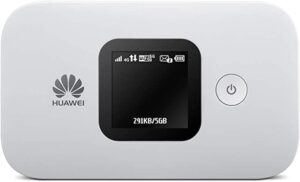
- Affordable prices
- Flexible plan options
- Complicated setup

- Cheap prices (or free)
- Wide availability in big cities
- Slow speeds
- Working connection on the road
- Affordable prices for plans
- Safety risks (don’t Wi-Fi and drive!)

- Reliable connection in rural areas
- Unlimited data on most plans
- Extremely high prices
There are a bunch of ways you can get high-speed Wi-Fi while you’re traveling. A mobile hotspot is the easiest and most reliable option, giving you Wi-Fi access for multiple devices whether you’re on a long drive, staying at a vacation home, or even traveling abroad. Hotels and restaurants also often have free Wi-Fi for customers, while other ways to get portable Wi-Fi include built-in car hotspots and fixed wireless internet plans for RVs.
Below we take a deep dive into all your pocket Wi-Fi options for when you’re traveling. Take a look to find the best way to stay connected on your next trip.
Best ways to get Wi-Fi while traveling:
- Best for short trips — Phones and mobile hotspots
- Best for traveling internationally — Travel hotspots and SIM cards
- Best for budget travelers — Hotel or restaurant Wi-Fi
- Best for road trips — Your car’s built-in hotspot
- Best for RVs and digital nomads — Portable 4G or satellite internet
Best for short trips: Phones and mobile hotspots
A hotspot—whether it’s the one on your phone or a separate mobile device—is the easiest and quickest tool you can use to get Wi-Fi while traveling. As long as you have a data plan and network coverage where you’re traveling, all you need to do is switch on the Wi-Fi hotspot to provide internet access for multiple laptops, tablets, and phones.
Your phone’s hotspot works great for lots of situations, and most phone plans come with hotspot data, so using one doesn’t tax your wallet.
But we recommend investing in a standalone mobile hotspot if you need Wi-Fi for multiple users or extended periods—for example, if you’re taking a few hours to get work done at your vacation home. Mobile hotspots have longer range than a phone hotspot, they connect more devices, and they don’t strain your phone’s battery.
- Limited speeds depending on the hotspot
- Unreliable service in some places
Best mobile hotspots
Data as of 7/11/22. Offers and availability may vary by location and are subject to change. Amazon.com Price as of 7/11/22 10:30 MST. See full disclaimer .
T-Mobile’s Inseego 5G MiFi M2000 is the most formidable mobile hotspot out there, delivering excellent speeds over T-Mobile’s 4G LTE and 5G networks. It can connect up to 30 devices—making it an excellent option for big groups—and comes with security features to set up guest networks and firewalls. T-Mobile also has the best prices on data plans, offering lots of flexibility for whenever you need it.
Keep in mind that you need a data plan to make your hotspot work. Look at our hotspot data plans guide for details on the best (and cheapest) monthly and prepaid options.
Best phone plans for hotspotting
*With AutoPay. Regularly $60/mo.
** 5G coverage not available everywhere. Requires compatible device/service. Other terms and restr’s apply. Data charges may apply.
Data as of 07/26/2024. Offers and availability may vary by location and are subject to change.
Almost any phone plan gives you hotspot data nowadays, and if you don’t have data, then you can likely add hotspotting for a modest fee. You don’t really need to pick out a cell phone plan just for the hotspot data.
But if you’re in the market, you can’t go wrong with AT&T’s flagship Unlimited Premium plan, which gives you the most hotspot data for your dollar. T-Mobile’s Magenta MAX plan also has a generous offer on hotspot data (albeit you get 10 GB less than the AT&T plan). Verizon’s 5G Do More plan comes with the least amount of data, but it includes a discount for a separate hotspot plan.
Best for traveling internationally: Travel hotspots and international SIM cards
The easiest and cheapest way to get internet abroad is to stick to hotel and restaurant Wi-Fi. But if you really need internet while abroad—for example, if you’re working remotely or need to make regular Zoom calls to family back home—we recommend getting a SIM card from a local phone carrier in the country you’re visiting.
Setup can be tricky, especially if you’re in a place where you don’t speak the language: you have to go to a phone store to buy a SIM card and set up an account, which usually requires you to show your passport and sign some paperwork. But these inconveniences are a small price to pay. Many countries have cheap options for phone plans and data, and getting a SIM card is often affordable.
- Affordable prices (many countries have low-cost cellular plans)
- Time-consuming and potentially stressful setup
- Limited connectivity if you’re traveling in multiple countries
Best travel hotspots
Amazon.com Price (as of 7/11/22 10:15 MST). See full disclaimer .
Huawei’s E5577Cs-321 may not have the prettiest name, but it’s a handy device. The 4G hotspot is compatible with providers across Europe, Asia, the Middle East, and Africa, so you can swap in a SIM card and get the Wi-Fi flowing (almost) wherever you go.
GlocalMe G4 Pro is another interesting option. It doesn’t require a SIM card; instead, GlocalMe has its own data plans, which provide coverage in more than 140 countries, according to the manufacturer.
We’re hesitant to recommend devices in general like these because you have no way of knowing how well the hotspot actually works (if at all) until you’ve already bought the thing and gone on your trip. But the G4 Pro gets good reviews online, it’s easy to handle, and it comes with a pre-installed Google Maps app to help out in case you get lost.
Best for budget travelers: Hotel and restaurant Wi-Fi
Nothing beats hotel Wi-Fi, am I right? Most hotels and restaurants nowadays offer free Wi-Fi with their services, and anyone who’s ever spent a long layover in Paris or Istanbul knows how convenient free Wi-Fi can be.
Traveling on a budget? Go ahead and skip all the fancy stuff; don’t worry about adjusting your phone plan or buying a pricey hotspot. Just stick to the free Wi-Fi at your hotel or a nearby restaurant.
See below for a list of places where you can find public Wi-Fi (including lots of free options). And consider investing in a travel router and VPN to boost your signal range and increase browser security.
- Cheap price (included with a hotel room or drink)
- Limited availability in rural areas
- Higher security risk
Where to find free Wi-Fi
- Restaurants
- Coffee shops
- Public libraries
- Government buildings
- University campuses
- Airport terminals
- Public parks
Popular restaurant and retail chains with free Wi-Fi:
- Burger King
- Lowe’s Home Improvement
- Dunkin’ (formerly Dunkin’ Donuts)
- Peet’s Coffee
- Coffee Bean and Tea Leaf
- Tim Hortons
- Panera Bread
Use a travel router to give your travel Wi-Fi a boost
A travel router is a small device that improves your connection and increases your security while you’re plugged into a public Wi-Fi network.
It lets you set up a private network using an Ethernet connection from a public hotspot. So if you’re at a hotel, you can plug the travel router into a hotel-provided internet access point like an Ethernet switch or hub. When you run the Wi-Fi through your travel router, it lets you bypass encryption and firewalls, connect more devices, and increase your signal range.
Best travel router
Best for road trips: car wi-fi and built-in hotspots.
Many newer vehicles—especially deluxe models and family sedans—have onboard Wi-Fi hotspots that give you internet access on the go.
We definitely don’t recommend using Wi-Fi while you’re driving a car. But so long as you’re safely paying attention to the road, an in-car hotspot is great because it lets your friends and family enjoy Wi-Fi access on long drives and road trips to watch movies, play games, and even get work done if necessary.
Take a look at our guide to car Wi-Fi for details on how to set up a hotspot in your vehicle.
Best car internet plans
Data as of 9/6/22. Offers and availability may vary by location and are subject to change.
Many cars with built-in Wi-Fi hotspots need a data plan from AT&T. Prices and features vary based on the make and model of your vehicle, but expect to pay around $15 to $25 per month for a data plan. Some cars let you get data through Verizon or T-Mobile—namely Volkswagens and vehicles that use T-Mobile’s SyncUP DRIVE system.
- Working connection even while driving
- Affordable prices for Wi-Fi plans
- Safety risk—don’t use Wi-Fi while driving!
Best for digital nomads: Portable 4G LTE or satellite internet
RVs and Sprinter vans typically have built-in systems for utilities like water and gas, but if you’re living on the road then you need to figure out a separate system for the Wi-Fi. Mobile hotspots and Wi-Fi extenders are excellent and affordable tools to get you internet in many places, but both come with technical limitations and aren’t adequate replacements for a proper home internet network.
A 4G LTE or satellite internet plan gives you a consistent connection for wherever you travel. 4G internet is already a popular choice for rural areas, and these plans work as mobile connections that can be set up anywhere. Setup and billing costs can really add up with these plans, but the benefits include sturdier equipment and unlimited data.
Best 4G LTE and satellite internet plans
Data as of 7/1/24. Offers and availability may vary by location and are subject to change.
Nomad Internet is one of the best choices for RVs because its portable 4G internet plan doesn’t have a data cap. Hotspots don’t give you enough data to let you stream movies, make video calls, or work remotely for more than just a weekend or two, so having unlimited data makes a huge difference when you’re living out of a vehicle full time.
- Great setup for RVs
- Challenging setup with potential technical issues
- Expensive price
Our verdict
When it comes down to it, a mobile hotspot is the best way to get pocket Wi-Fi on the road. Hotspots are affordable, easy to use, and compatible both in the United States and overseas (so long as you have one certified to do so). Even your phone’s hotspot and a SIM card with a data plan works wonders in many cases.
If you’re worried about costs, remember you can often find a restaurant or hotel with free Wi-Fi, especially in major cities and tourist areas. For living out of an RV, though, you’re better off with a portable 4G LTE or satellite internet plan, which offers you more consistent connections even in rural areas.
FAQ about getting Wi-Fi while traveling
Does portable wi-fi work with a sim card.
Yes, you can get a SIM card to get portable Wi-Fi. You can sign up for a data plan from a cellular carrier in the area where you’re traveling and install the SIM card into your phone or a mobile hotspot to get Wi-Fi access on multiple devices.
How much does portable Wi-Fi cost?
Portable Wi-Fi ranges in price but usually costs $25 to $60 per month. Your phone plan or hotspot plan gives you enough data to support portable Wi-Fi for a range of devices and usually comes at an affordable price—although you may have strict limits on data use.
Related content
- Best Ways to Get Portable Internet
- How to Get Wi-Fi While Camping
- Internet for RVs
- Best Unlimited Hotspot Plans
Amazon.com Prices as of 9/6/22 10:15 MST. Product prices and availability are accurate as of the date/time indicated and are subject to change. Any price and availability information displayed on Amazon.com at the time of purchase will apply to the purchase of this product. Highspeedinternet.com utilizes paid Amazon links.
CERTAIN CONTENT THAT APPEARS ON THIS SITE COMES FROM AMAZON. THIS CONTENT IS PROVIDED ‘AS IS’ AND IS SUBJECT TO CHANGE OR REMOVAL AT ANY TIME.
Starbucks’ logo is a registered trademark of Starbucks. Starbucks is not compensated or affiliated with this review or Clearlink in any way.
Author - Peter Holslin
Peter Holslin has more than a decade of experience working as a writer and freelance journalist. He graduated with a BA in liberal arts and journalism from New York City’s The New School University in 2008 and went on to contribute to publications like Rolling Stone, VICE, BuzzFeed, and countless others. At HighSpeedInternet.com, he focuses on covering 5G, nerding out about frequency bands and virtual RAN, and producing reviews on emerging services like 5G home internet. He also writes about internet providers and packages, hotspots, VPNs, and Wi-Fi troubleshooting.
Editor - Rebecca Lee Armstrong
Rebecca Lee Armstrong has more than six years of experience writing about tech and the internet, with a specialty in hands-on testing. She started writing tech product and service reviews while finishing her BFA in creative writing at the University of Evansville and has found her niche writing about home networking, routers, and internet access at HighSpeedInternet.com. Her work has also been featured on Top Ten Reviews, MacSources, Windows Central, Android Central, Best Company, TechnoFAQ, and iMore.
Related Posts


How to Connect to the Internet Abroad in 2024
January 13, 2023
Vera Andrews
An up to date guide on how to connect to the internet abroad.
Your Options For Wifi Abroad
Even when travelling, you need the internet. It’s useful for maps, social media, restaurant recommendations, online tickets, and staying in touch with your family, friends, or co-workers.
Luckily, the era when you would go home to a giant bill is over, and with the new Wi-Fi choices, you can know from the start how much you will pay.
Here are some of the main options you can choose from when looking for wifi on the road. For more detailed information and to compare different options, check out Roami and work out the best way of getting online abroad for you.
An International eSIM or Travel eSIM
One of the simplest ways to reduce internet and mobile costs is to switch to a local carrier. In the past, the only option you had was to buy a prepaid SIM when you arrived at your destination, insert it into your smartphone, and start using the new services.
Today, things are a lot easier with international eSIMs, which are available online. You no longer need to deal with a physical SIM as the eSIM is already built into your device. Instead, you will create an eSIM profile, usually after scanning the QR code provided by the vendor. In just a few minutes, your eSIM for travel will be ready.
One of the biggest advantages offered by eSIMs is that they allow you to store different data plans for different countries. This makes them perfect for travellers hitting multiple destinations, as they can switch from one network provider to another to benefit from the best tariffs.
Moreover, you can store up to 8 eSIMs in your phone, so you can stay in touch with both your loved ones and co-workers through different eSIM providers.
With eSIMs, all your information is stored in a cloud, so if you get your mobile phone stolen or if you lose it, you will still be able to access the phone numbers on your eSIM. This can be a lifeline if you need to meet people or make arrangements at short notice.
However, if your phone stops working, it is more challenging to transfer everything to a new one than with a traditional international SIM card that allows you to swap phones in a minute.
Starting with iPhone 11, all Apple smartphones are compatible with eSIMs, and many Android phones accept them. However, always check if your device works with this option before purchasing one.
A Prepaid SIM Card
A prepaid local SIM card remains one of the most accessible alternatives for mobile internet when your phone doesn’t support an eSIM. Prepaid SIMs are sold at many cellular operator stores and retail stores, and you can almost always find one at the airport.
Once you swap your old SIM with the new one, you can use the new plan that offers you access to the internet, SMS, and calls through one of the local operators. It’s as simple as that.
The disadvantage that comes with a regular SIM is that, unless you have a dual-sim phone, you won’t be able to keep your regular SIM in use. If you have a lot of friends or people at work who will try to reach you while abroad, you need to text them your new contact info, and this can take time.
Important: Check that your phone is unlocked, allowing you to use other SIM cards except the ones provided by your operator. Otherwise, the new SIM card won’t work.
Pocket Wi-Fi
If you need a reliable internet connection and good internet speed, a pocket Wi-Fi, also known as MiFi, mobile hotspot, or internet dongle, is an excellent choice. You can pair this mobile router with a local prepaid SIM to enjoy optimal download and upload speeds on your smartphone without removing your regular SIM. Since you will be carrying it in your pocket, it offers good signal strength and can be a reliable internet option for road trips when you need to keep the maps updated.
Pocket Wi-Fi is usually a more expensive internet option – you don’t pay only for the internet services but for renting the device as well. Some vendors will ship it to you before you start your trip, so shipping taxes are added to the final cost. Also, for some travellers, always checking that they are carrying the device can soon become bothersome. On the plus side, up to four people can join the same mobile device, so it can be useful if you’re travelling as a group.
International Roaming
For many years, international roaming was one of the best alternatives for people travelling abroad, and it remains a good option for those looking to use the same phone number. Often, local carriers offer good roaming plans that include internet access, calls, and SMS for a reasonable price, but it is a good idea to double-check how much it will cost you depending on your destination. Also, consider that some plans come with mobile data caps, which means you will be charged more if you exceed the data limit they impose. And, beware! Some mobile phone providers charge extortionate amounts for data or phone calls and your phone can be churning through data in the background without your realising.
Public Wi-Fi
If your budget is tight, you can resort to public Wi-Fi, but you must consider from the beginning that this option is not without risks.
The great thing about a free wireless network is that you don’t need to pay a penny to access the internet and get in touch with your friends or upload your latest photos on social media.
The not-so-great thing is that hackers can insert themselves between your phone and the network to gain access to your data, including your bank details, credit card numbers, personal info, passwords, and private emails.
The more common problem is that the wifi doesn’t work properly or there simply isn’t any. While many airports, coffee shops and restaurants offer wifi, many don’t and those that do often charge a fee.

Living the Nomad Life? Check Out the Most Popular Campervan Wi-Fi Options
Travellers and digital nomads who prefer campervans know that keeping everyone connected to the internet in an RV is not always easy or cheap. Yet, there are a few motorhome Wi-Fi options that can provide internet for multiple devices while on the road:
- A pocket Wi-Fi or Mi-Fi device – works with a SIM card and allows you to connect multiple devices to it. You can use a Wi-Fi booster device to extend its coverage area and have good Wi-Fi in any spot of the RV.
- A personal Wi-Fi hotspot – turn your smartphone into a Wi-Fi hotspot and connect the devices that need internet to it. It can function as a temporary solution as keeping the hotspot function on all the time quickly runs through your mobile phone’s battery. Unless you are planning on using it as a permanent router, you will want to find something else.
- Satellite internet – if you will be travelling extensively through only one country, you can consider buying a satellite antenna and attaching it to your camper. You will enjoy steady internet even in the more remote areas at a very reasonable price. The only downside is that you will need to buy or rent the external antenna, and this adds an extra cost.
See also our article on the best campervan accessories for your next trip here.
Advertiser Disclosure
Many of the credit card offers that appear on this site are from credit card companies from which we receive financial compensation. This compensation may impact how and where products appear on this site (including, for example, the order in which they appear). However, the credit card information that we publish has been written and evaluated by experts who know these products inside out. We only recommend products we either use ourselves or endorse. This site does not include all credit card companies or all available credit card offers that are on the market. See our advertising policy here where we list advertisers that we work with, and how we make money. You can also review our credit card rating methodology .
The 7 Best Portable and Mobile Wi-Fi Hotspots for Travel in 2024
Amar Hussain
Senior Content Contributor
823 Published Articles
Countries Visited: 63 U.S. States Visited: 9
Keri Stooksbury
Editor-in-Chief
41 Published Articles 3364 Edited Articles
Countries Visited: 50 U.S. States Visited: 28
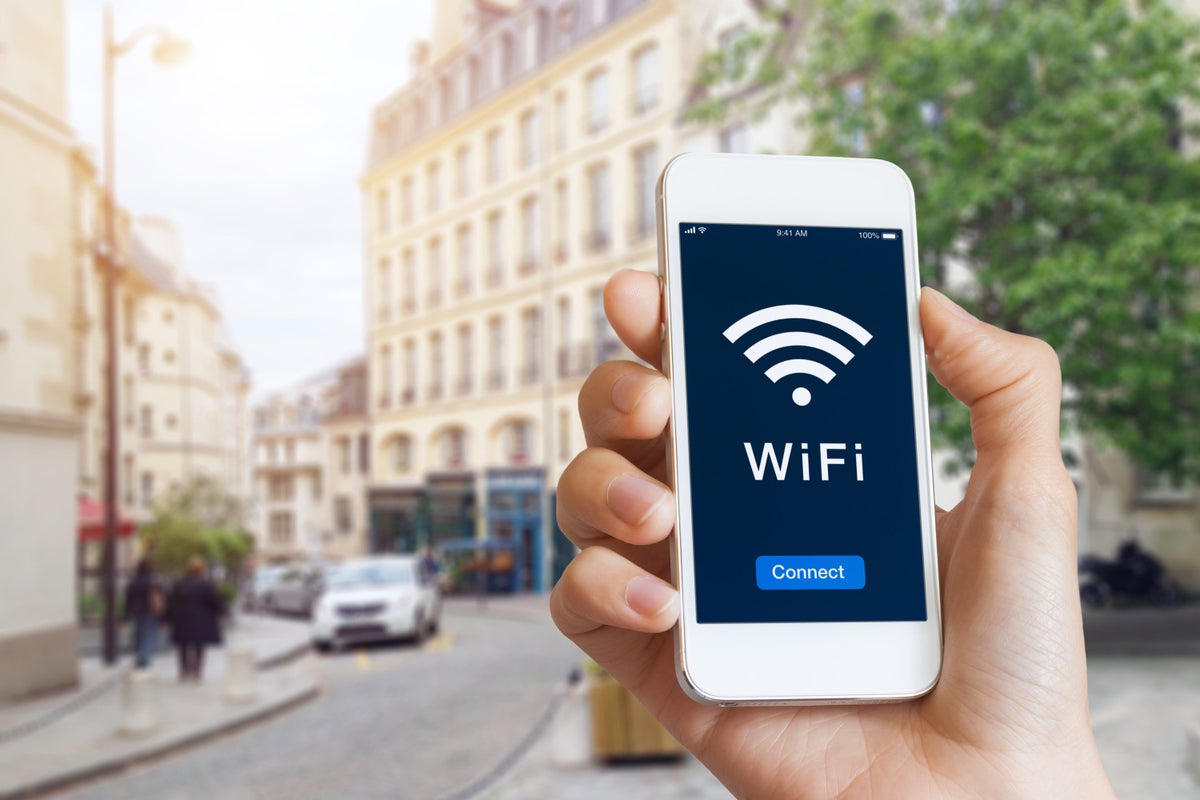
Table of Contents
What is a mobile wi-fi hotspot, things to look for in a mobile wi-fi hotspot, frequencies explained: the difference between gsm and cdma, the 7 best mobile wi-fi hotspots for travel, final thoughts.
We may be compensated when you click on product links, such as credit cards, from one or more of our advertising partners. Terms apply to the offers below. See our Advertising Policy for more about our partners, how we make money, and our rating methodology. Opinions and recommendations are ours alone.
Whether you want to update your Insta on the go or need to keep in touch with the office, losing your internet signal can be very frustrating.
But it’s annoying (and can be unsafe) to rely on public Wi-Fi signals in every coffee shop you visit, and sometimes when traveling to remote locations, public connections are just not available.
Instead, you can invest in a mobile Wi-Fi hotspot to ensure safe, secure, and reliable internet access anywhere you go. Here’s what you need to consider when choosing the best one for you.
A Wi-Fi hotspot is a battery-powered wireless router that travels with you. Designed to be compact and lightweight enough to slip into your purse or pocket, a mobile Wi-Fi hotspot device brings the internet to your phone, tablet, or laptop, no matter where in the world it finds you.
These gadgets are a big bonus for anyone traveling away from public Wi-Fi or those looking for a secure connection. A bit like a cellular device, your Wi-Fi hotspot provides access to invisible signals in the sky, all of which can help you to upload pics or receive your emails on the move.
You will need to pay for the data you use, which can be done in the form of packages or day passes that offer unlimited access for a set period of time.
Bottom Line: Using 3G or 4G (and maybe even 5G in the coming months), these smart little devices emit a reliable and incredibly useful Wi-Fi signal that you can hook your favorite gadgets and devices to while away from home.
Battery Life
Most batteries will run happily for between 5-6 hours at a time. If you are traveling somewhere with easy access to electricity, you should be able to charge overnight to ensure your hotspot works when you need it for your daily adventures. If you spend a disproportionately large amount of time online, you may want to look at a device that offers a longer battery life.
Size and Weight
Your Wi-Fi hotspot should be small enough to be carried everywhere with you. After all, if it’s not entirely portable, what exactly is the point? Slimline, lightweight, and often smaller than the smartphone you are trying to connect to, these devices are compact and clever.
Wi-Fi Support
Because some mobile internet providers are better than others, the coverage you receive from any Wi-Fi hotspot can also vary. For example, 2.4GHz gives coverage at a more extended range but will transmit the data at a much slower speed. A 5GHz band, on the other hand, will provide less range with data transmitted at a much faster speed.
Though they may be small, they are still mighty, and most hotspot devices will have a built-in display. At the very least, the display should indicate remaining battery life and current Wi-Fi signal strength. Others may offer bonus features like SMS messages or touch screen modes.
Card Reader
Some portable Wi-Fi hotspots come with the capability to read MicroSD memory cards, which can be used to store and access files from your laptop or home computer. You can also share your stored files with the people who use your network when you want them to have access.
MicroSD memory cards are not typically included with the purchase of a Wi-Fi hotspot, but they are a useful addition that allows you to send and receive SMS messages and save images, music, and other data-heavy files.
Mobile data is delivered using 1 of 2 types of cellular signals in different countries and regions around the world. These cellular standards allow for communication between individuals; without them, we would not be able to keep in touch on such a global scale.
Known as GSM and CDMA, each standard converts both incoming and outgoing radio waves in entirely different ways. Before you buy a hotspot, you need to understand its function and where you’ll be able to use it.
Global System for Mobile Communication is used in most countries around the world. In the U.S., only AT&T and T-Mobile use GSM. GSM uses Time Division Multiple Access (or TDMA), which allocates time slots to multiple conversation streams and alters how phones transmit their information. Doing this requires a SIM card (or “subscriber identification module” card).
It is the SIM card that holds all the information you need to make calls, use mobile internet, and store your contacts. The SIM card tells the device what services you have access to and is vital for GSM communications on the go.
CDMA is used in countries including Russia and the U.S. ( Sprint , Verizon , and US Cellular), and it grants users full access to a wide spectrum of bandwidth, meaning more users can connect at any one time. It also encodes each signal, meaning that every conversation remains protected and filtered.
CDMA does not rely on SIM cards as the device has the technology built into it from the carriers’ networks. This once meant that if you wanted to change carriers, you would need to buy a new device altogether. These days though, many CDMA devices offer the capability to use a SIM card too, especially for those on LTE networks.
Bottom Line: Different countries (and different carriers) use different technologies. In the U.S., Sprint, Verizon, and US Cellular use CDMA, while AT&T and T-Mobile use GSM. When it comes to purchasing a hotspot, make sure you understand what type you’re buying, what countries it will work in, and what providers it will function with.
1. Keep in Touch Wherever You Are Using the GlocalMe 4G LTE Network

GlocalMe DuoTurbo 4G LTE Mobile Hotspot
With a global SIM-free connection, you can quickly and easily access the internet without worrying about a local SIM card or roaming charges. The 4G LTE high-speed network connects up to 10 devices at a time. Enjoy an innovative GlocalMe app that uses a dedicated security protocol to ensure your Wi-Fi connection is always safe.
You can also easily manage your data usage from anywhere in the world. With an initial 1.1 GB of global data and 8 GB U.S. data included to see you on your way, you can easily top up your data using the GlocalMe app, which is specifically designed to work in a variety of different countries and regions.
Bottom Line: With 1 Nano SIM card slot and the ability to connect to unlocked Wi-Fi hotspots wherever you are, the G4 will provide you with up to 12 hours of nonstop usage from a single charge.
2. Rapid Download Speeds and Superfast Internet on the Go

Huawei E5577Cs-321 4G LTE Mobile Wi-Fi Hotspot
Huawei’s Wi-FI hotspot is both affordable and reliable — and it’s good enough to give some of the more prominent brand alternatives a real run for their money.
This hotspot offers rapid download speeds of up to 150 Mbps 4G LTE and 43.2 Mbps 3G download , connection for up to 10 Wi-Fi enabled devices, 6 hours of working time, and a whopping 300 hours of standby time.
Bottom Line: The TFT-LCD screen with 2D Barcode secure connection is easy to use, and the device itself is unlocked for all networks — you can even choose your SIM card if you want to.
3. Best for Professionals Who Need To Keep Connected

Huawei E5576-320 4G LTE Mobile Wi-Fi Router
This high-speed mobile router and multi-mode wireless terminal is for use in Europe, Asia, the Middle East, and Africa.
The hotspot offers 16 Wi-Fi connections at a time, and the unlocked carrier connection means you can use 3G signals from any provider. Controllable via the innovative Huawei Mobile Wi-Fi app, you can enjoy uploads and connectivity for up to 6 hours using the 1500 mAh battery.
Bottom Line: While this device model will not work in the Americas or the United States, it is an affordable solution for those traveling to other parts of the world.
4. A Powerful Global WI-Fi Hotspot for Use in Over 160 Countries
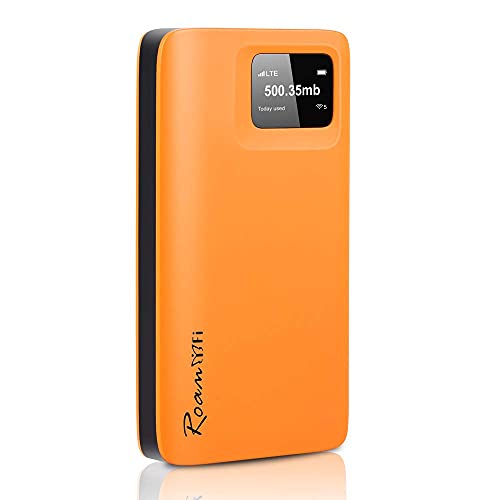
RoamWiFi 4G LTE WiFi Mobile Hotspot Router
The RoamWiFi Mobile Router is a powerful global Wi-Fi hotspot with super-fast 4G LTE speeds that can be used in over 160 different countries and shared to 5 connections. Sleek and stylish, the simple orange hotspot can be stored in your carry-on luggage and will be easy to find when you get there.
By far, the most impressive feature of this particular model is the whopping 18 hours of battery life . 500MB of data can be purchased for as little as $2.90 per day.
Bottom Line: All-in-all, this is a tremendous little Wi-Fi hotspot for your next adventure.
5. Compact and Capable Offering 18 Hours of Battery Life

Netgear Unite Explore AC815S Mobile Wi-Fi Hotspot
This slim 4G LTE-capable device provides super-fast internet and as much as 18 hours of battery life on a single charge to as many as 15 Wi-Fi devices on the go.
Super easy to use, the color LCD screen shows you all the network info you need, as well as displaying battery life and connectivity levels.
Bottom Line: Made by one of the most trusted names in communications, the Unite Explore is a reliable Wi-Fi hotspot for travelers looking for longer battery life.
6. Superfast Connectivity in Over 135 Countries

SIMO Solis Lite 4G LTE WiFi Mobile Hotspot
With no contract or SIM card required, this convenient little device will ensure you’re always connected on the go. The virtual SIM technology is compatible with most major carriers, and you can control everything through the handy Solis WiFi app.
You can connect up to 10 different devices with up to 16 hours of battery life on a single charge. As well as keeping you connected, this mobile hotspot doubles up as a power bank, so you’ll never run out of charge.
Bottom Line: With SIMO Solis, users can enjoy day pass Wi-Fi, pay as you go access by gigabyte, or monthly and yearly subscriptions.
7. Connect 10 Wi-Fi Enabled Devices With This Verizon Jetpack

Verizon MiFi Jetpack 4620L
Brought to you by the communication experts at Verizon, this MiFi Jetpack offers superior connectivity and speedy internet access virtually anywhere in the world. With the ability to connect up to 10 Wi-Fi-enabled devices in 4G and up to 5 devices in 3G, this is one of the most effective LTE hotspot devices on the market.
Compatible with all major operating systems including Windows, Mac OSX, Android, and iOS, you can quickly and easily connect your phone, tablet, or laptop. The interactive OLED display shows you when you are connected, as well as the connection status and how many users are connected. It can even alert you when you receive a new SMS message.
Bottom Line: With up to 5 hours of usage available from a single charge, this impressive MiFi mobile Wi-Fi device is one of the most effective LTE hotspot devices on the market.
With a mobile Wi-Fi hotspot, you are no longer at the mercy of unsecured, cumbersome, and often super-slow public Wi-Fi signals when you take to the road. Your very own Wi-Fi allows you to download data, upload images, and keep in touch with civilization, no matter how far away you go.
Before you commit to a connection, look for a mobile Wi-Fi device that is compact and portable with a large enough battery to last you all day. Your new Wi-Fi hotspot should also be simple to use, easy to connect to, and ideally able to offer a connection to several different devices (especially if you’re traveling with friends).
Lastly, don’t miss these other tech-related product reviews to level up your travel game!
- The Best Portable Bluetooth Speakers for Travel
- What are the Best GoPro Alternatives? [10+ Options]
- The Best Portable Power Bank Chargers for Travel
- Travel Product Reviews – Tech & Photography Focus
Related Posts
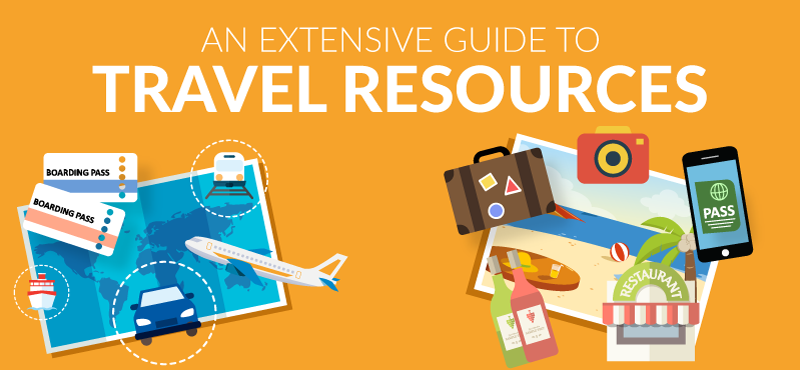
UP's Bonus Valuation
This bonus value is an estimated valuation calculated by UP after analyzing redemption options, transfer partners, award availability and how much UP would pay to buy these points.
The Great Outdoors
The 8 best unlocked portable Wi-Fi hotspots for travelers and digital nomads
An unlocked portable Wi-Fi hotspot is a must for travelers, digital nomads, or backpackers. Here are our top picks for portability, speed, and network coverage.
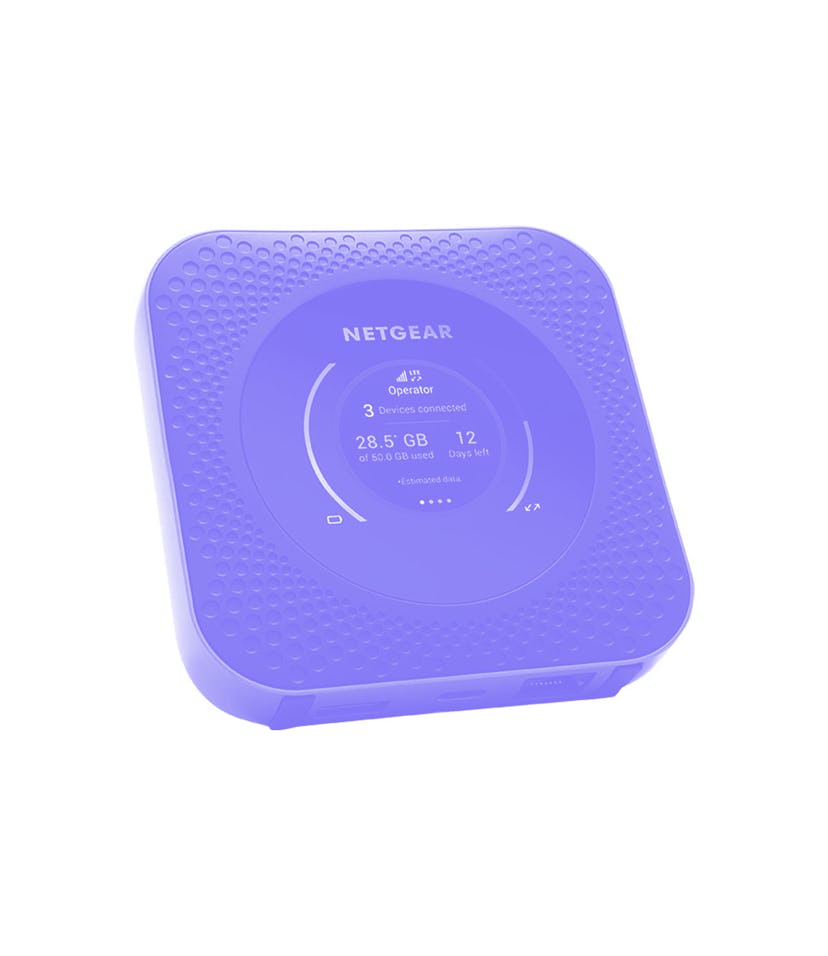
As a digital nomad you’re either strapping up your hiking boots to hit the local trails, or flying to Mexico for a week of margaritas and sunshine. And with remote work becoming more common, a life spent hopping between countries is finally within reach for many of us. But life on the road, or in the woods, lacks one necessary modern convenience: an internet connection.
Fortunately, portable Wi-Fi hotspots are the perfect solution for travelers and digital nomads to stay connected. These compact devices provide a high-speed connection wherever you go, so you can get your work done (and pay the bills) while exploring new locales or camping beneath towering evergreens.
How do mobile Wi-Fi hotspots work?
A portable Wi-Fi hotspot is a pocketable device that uses a cellular signal to create your own Wi-Fi network. These hotspots typically output both 2.4GHz and 5GHz Wi-Fi connections, and connect to the internet through mobile networks that transmit cellular data through radio waves, called frequencies. This means that you can connect your laptop , tablet, or smartphone to the internet even if there is no public Wi-Fi available. Portable Wi-Fi hotspots are sometimes also called "Mi-Fi" devices.
Features to look for in a Wi-Fi hotspot
Prepaid data packages vs. SIM card
To get your portable Wi-Fi device connected to the internet, you will need to purchase a prepaid data plan or local SIM card. If you plan to use your Wi-Fi hotspot for international travel, look for a device that has prepaid data plans available. Purchasing a prepaid plan prior to leaving on a trip means you can skip the hassle of locating a foreign service provider and picking up a SIM card.
If you're planning on using your hotspot primarily in the U.S. and North America, purchasing a SIM card from a major carrier like AT&T or T-Mobile will get you the best network coverage. I recommend this option for campers , hikers , or van-lifers that require an internet connection in remote locations.
Supported networks and frequencies
The frequencies used to transmit data vary depending on the region or country you're in and the carrier you're on. You need to keep an eye out for which frequencies your hotspot will support.
The most common networks and their frequencies include:
- 2G/3G : The second- and third-generation of wireless technology. These networks run on either GSM (Global System for Mobiles) or CDMA (Code Division Multiple Access) frequencies. GSM is more widely used and better for travelers.
- 4G or LTE : This network is currently the global standard and offers the fastest connection speeds. 4G transmits through LTE frequencies, and only uses GSM or CDMA as a fallback when there is no LTE connection available.
- 5G: The fifth-generation mobile network technology provides increased reliability, speed, and network capacity, but global coverage is currently only at 25 percent . Outside of major cities, 4G LTE and 3G networks are the most widely available.
Luckily, device makers don’t want to build a different device for every frequency, so most Wi-Fi hotspots are compatible with 2G, 3G, and 4G LTE. Keep in mind that your hotspot will only work in areas where there is cellular coverage , no matter the frequency. Oftentimes, remote locations will not have a signal since there aren't any nearby cellular towers or the closest one can't reach it.
Input may receive a portion of sales if you purchase a product through a link in this article. We only include products that have been independently selected by Input's editorial team.
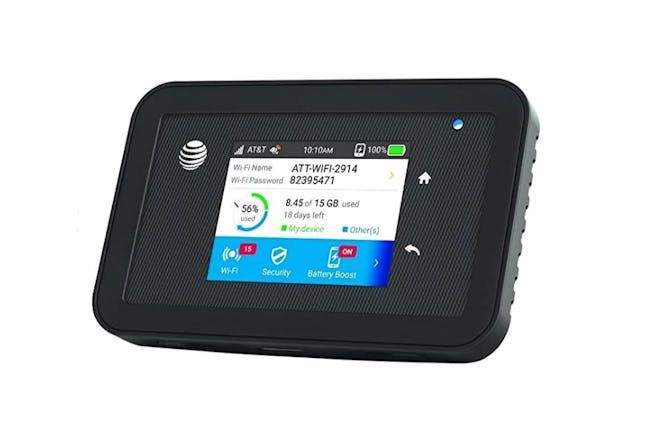
Reliable hotspot built for traveling, with 18-hour battery life and 450Mbps download speeds.
The NETGEAR Unite Explore AC815S is a fast and reliable hotspot with 18 hours of battery life. This device provides download speeds up to 450Mbps. The device is compatible with GSM SIM cards, so you can use it with your preferred service provider. Bonus points go to the Unite Explore for its durable design with rubber bumpers and splash resistance.
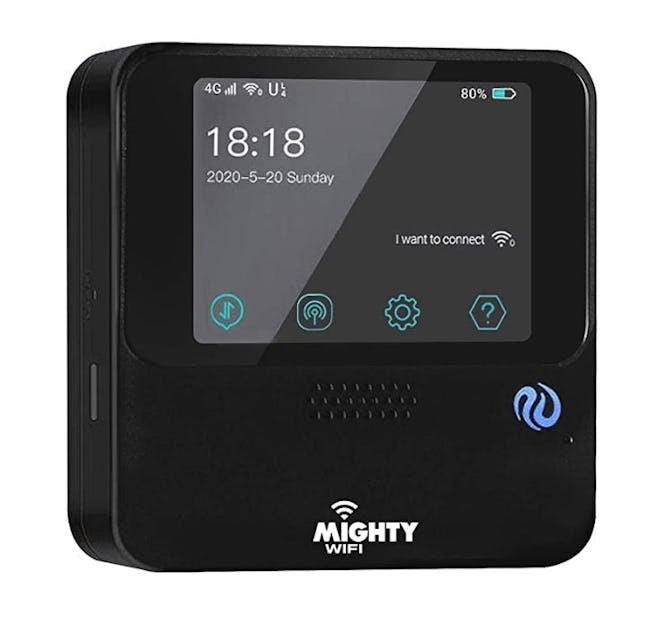
Provides SIM-free global coverage and allows you to connect up to five devices.
The MightyWiFi is a SIM-free hotspot that supports 29 frequencies on the 4G network which provides you with coverage in over 150 countries. This hotspot has flexible global data plans that are prepaid, ranging from 3GB to 30GB. The 5,000 mAh battery also doubles as a portable power bank with up to 12 hours of usage. The MightyWiFi supports up to five devices at once.
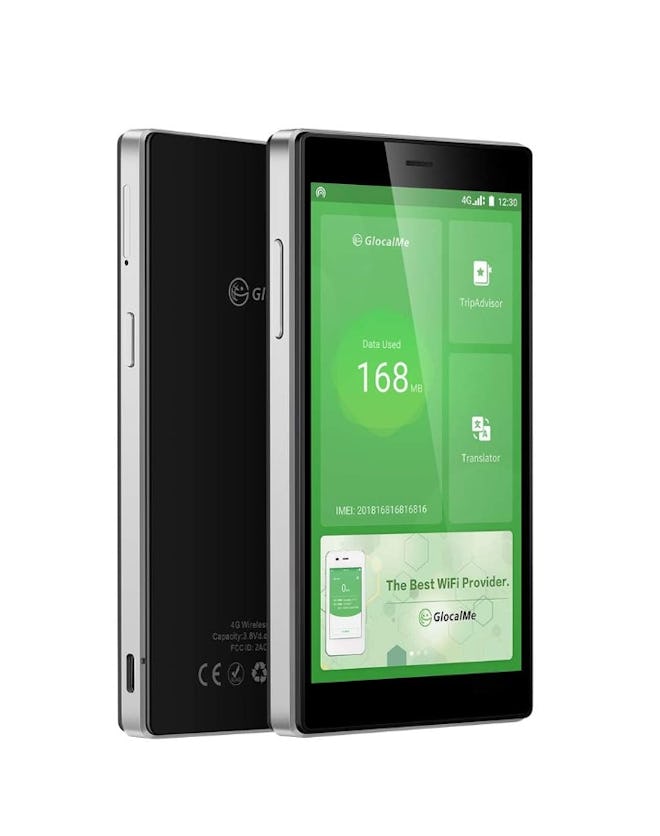
Powerful, pocket-sized and supports most international SIM cards.
The GlocalMe G4 is a powerful pocket-sized hotspot with up to 12 hours of battery life, built-in data plans, and support for SIM cards from over 140 countries. With a 5-inch touchscreen display for easy setup and configuration, and built-in apps like Google Maps, this little device is a fuss-free companion.

A durable spill-resistant hotspot that can be easily connected via NFC. Best in class battery life.
The Huawei E5885 Wifi 2 has lightning fast 300Mbps download speeds and is compatible with 4G LTE bands in Europe, North America, and Asia. A built-in 6,400 mAh battery pack provides 25 hours of battery life and a 2-in-1 lanyard charging cable that can easily keep both the hotspot or your phone powered up. Setup is made simple thanks to single-tap NFC connectivity. Plus, it's dust and spill-resistant, so it’s a great fit for more rugged adventures.

A mobile hotspot that is both fast and reliable, with a built-in 5,000 mAh battery.
The Netgear Nighthawk M1 is an unlocked 4G mobile hotspot that's fast and reliable. It comes with a built-in 5,000 mAh battery capable of providing 11 hours worth of power while you're out hiking or traveling. This compact device has a USB port for media streaming from an external drive or for charging your phone in a pinch. Compatible with SIM cards from most major service providers, but also supports prepaid data plans from AT&T and T-Mobile.
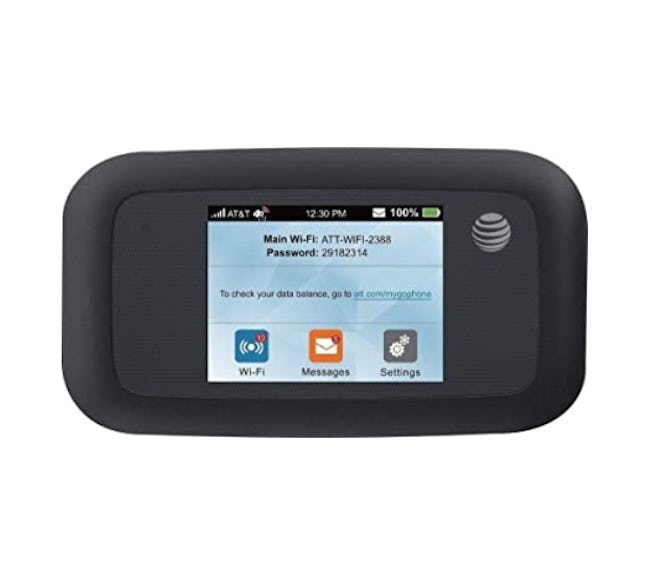
A GSM unlocked hotspot that supports both 4G and 5G networks.
The ZTE Velocity MF923 is a GSM unlocked hotspot that supports up to 10 devices at once. It comes with a 2,800 mAh battery that provides 10 hours of battery life, and you can insert a microSD to use as a shared network drive. The Velocity also has a bright and responsive 2.4-inch touchscreen display, which makes it easy to set up your device within minutes. This device connects to both 4G and 5G networks in 200 countries.
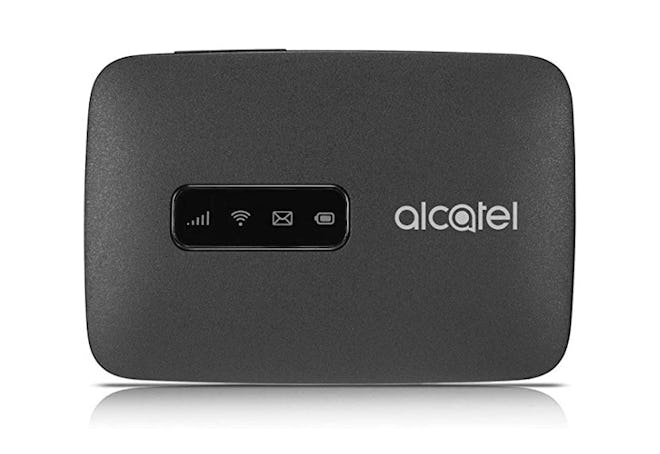
Budget hotspot that supports 4G LTE speeds and works with a micro-SIM from any GSM carrier.
Alcatel’s LINKZONE is a simple budget hotspot capable of providing 4G LTE speeds up to 150Mbps. The LINKZONE works with a SIM card from any GSM carrier and supports up to 15 devices at once. You’ll get six hours of juice out of the 1,800 mAh battery, and setup is a breeze thanks to the user-friendly interface. This hotspot is ideal for travelers heading to Central or South America since it is compatible with 4G networks that transmit through 1,700-2,100 Mhz frequencies.

Affordable option that provides 6 hours of battery life and fast download speeds.
The Huawei E5577Cs hotspot costs less than $100. It has a 1,500 mAh battery that lasts for six hours on average and supports all GSM networks. Download speeds reach up to 150Mbps. This hotspot can also be used as a Wi-Fi extender at home, making it useful even when you’re not traveling. On top of that, with the LCD touchscreen, you can view available networks, battery life, and easily tinker with other settings.
🏕 The Great Outdoors: Your guide to exploring all that our beautiful planet has to offer even if that means still being online (sometimes).
Watch: extreme reviews.

Popular Destinations

All Destinations
- Aland Islands
- Canary Islands
- Czech Republic
- El Salvador
- Europe & UK
- Faroe Islands
- Indonesia (Bali)
- Liechtenstein
- Middle East
- Netherlands
- New Zealand
- North America
- Philippines
- Saudi Arabia
- South Africa
- South America
- South Korea
- Switzerland
- United Arab Emirates (Dubai)
- United Kingdom
- United States of America
- Vatican City
Your cart is empty
BUY ONE, GET ONE 25% OFF ALL ESIMS

How to Get High-Speed Internet While Traveling
In the immortal words of Hans Christian Andersen, "To travel is to live." But in today's world, to travel without high-speed internet is, well, practically medieval. Whether you're live-streaming the neon dazzle of Tokyo's Shibuya Crossing or Zooming into a work meeting from a beach in Bali, high-speed internet has become as essential as your passport. But how do you ensure that your online life doesn't hit a snag when you're hopping from one country to another?
Table of Contents
Understanding your high-speed internet needs while traveling, the role of bandwidth in your internet speed, travel sim cards: a traveler's best friend for connectivity, choosing the right travel sim card, how to purchase and activate your travel sim card, portable wi-fi hotspots: your gateway to high-speed internet, best portable wi-fi hotspots on the market, local sim cards vs. international roaming: what’s best for high-speed internet, tips for purchasing a local sim card abroad, leveraging free wi-fi: tips and tricks for secure, high-speed access, using vpns to secure your internet connection on public wi-fi, advanced tips for consistent high-speed internet while traveling, the future of travel internet: emerging technologies, practical case studies, how can i ensure high-speed internet in a country with poor connectivity, are travel sim cards cost-effective for long-term travel, can i use my regular sim card to get high-speed internet abroad, what are the risks of using public wi-fi for high-speed internet, how does the speed of portable wi-fi hotspots compare to local sim cards.
Fear not, digital wanderers and workation warriors! I'm Bryan Holiday, your cyber-savvy Odysseus in the tumultuous sea of travel connectivity. With over a decade of trotting the globe and staying plugged in, I've mastered the art of maintaining a robust internet connection, no matter where my travels take me. So, buckle up as we embark on a journey to unravel the secrets of high-speed internet for travelers.
Before you start dreaming of seamless uploads of your Sistine Chapel selfies or crystal-clear calls home, let's get down to brass tacks. Understanding your internet needs is crucial. Are you a casual browser, an Instagram influencer in the making, or a remote-working road warrior? Your online activities dictate the speed you need. Streaming "Game of Thrones" in HD is going to gobble up data faster than a Lannister pays his debts, while sending emails is as light on your data as feathers on a Maester's quill.
Bandwidth is the Jon Snow of internet terms – it's much more important than it first appears. Simply put, bandwidth is the volume of information per unit of time that a transmission medium (like an internet connection) can handle. More bandwidth means more data can flow through, akin to how a wider Westerosi road allows more troops to march side by side. When you're traveling, you want a connection that's as wide and as open as the King's Road, ensuring your internet speed is as swift as a raven from the Citadel.
Stay tuned, as in the next sections, we'll dive into the nitty-gritty of travel SIM cards, portable Wi-Fi hotspots, and the eternal debate of local vs. international roaming. We'll also cover how to keep your data safe faster than you can say "Valar Morghulis" when connecting to public Wi-Fi. So, grab your digital swords (smartphones, folks), and let's get you connected with the speed of Hermes himself.
Imagine you're Indiana Jones, navigating through the dense jungles of foreign telecom regulations, looking for that golden idol of uninterrupted connectivity. That's where the trusty travel SIM card swings in, saving the day like a well-placed vine over a pit of snakes.
Travel SIM cards are the unsung heroes for globetrotters seeking high-speed internet. These nifty little chips are your all-access pass to local networks, usually offering better rates and faster services than your home network could ever hope to provide abroad. They work by slotting into your phone like any other SIM card, but instead of chaining you to one network, they have agreements with multiple carriers across the globe.
Not all SIM cards are created equal, and like Dumbledore's selection of socks, the choices can be overwhelming. When choosing a travel SIM card, consider the following:
- Coverage: Does it cover the Shire, Mordor, and all the lands in between? Jokes aside, check the countries and regions it operates in.
- Data Plans: Are you looking for unlimited data, or are you more of a 'pay-as-you-go' Gandalf? Make sure the plan fits your usage.
- Costs: Compare the costs like a Lannister preparing for a wedding – with meticulous attention to detail.
- Compatibility: Ensure the SIM works with your device. It's like making sure the wand chooses the wizard in the world of Harry Potter.
Purchasing a travel SIM card is easier than convincing a Hobbit to go on an adventure. You can buy them online before you leave, at the airport, or in local shops upon arrival. Activation is usually as simple as inserting the SIM into your phone and following the carrier's activation steps – no need for a convoluted spell or ancient incantation.
For those who find swapping SIM cards as tedious as listening to the Entmoot, portable Wi-Fi hotspots might be your goblet of fire. These devices are like carrying your personal little piece of the internet in your pocket. They work by tapping into cellular networks and creating a private Wi-Fi network just for you – think of it as your personal bubble of internet connectivity.
When choosing a portable Wi-Fi hotspot, you want to look for:
- Battery Life: It should last longer than the final season of "Lost" felt.
- Connectivity: It must provide a strong, stable connection, or it's as useful as a chocolate teapot.
- Size: It should be as unobtrusive as a ninja in the night.
- Price: Ensure the cost doesn't leave your wallet feeling like it faced Thanos.
Some of the top contenders in the market include the Skyroam Solis, the Netgear Nighthawk LTE, and the Huawei E5577Cs. Each has its own set of superpowers, from long battery life to impressive speed capabilities.
When you're crossing borders faster than a Jason Bourne car chase, you need to make a pivotal decision: opt for a local SIM card at each stop or go with the convenience of international roaming? It's the traveler's version of the Matrix's red pill or blue pill dilemma.
Local SIM cards are like getting a new identity in each country you visit. They offer the most cost-effective way to enjoy high-speed internet since you're paying local rates for data – no shocking bills that make you feel like you've just funded a villain's lair. However, the downside is that every time you hop to a new country, you'll need to source a new SIM card, which can feel like you're collecting Infinity Stones.
International roaming , on the other hand, is the superhero of convenience. It's your shield in the battle against the hassle of changing SIM cards. With international roaming, your phone automatically connects to local networks as you travel. But beware, the costs can be as treacherous as a deal with Loki, often resulting in exorbitant fees that can quickly add up.
If you decide to go down the local SIM card route, here are some tips to make the process as smooth as a James Bond pickup line:
- Research Before You Go: Like a good spy, gather intel on the best local SIM options before you land.
- Unlock Your Phone: Ensure your phone is unlocked – it's the key to making new SIM cards work.
- Know Your Size: SIM cards come in different sizes. Know whether you need a nano, micro, or standard SIM.
- Check the Data: Always confirm the amount of data and the validity period. You don't want your internet disappearing faster than a Snapchat message.
- Top-Up Locations: Find out where you can recharge your SIM card. You don't want to be caught out of data like a ship out of wind.
Free Wi-Fi can be as tempting as the One Ring – powerful and convenient, but with risks. It's available in hotels, cafes, and even public spaces, but unlike Frodo's burden, you don't need to go it alone. Here's how to use free Wi-Fi safely:
- Use a VPN: A Virtual Private Network (VPN) is like an invisibility cloak for your online activities, keeping your data safe from prying eyes.
- Avoid Sensitive Transactions: Never access your bank accounts or any sensitive information while connected to public Wi-Fi. It's like giving Sauron your location.
- Keep Your Firewall On: This is your digital fortress against potential threats.
- Forget the Network After Use: Don't let your device get too attached to a network. Always 'forget' the network after use to avoid automatically connecting in the future.
A VPN is your secret weapon, encrypting your data and rerouting it through a server elsewhere in the world. It's like sending your internet traffic on a secret mission, bypassing the surveillance of nefarious networks. When choosing a VPN:
- Select a Reputable Service: Opt for a VPN with a no-logs policy and strong encryption – think of it as choosing a member for your heist crew.
- Ease of Use: The VPN should be as easy to use as a clap-on, clap-off light.
- Speed: Ensure your VPN doesn't slow down your connection to a crawl.
We'll explore advanced tips for consistent high-speed internet while traveling, because let's face it, nobody wants their video call to freeze on an unflattering frame. Stay tuned, as we'll also look into the future of travel internet, where the possibilities are as boundless as the final frontier.
Now, let's talk about keeping your internet faster than a Millennium Falcon on the Kessel Run, even when you're off the beaten path. Here are some advanced tips for those who need to stay connected with the speed and reliability of a Starship Enterprise at warp speed.
Satellite Internet for Remote Locations: If your travels take you to remote corners of the Earth, where the internet is as scarce as a quiet moment in a Tarantino flick, satellite internet might be your holy grail. Companies like Iridium and Globalstar offer devices that connect to satellites instead of terrestrial cell towers, ensuring you can send that important email whether you're on the peak of Everest or the plains of the Serengeti.
Data Compression Tools and Techniques: Data compression is like a magic spell for your internet data. It shrinks the size of the data being transmitted, allowing for quicker upload and download speeds. Use mobile browsers like Opera Mini or Google Chrome, which have data compression features built-in, making your browsing as efficient as Hermione with a time-turner.
Network Extenders and Signal Boosters: These devices can be as crucial as a Swiss Army knife for MacGyver. They amplify a weak signal, giving you a fighting chance at a stable connection in areas where the signal is as elusive as a ninja in the night. It's perfect for those staying in remote villas or rustic cabins where the nearest cell tower is just a distant cousin.
As we look to the horizon, the future of travel internet is as bright as the glow of a lightsaber in a dark room. Emerging technologies promise to make connectivity issues a thing of the past, like floppy disks and dial-up tones.
Developments in Satellite Internet (Starlink for Travelers): Elon Musk's Starlink is set to revolutionize the way we connect. Imagine high-speed internet beamed down from space, covering every corner of the globe. This isn't science fiction; it's the near future, and it's as exciting as the prospect of a new "Star Wars" trilogy.
The Rise of eSIM Technology: eSIM technology is like having a shape-shifting mutant power for your phone. It allows you to switch carriers without swapping SIM cards, all with a few taps on your device. It's still in its early days, but it's poised to make the life of a traveler as easy as a Sunday morning.
To bring it all home, let's look at some practical case studies of travelers who've managed to stay connected against all odds, like a tech-savvy Robinson Crusoe.
Real-life Scenarios of Travelers Maintaining High-Speed Internet Access: From travel bloggers in the jungles of Amazon to photographers in the Arctic Circle, these stories will show you that with the right tools and a bit of know-how, you can stay connected anywhere.
Interviews with Frequent Travelers and Digital Nomads: Hear straight from the horse's mouth how seasoned travelers navigate the challenges of staying online while on the move. These are the Gandalfs and Dumbledores of travel tech, and their wisdom is pure gold.
As we wrap up this digital odyssey, remember that staying connected while traveling doesn't have to be as daunting as a "Mission Impossible" stunt. With the right preparation and a little tech savvy, you can have high-speed internet at your fingertips, ready to tackle whatever your journey throws at you.
So, whether you're a casual traveler looking to share your experiences, a digital nomad earning your living on the go, or just someone who likes to stay in the loop, the world is your oyster, and high-speed internet is the pearl. Go forth and explore, safe in the knowledge that the digital world is just a click away.
Thanks for visiting our blog, are you planing to travel to Europe ? Check out our eSIM Europe .
Before you take off make sure to check with local government of the travel status.
Before you set off on your next grand adventure, armed with all the internet know-how of a Silicon Valley wizard, let's tackle some of those frequently asked questions that might still be buzzing around your head like a drone over a scenic vista.
Even in countries where the internet crawls slower than a snail on tranquilizers, there are ways to boost your chances of a decent connection. Look for accommodations that boast high-speed internet as an amenity – it's often a sign they've invested in infrastructure like signal boosters. Also, cafes and libraries are often little oases of connectivity; just make sure to secure your data with a VPN.
For the nomadic among us, a travel SIM card can be as vital as a good pair of walking shoes. If you're traveling long-term, they're generally more cost-effective than international roaming – think of it as investing in a quality backpack rather than renting one at every stop. Plus, many offer plans tailored for extended adventures.
You can, but it's like using a map from the '90s – not the best tool for the job. International roaming charges can be exorbitant, and you may find your 'high-speed' internet is throttled to a pace that would lose to a tortoise. Always check with your provider for their roaming policies and consider a local or travel SIM as a more efficient alternative.
Public Wi-Fi networks are like a box of chocolates from a stranger; you never know what you're gonna get. They can be insecure, allowing cyber ne'er-do-wells to intercept your data. Always use a VPN to encrypt your connection, and avoid accessing sensitive information like bank accounts when on public networks.
Portable Wi-Fi hotspots can deliver speeds that rival local SIM cards, provided you're in an area with good coverage. However, the speed can also depend on the number of devices connected and the network traffic. It's like a highway; the more cars (or data), the more potential for traffic jams.
And there you have it, fellow travelers – your compass and map to navigating the world of high-speed internet on the go. If you've found this guide as useful as a Swiss Army knife on a camping trip, remember to share it with your fellow wanderers.
Need more help plotting your course through the digital landscape? Reach out, and let's chart your path to seamless connectivity, no matter where your travels take you. Until then, safe travels and happy streaming!
Leave a comment
All comments are moderated before being published
Why we need activation dates?
- We need these dates to activate your SIM card so you can use them when you’re ready to travel.
- If you don’t give us an activation date, your SIM card will not work when you plug them into your phone.
Not sure on your dates yet?
- You can add in an estimated date for your SIM. Your SIM’s data & validity won’t start until you plug it into your device.
- Once you know your exact dates, please let us know via our live chat or at [email protected] so we can activate it for you at the right time.
What if you need to change the dates?
- You can reach out to us via our live chat or at [email protected] with your SIM number so we can change it for you.
- Search Please fill out this field.
- Manage Your Subscription
- Give a Gift Subscription
- Newsletters
- Sweepstakes
We independently evaluate all of our recommendations. If you click on links we provide, we may receive compensation.
- Travel Products
- Tech Essentials
The 6 Best Portable Wi-Fi Hotspots of 2024
These handy devices keep you connected with ease.
:max_bytes(150000):strip_icc():format(webp)/Stefanie-Waldek-7eed18a8c9734cb28c5d887eb583f816.jpg)
In This Article
- Our Top Picks
- Tips for Buying
- Why Trust T+L
Travel + Leisure / Marcus Millan
We're fortunate to live in an era where cell coverage reaches 95 percent of the population, according to the International Telecommunications Union. And that makes staying connected while traveling to most on-the-grid destinations a breeze. Many cell phone carriers offer some level of international data plans, which allows you to use your devices abroad — for a fee, of course.
But if you're working on the go, traveling in a group, or attempting to preserve your phone's battery, you might want to look into getting a portable Wi-Fi hotspot, which often provides more data to more devices. "Portable hotspots will use data just like cell phones do, and coverage will really depend on the carrier and the coverage they offer in the area," Best Buy mobile supervisor Thomas Walker told Travel + Leisure . "Since hotspots require data, they also require a plan, something to remember as you consider buying a portable hotspot."
Best Overall
Simo solis lite.
The device comes with a free lifetime global data plan.
1GB of monthly data will go by very quickly; you'll have to pay up for more.
There are many things the Simo Solis Lite does well, but the real showstopper here is the company's lifetime global data plan that gives you 1GB of data each month for as long as your device functions. And this plan truly is global, as the device works in 135+ different countries . That said, 1GB isn't much data at all. Depending on your usage, you might need to upgrade to a more robust data package, which typically costs anywhere from $6 to $109, or potentially more, per month. On the plus side, you don't need to change SIM cards in this hotspot — you can add those plans via an app.
As for the other stats with this device, the 16-hour battery life is well above average. We love that you can charge other devices with this hotspot — although that will reduce its battery life , of course. Up to 10 devices can be connected to the Solis Lite, which is likely suitable for most users, but it's an unremarkable number compared to other products on the market. Similarly, 4G connectivity is serviceable but doesn't earn any special accolades. If you're traveling with a large group of people, you may want to consider other options depending on how connected you need to be.
One other standout feature of this Wi-Fi hotspot is true 24/7 customer support — this is especially valuable for travelers who need internet access at all hours across various time zones.
The Details: 16-hour battery life | 4G connectivity | 5.98 x 4.69 x 1.73 inches | 10.2 ounces
Best for SIM Cards
Netgear nighthawk m6 pro.
It has Wi-Fi 6E connectivity and works in more than 125 countries when swapping in a new SIM card.
13 hours of battery life is good, but not great.
If you need a fast and reliable internet connection just about anywhere, Netgear's Nighthawk M6 Pro might be the solution. It's compatible with AT&T, T-Mobile, and Verizon in the U.S., and it works in more than 125 countries when swapping in a new SIM card, supporting both 5G and Wi-Fi 6E. You can connect up to 32 devices simultaneously, allowing an entire team of remote workers to stay connected. And if you're on the move , you'll enjoy a more secure connection with the Nighthawk than public Wi-Fi.
Beyond its uses for remote work around the world, the Nighthawk M6 Pro could even replace a standard internet connection at your home or office. Because it can function with both a wired and wireless connection, you won't lose connectivity due to internet or electricity outages. And with 13 hours of battery life, you'll have time to wait for the outage to end. That said, increased battery life would be ideal, especially for remote workers and travelers. But whether you're in a home office or off the grid, it's hard to beat this product's speed.
The Details: 13-hour battery life | Wi-Fi 6E connectivity | 4.1 x 4.14 x 0.85 inches | 0.56 pounds
Most Versatile
Glocalme numen air 5g.
There's no SIM card required and it offers thousands of flexible data plans.
The battery life and number of devices could be better, but are likely fine for most users.
The GlocalMe Numer Air 5G works in more than 140 countries on more than 100 operator networks — that means you'll be covered just about anywhere. It doesn't need a SIM card to work, thanks to its CloudSIM technology. Upon purchase, you'll automatically receive 1GB of global data for a 90-day period, and additional data can be added easily via the mobile app. There are thousands of flexible data plans from which to choose, including pay-as-you-go options with no contract. In other words, this is a convenient mobile hotspot to take with you while you travel, since it's designed to be useful in a wide variety of cellular settings and situations.
Stat-wise, we consider the 12-hour battery life to be good, but not especially impressive. That said, it may be plenty of time depending on how you intend to use the device. You can connect up to 16 devices, which is probably plenty for most users but may not be ideal for an office setup.
The Details: 12-hour battery life | 5G connectivity | 6.1 x 2.8 x 0.6 inches | 6.8 ounces
RoamWiFi Portable WiFi Device
It's not just the device that's a good value — some data plans are fairly low-price.
Only five devices can connect to the hotspot at a time.
This 4G LTE mobile hotspot router delivers a surprising amount of power and flexibility inside an affordable package. The device itself is priced under $200, and a variety of data plans are available at all price points, ranging from a $3 day pass to a $299 90-day pass. No SIM card is needed, and the device works in more than 160 countries (there's a complete list about halfway down the Amazon product page). The whopping 18 hours of battery life outperforms every other battery-powered hotspot on our list.
That said, there are some limitations that come with the lower cost. The device does not connect to 5G networks, so internet speeds won't necessarily be the fastest. Also, you can only connect five devices to this hotspot which is plenty for the average solo user , but may not be suitable for groups or families.
The Details: 18-hour battery life | 4G connectivity | 4.96 x 2.68 x 0.57 inches | 6.3 ounces
Best Unlocked
Netgear nighthawk m1.
It works on all major domestic carriers, including GoogleFi.
Netgear doesn't publish battery life.
Able to connect and share data with 20 devices at once, the Netgear Nighthawk M1 Mobile Hotspot can handle multiple tasks at once without sacrificing power or speed. It's an unlocked device that uses GSM SIM cards, compatible with AT&T, Verizon, T-Mobile, and GoogleFi in the United States, and can serve as a backup internet connection while not traveling. It's equipped with fast 4G LTE broadband and offers up to one gigabit per second (Gbps) of download speed. Worried about how much data you've used? Its LCD screen clearly displays how much data is remaining, calculates when it will run out, and keeps count of the devices connected.
While Netgear doesn't publish the battery life of the Nighthawk M1, it claims it can last "all day" — and you can even buy a battery booster pack for more juice. There is an upgraded version of this hotspot that is 5G-compatible, but it's nearly double the price. 5G connectivity may not be necessary for most travelers.
The Details: "All day" battery life | 4G connectivity | 4.15 x 4.15 x 0.8 inches | 8.5 ounces

Best Router
Gl.inet gl-mt3000 wireless travel router.
It creates a more secure internet connection for your devices.
Routers like this one are not capable of providing internet on their own.
Technically, a Wi-Fi router is not a portable Wi-Fi hotspot. But what it does do is allow you to take one internet connection with a tricky login situation — say, hotel Wi-Fi that asks you to input your room number every time you connect — and streamlines the process for connecting additional devices. In a nutshell, you connect to Wi-Fi via the router, which then creates a more secure network for you to connect to from other devices. This router can also boost Wi-Fi signals throughout a space, so if you're in a vacation rental where the Wi-Fi is strong in one room but not another, a router can help.
This portable router is compatible with more than 30 VPN service providers and can accommodate up to 70 different devices, making it one of the best devices for securely accessing high-speed internet while traveling or on the move. The AdGuard feature helps to protect your devices from malware, phishing, ads, and online trackers. This is an especially important safety feature for using unfamiliar WiFi connections.
The Details: Wi-Fi 6 connectivity | 4.53 x 3.15 x 1.18 inches | 6.9 ounces
Tips for Buying a Portable Wi-Fi Hotspot
Consider where and when you'll use it.
Not all portable Wi-Fi hotspots can be used everywhere. If yours is tied to a U.S.–based carrier (like AT&T, T-Mobile, and Verizon), and you're planning on going abroad, you need to make sure you've paid for a data plan that includes international use. If you're only traveling for a short period of time, this might be the most convenient option.
But if you're planning on traveling internationally for an extended period of time, you might want to opt for an unlocked portable Wi-Fi hotspot — that is, one that isn't tied to a specific carrier. You can then buy a data plan from a company based in your destination, which usually is a more economical decision. "SIM cards are cheap and easy to get in lots of countries worldwide, and going this route ensures you get the strongest signal possible for the lowest price," Peter Holslin, senior staff writer at internet comparison site HighSpeedInternet.com, told T+L.
The duration of your trip should also inform whether you want to purchase an as-you-go data plan (better for shorter tips) or a monthly one (better for longer trips).
Check with your phone carrier
"When you use a portable hotspot, you can choose the carrier it's connected to. So if you want to maximize your coverage, you can use one carrier for your phone and a different carrier for the hotspot," Walker said. It's often cheaper to buy a Wi-Fi hotspot to hook up to a local network while traveling versus paying for an international phone plan with your current carrier as well.
Think about voltage and battery life
For the most part, portable Wi-Fi hotspots use a relatively low amounts of power (about five to seven volts, depending on the size and strength of the device). However, you should still utilize a power converter when plugging your hotspot in during international travels. Not all outlets around the world support the same power output, so using an adapter can prevent blowing a fuse or sparking your devices. If you want a more portable Wi-Fi hotspot that doesn't need to be plugged in, be sure to check its expected battery life to know exactly how long you can use it on the go.
Frequently Asked Questions
How do portable wi-fi hotspots work.
"Wi-Fi hotspots work similar to phones, tapping into your cellular network to provide high-speed data for use with laptops, tablets, gaming systems, etc.," Verizon spokesperson George Koroneos told T+L. "What's more? You can give access to your travel companions, so they can use your dedicated hotspot, similar to a Wi-Fi network."
Does a portable Wi-Fi hotspot use data?
Yes, it does. "Mobile hotspots connect to cellular networks to provide internet connection allowing customers to connect anywhere," Jeff Howard, AT&T's vice president of hardware and partner solutions, told T+L.
How do I connect a portable Wi-Fi hotspot in a different country?
It depends on what type of portable hotspot you have and what type of plan you have. If your hotspot plan is locked to a specific carrier, you'll need to make sure your carrier has an international plan. (Spoiler alert: most do.) It might be as simple as turning your device on and letting it automatically connect to a local cell network. But if your portable hotspot requires a local SIM card to work, you'll have to pick one up at the airport or at a store and insert it into your hotspot to connect to a local cell network.
Why should I use a portable Wi-Fi hotspot instead of my cell phone data plan?
Many cell phone providers have international plan options for travelers, and you can turn most smartphones into a mobile hotspot under that plan. Then you can connect devices to your cell phone for internet services. But that's not always the best solution. "One thing to consider is carriers may limit the hotspot data amount on your phone, so you may see slower speeds at a certain point," Walker said. "You also don't have to run your cell phone battery when you use a standalone hotspot." On the other hand, portable Wi-Fi hotspots require their own data plans, which costs additional money.
Why Trust Travel + Leisure
Stefanie Waldek is a freelance travel writer who has tested cell coverage on all seven continents. (Antarctica is by far the worst.) For this article, she poured over cell service coverage maps and read dozens of customer reviews.
In compiling this list, she also interviewed telecommunications experts to discuss what to look for in a mobile hotspot. Experts she spoke to included:
- Thomas Walker , Best Buy mobile supervisor
- Peter Holslin , senior staff writer at internet comparison site HighSpeedInternet.com
- George Koroneos , Verizon spokesperson
- Jeff Howard , AT&T's vice president of hardware and partner solutions
Love a great deal? Sign up for our T+L Recommends newsletter and we'll send you our favorite travel products each week.
:max_bytes(150000):strip_icc():format(webp)/JasmineGrant-c7aebf391faf4c1c8767a407a955548a.jpg)
Related Articles
- Best Portable Internet Providers of 2024
- Tyler Cooper
Since the birth of the internet, we’ve seen all kinds of internet users. Business folks require constant access to secure and fast internet as they travel to even the most remote locations. Road warriors bike around cities and settle down in chic and inspirational neighborhoods to blog or run an online business. Now, in 2024, the COVID-19 pandemic has forced adults and children to stay home and use the internet for work or school. No matter what type of internet user you are, there’s no doubt that the demand for portable internet is on the rise. Our guide will help you understand what to look for when portable internet is a must-have, wherever you are. Let’s dive into learning about the best portable internet in 2024!
What to Expect With Portable Internet
To put it simply, portable internet is receiving a stable internet connection through a dedicated mobile hotspot device. Similar to a wireless router, a mobile hotspot allows you to connect multiple devices. Generally, people need mobile hotspots if they travel frequently or stay away from home for long periods of time. Mobile hotspots can be used as a home internet connection if you don’t use large amounts of data or don’t require download speeds of over 50 Mbps. Also, people who live in areas with poor broadband service may find portable internet a more viable alternative.
Speeds and Data Usage
Although having a high speed internet connection wherever you go is ideal, there are some limitations to portable internet. Most mobile hotspot devices are still 4G, which means that download speeds are limited to around 50 Mbps. Also, many mobile hotspot plans have a soft data cap (a limit on your data usage before your download speeds are reduced to very slow speeds) or a hard data cap (a limit on your data usage that you will be charged for whenever you exceed that limit). These data caps limit most users to connecting two to five devices depending on the bandwidth requirements of each device.
Below, we note down popular online activities and services that require an internet connection as well as the download speed requirements and typical data usage for each. It’s best to understand just how much internet speed you need for the services you use on a daily basis.
If you’re streaming or gaming, you can connect one or (maybe) two devices to your mobile hotspot without compromising your online experience. If you’re a blogger or frequent business traveler that typically uses the internet for browsing the web or sending emails, you can connect up to five or more devices because these online activities won’t require high data needs. For vacationers, a mobile hotspot should still be adequate for two to five devices depending on your bandwidth usage, but don’t expect a single mobile hotspot to be the solution for a larger group of users who need high data usage.
What About 5G?
5G is the next generation for cellular data that’s still being implemented in the U.S. While the theoretical high speeds of 5G reaching 10 Gbps is an attractive goal, there are still some issues such as limited accessibility. Since 5G compatible smart devices are often more expensive than its 4G LTE counterparts, we recommend the latter until the former expands its service. If you really need a 5G mobile hotspot, consider Verizon Wireless or AT&T Wireless, as they have the largest networks and coverage for 5G compatible smart devices.
Portable Internet vs. Smartphones
Many people who own a smartphone have a mobile hotspot functionality, which begs the question, why would anyone want a dedicated mobile hotspot device in the first place? We make our case through the pros and cons listed below.
- Easily manage battery life for both your smartphone and mobile hotspot
- Wider range to connect devices
- Connect other smart devices like a tablet or smart watch
- A separate pool of internet data so you won’t experience reduced speeds on your smartphone for going over soft data caps
- Provides an external battery to charge other devices
- A second device you need to remember to charge and bring with you
- Additional costs for a second device
For light data usage, a smartphone is a viable option for connecting other devices to the internet, but for long-term higher data usage and connecting more than a couple of devices, a dedicated mobile hotspot is necessary—especially if you do not have access to unlimited data with your cell phone plan.
The Best Portable Internet Plans in 2024
While many mobile carriers offer mobile hotspots, the Big 3—Verizon Wireless, AT&T Wireless, and T-Mobile—gives the best coverage options in the U.S. Of the 51 mobile broadband providers , we believe the Big 3 are worthy of your attention.
Verizon Wireless and T-Mobile have soft data caps, so you can use as much data as you want but only an allotment of 4G LTE data. The two providers also have different discounts—either by enrolling in an Unlimited Plus plan through Verizon or enrolling in AutoPay with T-Mobile. AT&T Wireless has a hard data cap and will charge an additional $10 for every 2 GB you use beyond the limit. They also don’t offer any discounts but do allow you to use hotspot data from your smartphone if you’ve already signed up with them. When deciding on a mobile hotspot plan, know that hard and soft data caps play a major role on the cost.
The Best Portable Wi-Fi Hotspots in 2024
Verizon Jetpack MiFi 8800L
Starting at $199, the Verizon Jetpack MiFi 8800L provides a 4400mAh battery, allowing up to 24 hours of usage. This is great for a couple of days worth of internet access without charging. The mobile hotspot device can be used in more than 200 countries, making it the perfect travel companion. The Verizon Jetpack can also connect to the 4G LTE or prior generations, broadcast up to Wi-Fi 802.11ac while supporting up to 15 devices simultaneously, and has a USB Type C port for faster charging—a standard for all new devices.
AT&T Netgear Nighthawk LTE Mobile Hotspot
The Netgear Nighthawk LTE Mobile Hotspot touts a 5040mAh that allows up to 24 hours of usage and up to 1.7 days of standby time. The mobile hotspot device costs $249.99 and supports up to 4G LTE connections, can broadcast 802.11ac while connecting up to 20 devices simultaneously, and uses USB Type C for fast charging.
T-Mobile Franklin T9 Mobile Hotspot
The Franklin T9 Mobile Hotspot, priced at $84, has a 2450mAh battery that provides about 8 hours of constant usage or 48 hours on standby, which is adequate for a full workday. It has a micro USB connection, which is disappointing, but gives you access to emergency charging, connects up to 4G LTE, and broadcasts up to Wi-Fi 802.11ac while supporting up to 15 devices simultaneously.
Skyroam Solis Mobile Hotspot
The Skyroam Solis Mobile Hotspot costs $99.99 and provides internet connections globally, including the U.S. It can connect to 4G LTE, broadcast up to a 802.11n Wi-Fi network, which is good enough for most users, and connects up to 10 devices simultaneously. The device also has a 4700mAh battery that provides 16 hours of usage, which is comparable to some of the higher-end mobile hotspot devices on the market.
The Features of Portable Internet
When choosing a mobile hotspot, there are several important features to prioritize for an optimal experience:
- Network: Your mobile hotspot will only be as good as the network that supports it. Look for a network that offers internet accessibility and high speeds to the areas where you will be visiting. Many mobile hotspot devices can be used with different network providers, so deciding which networks you like best should be one of your main priorities.
- Battery life and charging type: All mobile hotspot devices have different battery sizes which affect how long you can connect to the internet. Look for devices that can operate for 18 hours or more, as some can give constant usage for over 20 hours. It’s important to note that mobile hotspot devices charge with a USB Type A or C cable can be used as an external battery. We recommend devices that use the same charging type as your smartphone.
- Wi-Fi: Be sure to get a mobile hotspot device that supports 2.4GHz, which allows for broad connection range, and 5GHz, which gives a faster transmission rate and reduces interference over Wi-Fi. To best utilize both Wi-Fi bands, you will want your mobile hotspot device to be up to Wi-Fi standards, including 802.11ac.
- USB tethering: USB tethering allows you to connect a laptop directly to your mobile hotspot device using a USB cable. This is convenient if you’re in an area that’s overcrowded with Wi-Fi connections. USB tethering lets you bypass the risk of having a less secure and unreliable wireless connection.
How to Set up Your Portable Internet
Setting up your portable internet doesn’t require the help of a licensed technician. The following steps are a general guideline to accessing whichever mobile hotspot device you use on your smartphone.The process is pretty straightforward, so there’s no need to worry!
- Before setting up a mobile hotspot device, make sure that it’s charged.
- Insert a SIM card provided by the mobile carrier.
- Turn on the device by holding down the power button until the screen turns on.
- Follow the steps on the screen and set up a wireless network using the interface on the device.
The Future of Portable Internet
Portable internet will be a common solution for many users on the go. Countries like Japan only use mobile hotspots—otherwise known as pocket Wi-Fi—even at home! With 5G on the horizon, granting devices access to download speeds of up to 10 Gbps sounds like a far cry into the future but is definitely possible thanks to the advancement of technology. The only limiting factors may be an unstable connection and providers employing data cap restrictions. Until 5G mobile hotspots become more affordable—three times more expensive than 4G LTE mobile hotspots—and accessible, the current standard of portable internet is 4G LTE mobile hotspots for most users.
In Short: Do I Need a Mobile Hotspot?
Many mobile hotspot devices work with different mobile broadband providers , including international ones. If you feel like switching plans, most providers let you change it. This is particularly useful when you can’t afford more data. All in all, portable internet is a prime solution for travelers or individuals on-the-go. A dedicated mobile hotspot device is the best alternative for when you need access to the internet outside your home. While it doesn’t measure up to residential internet by any means, 5G internet will supposedly catch up in terms of speed and reliability. For now, though, you’ll have to make do with 4G LTE on your mobile hotspot device.
Frequently Asked Questions About Portable Internet
Which portable wi-fi is best.
The best portable Wi-Fi depends on what you’re looking for. If you’re traveling within the U.S. or need a local internet connection, Verizon, AT&T, and T-Mobile all offer competitive pricing and their speeds vary based on location. If you’re traveling internationally, then Verizon’s Jetpack MiFi 8800L or Skyroam Solis Mobile Hotspot are great options.
What is the best travel Wi-Fi?
The best travel Wi-Fi depends on your travel destination. If you’re traveling within the U.S., a mobile hotspot device and/or plan from a mobile broadband provider is a good place to start. Just make sure to check their coverage maps for the regions you will be traveling to. If traveling abroad, Verizon’s Jetpack MiFi 8800L or Skyroam Solis Mobile Hotspot are both great mobile hotspot devices for accessing an internet connection in a different country. Remember to check if the provider’s wireless network is compatible with the device.
Can a hotspot replace home internet?
A mobile hotspot can replace home internet if you have basic internet needs such as checking emails, surfing the web, or infrequent streaming. If you’re a frequent gamer, spend a few hours a day watching shows and movies online, or download large files, a mobile hotspot plan might not be able to support the amount of data you’re using. If that’s the case, residential internet is your ideal choice.
Is there a portable internet device?
There are various portable internet devices, or mobile hotspot devices, available depending on the location. Mobile hotspot devices from different mobile service providers allow you to connect multiple devices to the internet simultaneously.
Can I get Wi-Fi without an internet provider?
You can get Wi-Fi without an internet provider, as there are many public Wi-Fi hotspots available. While convenient, public Wi-Fi hotspots pose a security risk as they can compromise your private data such as your home address and payment information. It is highly recommended that if you’re traveling and need an internet connection, you should connect to a secure Wi-Fi network, connect via a VPN, or have a personal mobile hotspot.
ENTER A ZIP CODE TO FIND PROVIDERS IN YOUR AREA
Broadband shopping guide.
- Determine what Internet speed you need
- Internet Bandwidth Calculator
- Compare Urban Internet Options: DSL vs Cable vs Fiber
- Compare Rural Internet Options: Satellite Internet vs DSL
- Decide Between a Bundle or Internet-Only
- Decide Whether to Buy or Rent Your Modem
- Internet Contracts and Fees 101
- Order and Install Internet Service
INTERNET TROUBLESHOOTING AND GUIDES
- How to Set Up A Home WiFi Network
- How to Extend Home WiFi
- WiFi Security Basics
- How to Optimize a Home Network for Gaming
- How to Fix Home WiFi and Router Issues
- How to Tell if You're Being Throttled
BROADBAND CONSUMER RESOURCES
- How to Switch or Cancel Internet Service
- Low and Fixed Income Internet Options
- FCC and FTC Internet Service Complaints
- How to Negotiate With Your Internet Provider
SATELLITE INTERNET RESOURCES
- What is Satellite Internet?
- Satellite Internet Pros & Cons
- Best Satellite Internet Providers of 2024
- Satellite Internet Data Caps Explained
- The Best Satellite Internet for Gaming
- Everything to Know About Satellite Internet for RVs and Vans
- Satellite Internet for Boats
BUSINESS BROADBAND GUIDES
- Service Level Agreements
- How to Choose A Business Internet Service Provider
Offer Detail

The 8 Best WiFi Hotspots for International Travelers 2020
by Paul @ Travel is Life | Last updated Feb 25, 2020 | Nomad Life , Tech , Travel Buyer Guides | 62 comments

Hey traveler, while you’re here join my friends list to get all the perks I offer at Travel is Life.
Are you looking for the best unlocked mobile Wifi hotspot for your next international trip? I've got you covered in this international Wifi hotspot guide! For the past three years, our Best WiFi Hotspots for International Travelers guide has been the #1 wifi hotspot resource online connecting travelers with Internet data all over the globe.

Introduction to International Wifi Hotspot Devices 2020
During your adventures around the world, you may have seen other travelers with WiFi hotspots seamlessly accessing the Internet while you struggled with connecting to free public WiFi signals. If you felt a bit envious of their newage digital connectivity, your tech envy days are over, because I've put together a list of the Best International 4G WiFi Hotspots & SIM Cards for Travelers and compared their pricing, coverage, and features, to help you determine the best service for your needs. I've also reached out to each company to negotiate a discount on your behalf so that you can spend your hard earned travel budget on fun activities instead of Internet data.
Table of Contents
- How do WiFi hotspots work?
#1) Skyroam Review 2020
- #2) TEP Wireless Review 2020
- #3) Keepgo Review 2020
#4) Travel WiFi Review 2020
#5) roaming man review 2020.
- #6) Google Fi Review 2020
#7) Always Online Wireless Review 2020
#8) coming soon.
- What's the best Wifi hotspot 2020?
- What's the cheapest Wifi hotspot 2020?
How International 4G Hotspots & SIM Cards Work
The way these international hotspot companies operate is that they've licensed deals with 4G wireless carriers around the world to allow you to transition from one carrier's network to another without having to switch SIM cards and purchase a new local cell phone plan in each country you visit. With some services, you pay a flat fee for wireless access in every area they service, and other services have separate rates for each country. In some cases, you may end up paying more than you would if you bought a local SIM card, but you're paying for the convenience of having a seamless transition between carriers and service wherever you go, as well as Internet access as soon as you step off the plane.
If you're taking a short trip or you're heavily dependent on Internet to run your business like I am, then you may be willing to pay for the convenience. You might also choose to carry one of these hotspots with you as you travel and only activate it for 24 hour periods at a time when you need it, and then switch to a cheaper local plan after you get acquainted in the new country.
Best 4G International WiFi Hotspots for Travelers & Digital Nomads
I've researched your best available options for 4G WiFi Hotspots and World SIM Cards and narrowed them down to these top picks, which I'll compare below. I've also attempted to negotiate a discount for you with each carrier because I love when I can save my readers money on travel technology.
UPDATE Aug 2019: Introducing Skyroam's new Skyroam Solis X . More info about the device in my updated Skyroam review below.
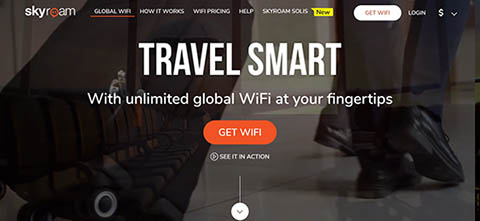
Their new Solis X device ($179.99) doubles as a 4200mAh power bank that can recharge your wireless devices via USB-C and power them with Internet at the same time. The Solis X can last more than 16 hours on a single charge (if not used as a power bank) and connect up to 10 devices at once. The device size is 3.5″ x 0.9″. It includes an 8MP remote operated camera and 4GB of storage, which you can upgrade by connecting to your Dropbox account. The new Solis X also includes an App with Skyroam's new Smart Assistant builtin. The Smart Assistant is basically a connection to IFTTT (If This Then That) service, which then allows you to make connections to other services you use like Twitter, Dropbox, Evernote, Nest, Fitbit, Amazon Alexa, Google Assistant, etc.
They also offer a Solis X Lite device ($119.99) which is the same size, can also connect up to 10 devices, but doesn't offer the camera, speakerphone, or Smart Assistant feature like the Solis X. The power bank is also optional with the Solis X Lite.
These two devices replaced their old Solis device, which you can still use for service if you already have one, but can no longer purchase the device new.
COST: How much does Skyroam cost?
1) UNLIMITED: You can BUY the new Solis X device for $179.99 or the Solis X Lite for $119.99 + shipping (calculated at checkout based on your location) and pay $9/day or $99/month for unlimited Internet. Purchasing the device also includes 1 Free Day Pass.
2) PAY PER GB: You can BUY the new Solis X device for $179.99 or the Solis X Lite for $119.99 + shipping and then pay $6/month for their pay-as-you-go GOData subscription + $6/GB (USA/Europe) or $9/GB (Worldwide). This plan requires that you own the Solis device. So to explain that in a different way for clarification, you pay $6/month for the service no matter what, then you just buy the gigabytes as you use them.
3) You can RENT the Solis X device for $8.99/day + shipping. If you choose to rent, you prepay for shipping both ways, and they include in the package a box with shipping label to return the device from whichever country you choose, or you can drop it off at one of their 150+ worldwide dropoff points.
COVERAGE: What countries does Skyroam offer coverage?
Skyroam provides Internet service in 190+ countries and growing. (It was 130 countries when I originally published this article, so they are definitely expanding.) Keep in mind that their local coverage is only as strong as the local towers they are renting from, so your service with Skyroam will only be as good as the towers around you. Skyroam offers service in a lot of countries, but they don't magically provide Internet where towers don't exist!
Speed Throttles: If you use over 500mb in one day on the $9/day or $99/month plan, they switch you from 4G speed to 2G/3G for the remainder of the day and then set you back to 4G speeds the next day. If you pay the $6/GB (USA/Europe) or $9/GB (Worldwide), you will always have 4G speed.
URL: Skyroam.com
Best Skyroam Alternatives: TEP Wireless
Skyroam Cons: 4G speed is limited to 500mbs/day on their unlimited plans.
Skyroam Discount Codes: Use this link and promo code “ TRAVELISLIFE ” at checkout for 10% off your entire purchase or rental.
#2) TEP Wireless / Travel Wifi / Sapphire Review 2020
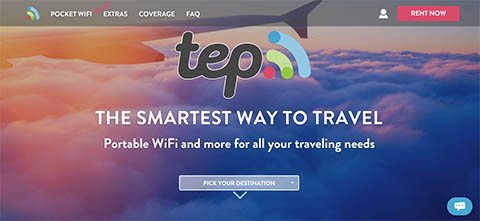
TEP Wireless stands out amongst the crowd of hotspot providers because they offer a lot of valuable extras with their subscription including the following.
1) Prime WiFi – Free WiFi hotspot access at over 60+ million hotspots worldwide + free in-flight WiFi service on American Airlines, Lufthansa, Etihad and Air Lingus fleets equipped with WiFi. This is a HUGE perk because it'll allow you easy Internet access even in places with poor cell phone coverage.
2) Kitestring – an SMS based emergency service that checks in on you while you travel via scheduled text messages that you sent the frequency of. If you don't reply to the text, Kitestring sends your emergency contacts an alert message.
3) TEP Guru – a free local concierge service that privately connects you with locals via their TEP+ App who you can ask for recommendations on things to do, places to eat/drink, and where to stay from 9am to 8pm every day.
4) VOIP Phone & SMS Service – built-in to your service via their app with international calling prices that cost about $0.01/minute.
COSTS: How much does Travel Wifi / TEP Wireless “Teppy” cost?
1) You can RENT a Teppy starting at:
- $8.95/day for 5GB of 4G service (includes travel adapter)
- $11.95/day for UNLIMITED 4G service (includes travel adapter)
The actual prices listed above vary by country, and there are too many to list. However the more expensive countries only add about $1-3/day to the numbers above.
Shipping to you is free for a few countries but ranges in price for the rest of the world. You can then either return the device to one of their drop off points for free or pay to ship it back to one of their warehouse locations.
2) You can BUY a Teppy for $149 + $9.95 shipping (or higher depending on the country) which includes 1GB, and then Pay As You Go. There are too many pay-as-you-go options to list them all, but they've got plans through Sapphire ranging from Pay-Per-MB/GB all the way to Unlimited Daily plans like when you rent. You have a lot more options when you Buy the Teppy vs Rent the Teppy. With Daily Unlimited Pay-As-You Go plans, you can start and stop service anytime for 24 hour coverage windows. Purchasing the device comes with 1 Free Day Pass.
2) You can Subscribe to a monthly plan. Update Jan 2020: Monthly plans are no longer offered.
3) You can BUY a Travelwifi SIM Card for $34.95 with 20GB included and use it in your unlocked phone, then use your phone as a hotspot to connect other devices. This is currently offered in 85 countries. After you use up the initial 20GB, you can re-up your data with similar data packages as offered above.
Coverage: TEP Wireless works in 130+ countries. Now before you go thinking, “But Skyroam works in 190+ countries!” , keep in mind that you probably won't be visiting that many countries on your next trip. So you only need to make sure that these devices work in the countries that YOU are going to. You'll want to consult both of their websites to check your specific travel destinations for coverage before purchasing or renting.
Speed Throttles: After you've used 1GB/5GB per day (depending on your plan), your connection speed gets slowed to 256kbs until the end of the day and then the speed resets the next day.
URL: TEPWireless.com
Best TEP Wireless / Travel Wifi / Sapphire Alternatives: Skyroam
Full Review: For more info, read my full TEP Wireless Review & Comparison .
TEP Wireless / Travel Wifi Cons: Throttled 4G beyond 1GB. • Shorter battery life.
TEP Wireless / Travel Wifi Discounts: Use this link to TEPWireless.com and discount code 0TEPTILORG10 for 10% off your purchase or rental.
#3) KeepGo Review 2020

COST: How much does Keepgo cost?
UPDATE February 2020: Keepgo significantly reduced the cost of their data last year. This month they introduced a new GoFi Europe USA Plan for cheaper data in those countries. More info below.
Their SIM Cards cost $49 and their WiFi Hotspots cost $99 with free shipping to 38 countries. Their hotspots weight 75 grams and can power up to 16 devices for up to 11 hours per charge. Worldwide Data is priced in bundles at $14 for 500MB, $26 for 1GB, $61 for 3GB, $88 for 5GB, and $165 for 10GB. Their new GoFi Europe USA Plan offers data at a flat rate of $8/GB in those regions. You can switch between the plans anytime. They do not offer device rentals or unlimited plans.
Coverage: Keepgo offers service in 100+ countries.
Speed Throttles: Keepgo does not throttle your 4G speeds since you are paying per gigabyte. This is a huge perk of their service. If you're willing to pay for the data you consume without worry of being slowed down, then Keepgo is a good option for this reason.
URL: Keepgo.com
Best Keepgo Alternatives: Skyroam – specifically their new GoData Plan
KeepGo Cons: No unlimited data plans (yet).
KeepGo Discounts: Use this link to Keepgo and promo code TRAVELISLIFE for 10% off your purchase.
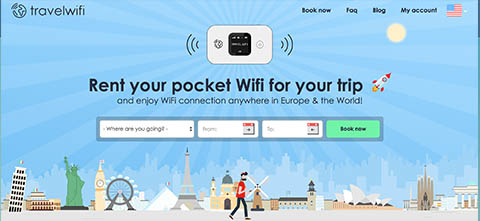
COST: How much does Travel Wifi cost?
Travel WiFi is now part of the TEP Wireless / Sapphire family of services. See my review of TEP Wireless above for their updated pricing.
Coverage: Previously Travel Wifi catered to France and Europe and offered limited Worldwide coverage, but now that they merged with TEP Wireless and Sapphire, they are able to offer worldwide coverage in 130+ countries.
URL: TravelWifi.com
Best Travel WiFi Alternatives: Skyroam
Travel WiFi Cons: No option to purchase device. • Shipping rates increase outside of France.
Travel WiFi Discounts: Use this link to Travel Wifi and the promo code “ 0TEPTILORG10 ” for 10% off your purchase.
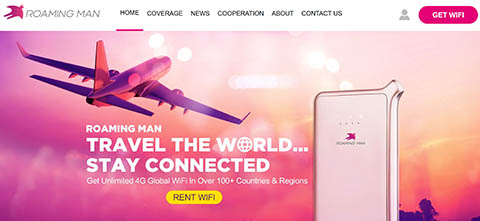
COSTS: How much does Roaming Man cost?
Roaming Man ‘s rental service starts at $7.99/day in North America, Asia, and Europe and $9.99/day in the rest of the world + shipping in both directions and they require a minimum of 5 days rental period. As of Dec 2018, they now offer an option to purchase a device for $149.99 which you can activate with service as needed.
Coverage: 130+ countries and regions. .
Speed Throttles: If you use over 500mb in one day, they switch you from 4G speed to 2G/3G (or around 256kbs).
URL: RoamingMan.com
Best Roaming Man Alternatives: Skyroam or TEP Wireless
Roaming Man Cons: 4G speed is limited to 500mbs/day on Basic and 1GB/day on Premium with no option to add more.
#6) Google Project Fi Review 2020
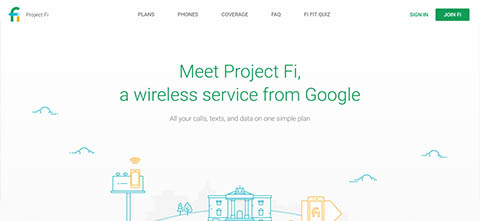
Currently through Google, you can purchase the Pixel 4 & 4XL, Pixel 3a & Pixel 3a XL, Pixel 3 XL, and Moto G7. However you can also check their compatibility list to see if the service will work with our existing phone. (For example, it'll work with my Verizon unlocked Samsung 9.) Their service lets you seamlessly shift from their cellular coverage partners to over four million WiFi hotspots around the world. You are only charged for data received over their cellular network and not when on WiFi networks. You can port your existing phone number over to Project Fi from your existing carrier or get a new number. In the USA, they partner with Sprint, T-Mobile, and U.S. Cellular to provide coverage.
Cost: Project Fi offers worldwide flat rate service fees w/ free calls to 50+ countries and rates starting at 1¢/min to other countries. They offer a combination of Pay-Per-GB and Unlimited Plans for individuals and families including:
- Individual: $70/month for unlimited calls, texts, and data (High-speed data up to 22 GB/person & slower after)
- Family: $16-$18/month for unlimited calls & texts + $10/GB for data
- Family: $45-$60/month per line for unlimited calls, texts, and data (High-speed data up to 22 GB/person & slower after)
For the Pay-Per-GB plans above, you only pay that amount you use at exactly $10/GB. So for example, if you used 1.226GB you'd pay $12.26 (not $20 for 2GB like some companies who charge for the next tier up).
Each plan also includes a free Google One membership ($19.99/year).
You can add as many tablets to your plan as you'd like for free and just pay for the data they use. While traveling outside of US, a flat $0.20/minute applies. While calling from within the US, international rates apply and vary by country. International data is the same flat rate of $10/GB in every country.
Coverage: 200+ countries and territories .
Speed Throttles: The unlimited plans throttle your speed after 22GB per month, however you can then switch to $10/GB if you need more 4G speed that month. The Pay-Per-GB plans throttle you after 15GB.
URL: Fi.Google.com
Best Google Fi Alternatives: Keepgo or Skyroam
Google Fi Cons: Only works on certain devices. • No hotspot devices. • No discount offered to Travel is Life readers.

Cost: Their SIM Card costs $14.95 + $5 shipping. Data rates start at $2.99/day, $0.11/hour, and $0.01/mb but vary per country. Their international rates average about $1.99/hour for 20mb, $9.99/day for 200mb, and $49/GB.
Coverage: 90 countries.
Speed Throttles: They do not throttle your speeds since they are essentially charging you per megabyte to be used within a window of time.
URL: AlwaysOnlineWireless.com
Best Always Online Wireless Alternatives: Keepgo
Always Online Wireless Cons: Data fees vary by country (sometimes substantially). • Separate data plan for each country. • No discount offered to Travel is Life readers.
I'm currently looking for a new service to replace them on my top 8 list since I had to remove one of them from the list. I've spent months and a lot testing / research with hotspot companies, and I'm narrowing in on one to add to the list soon. Rest assured, the wheels are in motion, but for now, I'd rather have a GREAT list of seven options than just add an eighth for the sake of having 8 options. In the meantime, stick to one of the other options mentioned on this list.
Which is the best mobile hotspot 2020?
If unlimited data is important to you then Skyroam or TEP Wireless will be a good choice because of their unlimited data options, flat rate pricing, and affordable devices. (Note: If you do go with Skyroam, be sure to use our promo code TRAVELISLIFE at checkout to save 15% off your entire purchase or rental. And if you go with TEP Wireless be sure to use our promo code 0TEPTILORG10 for 10% off.)
If you'd rather pay per gigabyte and have unthrottled 4G speed no matter how much you use, give either Skyroam or Keepgo a try and use our link for 10% off your purchase. If you have any questions about which service will fit your needs best, drop me a comment below and I'll do my best to help you out.
What's the cheapest WiFi hotspot service?
The least expensive hotspot for daily use is Skyroam with their $99/month unlimited plan which come out to $3.30/day for Internet access.
Keepgo doesn't offer an unlimited plan – but their data does not expire. So if you're only looking for occasional or emergency use Internet abroad, you can purchase 1GB from KeepGo and only use it when you need it. For minimal usage, this can be a savings because you're not paying for unlimited data that you don't need. Use this link to Keepgo and promo code TRAVELISLIE for 10% off your purchase.
See Also: Best International Data and Cell Phone Plans from USA Carriers
Travelers found this article by searching:
• International Portable Wifi Hotspot Reviews • What is the best portable WiFi hotspot for international travelers? • Unlimited Worldwide 4G Wireless Plans for Traveling • Best data plans that work in every country • Best international wifi hotspot devices for travel • Best mobile hotspot unlimited plans • How do I get Internet anywhere in the world?
If you like it then you should've put a Pin on it!

International Wifi Hotspot Frequently Asked Questions (FAQs)
Since publishing this article, I've received hundreds of e-mails from travelers asking my advice about their particular situation and which hotspot service I'd recommend. I've responded to all of them privately, however, the questions they ask could benefit other readers. So moving forward, I'll be publishing some of the questions below as FAQs (however removing any personally identifiable information from the question). If you've got a question, feel free to contact me as well.
Why is Glocalme not in your review, as their devices seem pretty convenient and affordable?
I'm familiar with GlocalMe. They're actually owned by the same company who own Roaming Man who I do include on the list.
Can I use a Skyroam plan with a different hotspot device?
As far as I know, you cannot use a Skyroam plan with a 3rd party device. If you're interested in using your own device, look into purchasing a SIM card from Keepgo or TravelWifi .
To help soothe my 93 year old mother’s worry when I travel to KSA and countries in Eastern Europe, I am thinking about purchasing (not renting) a portable wifi hotspot and have read your recent reviews. The Roaming Man purchase device highly rated by you is out of stock and I have heard some recent concerns about Solis regarding connectivity/dropped signals. Any advice?
Reviews about these kinds of devices are tough because they're so anecdotal. So someone in a rural part of France could have a negative experience with Skyroam/ TEP / Roaming Man (or whichever) while someone else in Paris could have zero issues. The variance is that any of these devices are connecting to local towers, which play a big role in how people perceive the device itself.
I personally use Skyroam and TEP Wireless — which are also the two highest picked choices by my readers. However I'm mostly in South America (although was in Georgia for two months this year and it worked fine there). Those would provide you with the most options if you own the device itself. You could also just pick up a cheap unlocked second phone as a device and use Keepgo for emergencies only (because the data lasts a year and doesn't expire if you up it a little each year). For example, you can get new unlocked phones for like $100-200 and use them as a hotspot with an International SIM like Keepgo and have the best of both worlds.
Sorry it's hard to give specific advice. So much is country / regional specific as to how well your devices will connect. You might want to make a list of each country you'll be going to and cross reference the coverage of the specific companies you're interested in to see which would provide the best coverage overall. I think you'll find that those three companies will be pretty similar though coverage-wise.
Happy to help if I can offer further assistance. The advice above is what I use / what I would do in your shoes.
I am considering being a digital nomad and traveling extensively. In the past, I just got a SIM card that included tons of data (EE, Vodafone). Your article on The 8 Best WiFi Hotspots for International Travelers is informative but can't help with my needs, as the options have data/ speed thresholds/ limitations. Am I already doing the best bet by simply tethering my cell phone's wifi to my computer? Know of anything else?
I mostly use the hotspots for convenience purposes, but like you, when I stay long periods of time places, I just buy local SIM cards from local carriers. That's always been the cheapest option for me. FYI though – not all of the options I profiled in that article you found me on have data caps. Keepgo for example doesn't throttle your speeds.
The only other suggestion I have for you is to look into subscriptions for WiFi hotspots around the world like Skype Wifi (formerly Skype Access) or Boingo. But it might be hit or miss with whether they offer wifi near where you're traveling. Sounds to me like you're on the right track with what you've got now.
Question / Suggestions
If you've got a question or suggestion, feel free to contact me or leave a comment below.
62 Comments
Looking for something while on a cruise ship. Ship charges a fortune for one device. Any recommendations?
Cruise ships really are expensive for Internet! Unfortunately, the hotspots on this list won’t be much better for you because they connect to local towers. And none of the options on this list that I know of offer service in open water. I had written another article about the Best International Data and Cell Phone Plans from USA Carriers – but unfortunately they don’t offer great options either. Cruises are a tough one as you know. Sorry I can’t be more helpful to you.
What about countries in the Middle East, such as Kuwait, Saudi Arabia, Iraq, and Turkey? Which would be best?
Hi Matt – Looks like many of them including Skyroam and TEPWireless (which have been the two most popular so far with my readers) offer the coverage you’re looking for. TEP’s got the ability to upgrade the amount of 4G data in your package for an extra couple bucks a day but Skyroam has the new unlimited monthly plan for $99/month – so depending on how long you’ll be traveling, that might be a good fit.
Do you know if any of these (or any others) will offer wifi while on a plane? I’m traveling from JFK to South Africa on South African Airways, and the plane does not have in-flight wifi.
Hey Cammi – At the moment I don’t know of any. TEP Wireless advertises on their website that their In Flight WiFi feature is coming soon and will be included with their plans, but a date has not been announced for when that’s going to happen. Sorry that doesn’t do much to help you on your upcoming trip. If you happen to find something that works for you, please pop back in and let me know and I’ll update the post to help others as well.
looks like the inflight is up
Thanks Dahlia – good find. I just confirmed with TEP Wireless too. (Not that I don’t trust you haha I just always confirm every update.) They just wrote, “Tep’s in-flight service covers American Airlines, Lufthansa, Etihad and Air Lingus fleets equipped with WiFi.”
I’ll update my post accordingly. Thank you again for the heads up.
Thanks for this helpful article! I am planning for our Summer trip to Europe and I am still searching and comparing the options for wifi rental. Would like to add a few things:
– Skyroam monthly rental of $99 is only available to existing customers who have already bought their device. And the rental renews automatically until cancelled. I have confirmed these after calling the company
– There are many negative reviews about Tep Wireless on Tripadvisor.com, mostly are from a few years back
Since Skeyroam service is so new, how can we get reliable review on their services?
bWise – You’re the best. Thank you for discovering that info about Skyroam and coming back here to share it with me and everyone reading this. I will update this post later about the $99/month only being available to customers who own the device and about it auto-renewing. Thanks again and enjoy your summer trip to Europe!
Thanks for the comprehensive article. We are Canadians going on a 21 day trip in France, and will not need any special wi-fi device after that. For that reason, rental is the best for us, I think, but I can’t find many options. What do you recommend?
Hey Mina – Your trip around France sounds like a blast. Perhaps Skyroam would be the most ideal and economical option for you if you need a lot of data since they offer the 30 Day Unlimited Package for $99. The caveat to that is you have to BUY the device itself for $149 so it’d come out to about $248 for the 30 days and you’ll have the device forever after that to activate when you please. Alternatively, Keepgo can sell you a SIM Card that you just pay for however much data you think you’ll need over the 3 weeks (or can always add more along the way). That method is economical if you won’t require unlimited data. You can just buy 2 GBs for the trip. Lastly, if you’ve got an unlocked phone, you can always just buy a local prepaid SIM Card in France. 3 weeks is enough time that it may be worth it for you to dedicate an hour when you first arrive into finding a local prepaid plan. The downside of that avenue is that you won’t have Internet the moment you get off the plane (which you might need) and you have to deal with local companies, but it’d probably be the least expensive option of the three I outlined above. If you have any specific questions though, feel free to ask here or e-mail me at [email protected] and I’ll do my best to steer you in the right direction. If you end up going with a different option all together not mentioned on this page, please pop back in and let me know. I want to keep this page updated with the best options.
Which device do you recommend for doing a live Instagram video abroad?
Hi Manuel – Technically any device that connects to 4G could handle that job, but perhaps consider either Keepgo (who don’t throttle 4G speeds at all) or TEP Wireless (who allow you to upgrade to 1GB of 4G speed per day). Because if you’ll be live streaming a lot, I’m thinking that paying for access to 4G speed would be in your best interest versus getting throttled mid-way through a live stream.
i highly recommend google fi 😀
works like a charm
I think it is worth pointing out that Skyroam has a more limited world coverage than TEP does – including pretty popular countries like Japan. This was definitely the most important factor in making my choice.
Hi. Thanks for the comprehensive survey. Kindly advise – I travel several times a year each trip 7 to 10 days, worldwide. I’d like to purchase a device and activate it for each trip separately. My data demands are not specially large. What would you recommend? Thanks in advance for your kind assistance.
Hi Udi – If you’re looking for a device (and not a SIM card), consider Skyroam . They’ve been my most popular choice amongst readers. You can purchase one of their devices and then activated it as needed before your trips. Please note their coverage area though. While their service may be great in the areas they cover, you’ll want to double check that they cover the areas that you specifically will be traveling. Good luck!
Hej, Both Skyroam and Ted don’t cover Montenegro and some other countries in Europe. And Roaming Man device sell them ONLY inside US. I live in Sweden and traveling to Montenegro, need a large data and 4 G speed. What kind of device could you recommend for me? I want to buy one…😊 Best regards/Anna
Hi Anna – Sorry to say but it doesn’t look like any of the foreign hotspot companies cover Montenegro. I’m thinking it’s because of the telecommunication companies in Montenegro not offering roaming agreements. That’s usually the case when NONE of the companies offer it. Even Travel-Wifi which specializes in Europe can’t offer service in Montenegro. Sorry to disappoint! Sounds like the best and only option for you would be to just pick up a local SIM card after you arrive. If possible, don’t do it at the airport though because they are usually heavily inflated prices. If you end up finding a better solution, please pop back in and let me know so that other people reading this can benefit from your research. Have a great time on your trip!
Hi Paul – Loved your info here! I’m doing a one time 10 day trip to Spain by myself and have an Iphone 8 w/Verizon service, I don’t want to buy a device (wouldn’t use it enough) and will need to use mapping, texting, and internet. I will be driving around the country and need reliability. I also have an older Ipad I’m taking that has AT&T wifi…Not sure if that can be connected too? EEEk I’m not tech savvy and need a little guidance on what would be the easiest way to be connected and stay connected while I’m there.
Many Thanks! Susan
Hi Susan – Thanks for stopping by before your trip. In a nutshell you’ve got three options:
1) You can buy a roaming package with Verizon Wireless for your trip and use your existing device and SIM card. I have more info about that in my article Best International Data and Cell Phone Plans from USA Carriers or just give Verizon a call to inquire. This is the most expensive option.
2) If you want to use your existing device (and not buy a separate hotspot like Skyroam or TEP Wireless ), you can get an international SIM card from a company like Keepgo to replace the Verizon SIM in your iPhone while you’re away. A service like Keepgo will connect your existing phone to 4G towers across Europe. You pre-purchase the data in GB packages and use it as you need it. This is significantly less expensive than option 1, but not as cheap as the next option.
3) You can show up in Spain, find out who their local cell phone carriers are, and buy a SIM card and prepaid plan for 10 days. A quick Google search showed me that they have four carriers: Orange, Movistar, Vodafone, and Yoigo. So you could find a store on your first day in town and purchase a prepaid plan. This would most likely be your least expensive option. Just don’t buy anything at the airport even if you see those companies with a booth setup because they often charge you 10x the price that you’d receive at a local store. Make sure to bring your passport too because they will most likely ask.
Options 1 and 2 would be your most convenient because you’d have Internet from the second you stepped off the plane without any logistics of finding a local store and getting setup with a prepaid plan, however option 3 is the least expensive. Good luck! Holler if you have anymore questions.
Looking for low-cost long-term emergency access both at home and abroad with a lot of data available when I do need it (up to ~5GB/day)
I would imagine that Keepgo would be your best bet from this list because you can top up the data once a year so that none of it expires, and there is no data capping so you’d have a lot of data when you need it.
Thanks so much for your help with this….much appreciated! Happy Travels 🙂
Well this is frustrating. I tried a Sprint hotspot about ten years ago. It was expensive ($150/mo) and provided very little data (6GB/mo). Speed and price have gone way up, but actual amount of data is still pretty much the same…
Think so? Skyroam is at $9/day or $99/mo for unlimited data or $9/GB for pay as you go. Far cry from the $25/GB you were paying with Sprint.
Have you researched Glocalme with the G3 hotspot and new S1 world phone? I’m trying to decide between getting a new device with google fi and/or a hotspot/phone with Glocalme. I go to Japan yearly and for two months at a time. I’ve rented hotspots in the past but I think owning my own or having a better longer term options makes more sense as time goes on. I like keepgo and have researched all of the other options in your list. My two main goals are that whatever I can get can work simply between us, croatia, slovenia, turkey, and japan. And my other goal is that is get get fast, unthrottled speeds in Japan for video work. Google fi throttles but at a higher point than most others.
Hi Javon – GlocalMe is the same company as Roaming Man which is why I did not include it on the list twice for hotspots. I’ve got another resource coming out about International SIM Cards (versus hotspots) and was considering bringing attention to that S1 world phone on there or making a separate article about world phones. There’s a bit of an overlap between these companies when it comes to hotspots, SIMs, world phones, but some companies only provide one or the other. It’d be a tough call if I were in your shoes too as to what to do. I personally like being able to use my same device everywhere, versus having to have a separate international phone just for traveling, which is why I’d probably do Google Fi if I were in your shoes, so that I could use a Pixel 3 the rest of the year in USA too. Sorry I’m more than a week late replying to your comment. Just curious, had you made a decision since then? And if so, what’d you decide to do?
Hi Paul, Have you heard about Sapphire Hotspot. My friends are using it and I wonder how well it works compare to Skyroam. Thanks
Hi Eric – No I have not. I added it to my list of hotspots to check out in the future though. Thanks for bringing it to my attention. What do your friends think of it?
Hey Paul, I liked your write up on TEP Wireless & was going to go with it. All though I read a horror story on them elsewhere. But it was dated in 2014 & yours was more current. I tried your code “A7YKMS7Z10 – 10% discount”. & it didn’t work. Do you have a new code for them? Fingers crossed to use them. I need a Wifi Hotspot connection in Mexico next month…
HI Louie – Thanks for letting me know that the code expired. It’s for a limited number of uses and unfortunately the only way for me to find out it’s run out is when someone lets me know. I reached out to my rep at TEP Wireless and will have the code updated on this page as soon as I have it. I also made note to e-mail you directly with the code when I have it so that you don’t have to check back. Normally they set me up with a new code within a few days, so if you can’t find another one before then, I should have a working one again by end of the week. Thanks again.
All set – same code is active again for another 200 uses. Thanks again for letting me know it had reached its limit.
Hi Paul -Great reviews and advise. Looks like the TEP code is no longer active. Any chance you can renew for another 200 uses? Thanks!
Hey Cliff – You rock! Thanks for letting me know. I just e-mailed TEP Wireless to have it renewed. I’ll post an update when it’s ready, but I also made a note to e-mail you directly when I hear back from them. Thanks again.
Cliff – New code is now active and updated on the site. Thanks again for letting me know.
Loved your thorough article! I’m another cruise traveler but am fine with coverage while in port. We’re traveling from the US to Morocco (one week at sea) then hitting many of the small islands (Canary, Funchal, Azores) on our way around western Europe (Portugal, Spain, France, Northern Italy). I tried chatting with TEP Wireless and the agent mentioned very spotty service in the island areas and they didn’t answer the question about whether or not I need to pay for service for the week we’re at sea. (In their defence, I was in a hurry and didn’t re-ask the question) What is your opinion regarding paying for the TEP Wireless daily use plan vs daily ATT phone charges while in Africa and switching to a European SIM plan once in mainland Portugal? Or did I miss the boat completely and you’ve the perfect solution (apologies for the pun).
Hi Jodi – Unfortunately if you rent a Teppy, I believe you’d have to pay for the service the entire time you rent it (which means the week you’re at sea). However, it’s worth a follow-up call to ask again. Maybe they’d send you the device early but only activate it and have you pay for the service after the cruise. It’s worth a shot asking.
You might want to consider Keepgo and buying one of their international SIM cards and just using it in your existing phone when you need it. Then you’re only paying per GB instead of per day, which might be a better fit for you for this trip.
Regarding TEP vs ATT… definitely not ATT. Their international plans are crazy expensive. I don’t mean to single out ATT either because in general, utilizing the international roaming with your US cellular plan is never usually a great choice. It’d be cheaper to buy a gig or two from Keepgo like I mentioned earlier. However, I do support getting a local SIM in Europe once you arrive in Portugal if you’ll be there a while because that would be your most affordable option. Just don’t buy it at the airport because they’re always like 10x the price. Wait until you go to a local store outside of the airport.
Does that advice help at all? Feel feel to reply back with additional questions if not.
Google Fi throttles data at 15GB. It seems to be 256kb. So, it is free data after paying $10/GB for the first 6GB, but any use over 15GB is throttled until the start of the next billing cycle.
Thanks for the info David. Do they give you the option of paying $10/GB beyond the first 6GB and NOT throttling?
Hi Paul, I travel and live in India (Kashmir) and Nepal for 3-6 mos. a year. I work for most of that time and need the internet to connect with the program I use as well as clients. I can work up to 3+ hours a day but less at times…I have an indian sim but wifi is iffy in Kashmir particularly and my plan doesn’t provide much time on the hotspot. I am “older” and not incredibly tech savvy and there are so many programs/devices out there it is confusing as to which would be best for me? Can you help me out? it would be much appreciated. thanks in advance! robin
Hi Robin – One thing to keep in mind is that these international hotspots are going to connect to the same towers that your local carriers are using. The international providers are merely renting their usage through roaming agreements. So if the areas you are traveling don’t offer a high enough quality connection, chances are that the international hotspots listed on this page are going to offer similar connection speed. The caveat to that statement is that there are often multiple sets of towers from different local providers in each area, so the international hotspots could potentially use the competitor towers which might be better. I don’t have a way of knowing though, so I wanted to provide realistic expectations.
The other bad news is that none of the carriers listed above offer service in Nepal, so you’d still be limited to working with whatever local carrier you use now. There is often overlap because the geographic coverage of these international hotspot companies because their coverage relate directly to roaming agreements. If for some reason, Nepal doesn’t offer international roaming availability at this time, then none of the major providers are going to offer service there. If anyone does first, it’ll be one of the companies on this list.
I think your best option is to continue with local carriers and go with an unlocked hotspot that you can use in any general hotspot device, which I’m unfortunately not familiar with enough to recommend one in particular. They’re pretty simple devices so most would do the trick – as long as they’re unlocked and not specific to a carrier. Please let me know if you have any more questions, or alternatively what solution ended up being best for you so that others reading this can benefit from your research. Thank you!
Hi, I am planning a year long family trip ‘around the world.’ We will spend quite a bit of time across Europe, the Middle East, Asia & Australia as well as some time in the US and Haiti. During this time, my children will be attending school via distance learning – they need approximately 4 – 6 hours per day (3 – 4 days per week) of live video conferencing via Adobe Connect. Is there any service that can handle this without a bill the size of a mortgage?
Thanks so much for your help!
Hi Mike – Your year long trip sounds amazing. I love hearing about families having experiences like that.
Regarding your question about Adobe Connect video conferencing… I did some research on Adobe’s website and found this PDF where they breakdown bandwidth requirements for web video, but they don’t easily translate that into actual MB usage.
From case studies I’ve seen in the past, it takes about 150MB / hour for video conferencing, but that differs on the video resolution you’re using and on the service itself. So for you that’d be about 600-900 MB per day, which technically would keep you under the typical 1GB daily data cap on 4G data that most of these services have to employ because of their Fair Use Policies and roaming agreements. So perhaps something like the unlimited monthly plans with Skyroam and TEP Wireless would serve you best, assuming they cover the areas you’ll be traveling which you’ll want to check ahead of time.
If any of the video conferencing is being streamed on your phones, you might also look into a service like Speedify which bridges Wifi and Cellular connections together, but prioritizes Wifi. So that way you can connect to Wifi whenever possible, but if it’s not strong enough, the Cellular 4G signal will fill in the gaps so you don’t lose connection. But remember that’s only for when streaming on your cell or tablet that has both a Wifi receiver and a SIM card.
Just throwing some ideas out here because you’ll be consuming a lot of data, so a happy balance between Wifi and 4G might be best whenever possible. Please follow up if your research takes you in a different direction. I’d love to know what works best for your world schooling scenario so I can share the solution with other families in your shoes. Good luck!
Hi. I will be travelling the length of Japan, camping along the way for 3 months. I need a reliable internet connection for daily use of email/Skype and Google maps. Can you advise which option would be most suitable? Thanks!
Hi Ronny – That sounds like an amazing trip. I hope you have a great time! 3 months is a healthy amount of time to be in one country. Aside from my suggestions of hotspots, you may also want to consider a local prepaid plan (ie: buy a prepaid SIM from a local carrier after you arrive in Japan). That would typically be your least expensive option. These hotspots I mention are great and very convenient, but you pay a premium for the convenience. For a three month trip, it might be worth the time to buy a local SIM (whereas you wouldn’t want to take the time to do that on a short trip). Alternatively, I recommend going with either Skyroam or TEP Wireless and subscribing to their $99/month unlimited plans because that would be your least expensive route versus paying for a daily rate. (Look in the article above for my current discount codes.) However keep in mind that both of those services use hotspot devices. If you’d like to just replace your SIM card with an international one and use your phone for Internet in Japan, consider Keepgo . You pay per GB with Keepgo so you’d have to be mindful of your usage (especially with Skype) as opposed to Skyroam or TEP Wireless which offer the unlimited plans. All three of those services I just mentioned work in Japan. Good luck! Happy to answer any additional question if I can help.
Recommendations for Costa Rica? We are going for a week in May and need something to keep connected (mostly posting to Facebook, Instagram and playing movies, games and apps for my son’s Kindle during down time). The Air BnB has free Wifi but I am hoping for something for the travel to and from (about and hour and a half drive from airport). Also looking for Wifi calling and texting (iPhone messages) to check on the dogs back home.
Hi Michelle – If you’re looking to add Wifi Calling & Texting into the mix, sounds like TEP Wireless would be your best bet. Alternatively, you could use any hotspot on the list above (or connect to Wifi at your Airbnb) and use a Wifi phone/text service like Google Voice. Last option, Verizon Wireless and AT&T also have Wifi Calling/Texting as a free service with your plan, so if you use either of them, that may be worthwhile. If you’re not familiar with the feature, it basically means that you can call and text when you don’t have service from any device connected to Wifi. If you did that route, you’d want to turn off Mobile Data on your phone and just connect via Wifi. Then your calls and texts would still work. Just be sure to contact either company ahead of time incase they need to activate the feature on your account and/or phone. If hypothetically you had TEP Wireless or any of those other hotspot devices, you’d be connecting to them via Wifi, so the Verizon Wireless or AT&T Wifi Calling/Texting would work the same. Just throwing that out there because maybe you don’t actually need the “Wifi Texting / Calling” that TEP Wireless offers if you use AT&T or Verizon. Have a great time on your trip!
Hi, Do you have a TEP Wireless discount code that works? When I enter: A7YKMS7Z10 it says it’s an invalid code. Thanks!
Hey Julie – Thanks for bringing it to my attention that the code is no longer active. I messaged TEP Wireless to renew it. I’ll update this post at the time, but also made note to e-mail you directly. Thanks again.
Julie – New code is now active and updated on the site. Thanks again for letting me know.
Thanks for this super helpful Article! My gf and I are both designers and are planning to travel in our SUV and freelance on the go. Therefore wifi is one of the main things that we need to figure out. At the moment it does seem like Skyroam or TEP are the best options since they have a flat rate for unlimited. I can def do more research into this but any more information or personal preferences/reasons that you can provide may help us make a decision too. Maybe you know of other freelance designers whoa re in the same position? What are they using? We will be in South America to start (probs for the first year) then may end up somewhere else. Nothing is planned that far ahead but we do know for sure that we will be traveling and designing so wifi is crucial. Looking forward to your response and insight!
Thanks MJ – glad the article was helpful. Your travel plans sound awesome, but I’ve got a soft spot for Central and South America. I’ve spent most of the last 5 years there, minus a few months in the Philippines. Don’t skip Ecuador! Regarding hotspots, I think that you’re spot on that TEP Wireless or Skyroam would be good options because of their unlimited plans. Sounds like you’d be using a lot of data like me. Keep in mind too that if you were to buy a device with Skyroam, you don’t have to do the unlimited plan forever. You could certainly do that when you need it, and then just activate it for daily usage other times. If you’re going to be spending a lot of time in Central/South America than you may also find it best to use a combination of these devices for convenience, and then local SIM cards other times if you’re going to be spending a significant amount of time in one country. That’s what I do. Good luck with your trip! Keep in touch on my Facebook .
Interested in a mobile hotspot (MiFi/WiFi) but concerned about the locations I visit such as the Philippines and Thailand. What type of coverage can one get being the network so slow there? I need to be able to access or have the ability to stream either music or movies.
Good question. The Philippines was harder for me in some areas. The thing is with these international hotspots is that your coverage with them will only be as good as your coverage with local carriers, because they’re roaming off the local towers. So many areas of the Philippines and Thailand are great, other smaller islands aren’t as good. It’s too hard to generalize an entire country when it really comes down to the specific areas you’ll be using the device. Wish I could offer more guidance here, but predicting coverage is nearly impossible. The countries you mentioned are covered by most of the hotspots on my list, but individual results may vary depending on how rural you’ll be traveling. Good luck and enjoy your trip!
So I’m headed to Iceland next week and will need to be doing some work while I’m there. We’ll be caravanning and camping around the island and as a designer, I’ll be designing posts, editing images and other products and will need a solid connection to my google drive as that’s my server. What would you recommend for the week that can help me stay connected and productive while out in the middle of nowhere. I’m open to either renting or buying as I do have an agency and this hotspot could come in handy for future trips.
Thanks, Rob
Hi Rob – I hope I’m catching you in time before your trip, or if not, that you found a great solution from the info in my post. Skyroam and TEP Wireless have been my two most popular options, and both work in Iceland. The concerning part is when you say “while out in the middle of nowhere.” Any of the hotspot companies, including those two, share towers via roaming agreements with the local Iceland wireless provides. So they will work where there is service provided by the local companies, but can’t magically make a signal appear otherwise. Your best bet would be to look up the coverage maps of Iceland wireless providers and see if they offer 4G or 3G coverage where you’re going to be. If so, there’s a good chance that one of the bigger hotspot providers will work there too. However, at that point, you could just buy a prepaid SIM from one of the local Iceland wireless providers and use your phone as a hotspot. “Middle of nowhere” is hard. Hopefully in the future Elon Musk will put all those satellite dishes in the sky and provide worldwide global satellite access, but until then my friend… we’re stuck with the coverage we’ve got in the middle of nowhere. Have a great trip!
Hello! I am currently planning a trip to Nigeria (Africa) for 2- 3 months and I am in need of a good wifi. While in Nigeria, I need to be able to work remotely, Skype calling and school work. Between TEP Wireless and Skyroam, which of the 2 would you suggest and what plan do you feel with it’s best for my need.
Hey Jill – Sorry I’m seeing your comment so late. I think that either would be fine for your needs. Both offer similar service areas in Nigeria and pricing structure. Perhaps if any of TEP’s features standout for you, they might be the way to go. Or if Skyroam’s new Solis X is attractive for it’s camera, then that. But if just for Internet service, either should do the trick. Have you already chosen one? And if so, just out of curiosity, which did you end up going with? I hope you enjoy your trip to Nigeria!
Hi Paul – Thanks for the helpful article. Quick question, I will be in Paris and Amsterdam for a total of about 6 days and was exploring renting a hotspot to use for wifi, directions, texting etc. It seems as though the Skyroam rental hotspot is the best option especially since you can connect multiple devices. What do you think? Thanks in advance!
Hi MD – I think that Skyroam would work just fine for you especially if you’re looking at connecting multiple devices. Perhaps their unlimited daily for the week would serve you well. I hope you have an amazing trip!
Submit a Comment Cancel reply
Your email address will not be published. Required fields are marked *
Submit Comment
Paul @ Travel is Life

How to Get Internet in Europe Without Roaming Fees
Home | Travel | Europe | How to Get Internet in Europe Without Roaming Fees
Having Internet in Europe is something you’ll want to consider when planning your trip to this diverse continent. Not only will Wi-Fi in Europe help you look up directions and book reservations, but it’ll keep you connected to friends and family back home.
Until a few years ago, roaming in Europe was an expensive service, so if you used the Internet, made calls, or sent texts, you’d rack up a huge bill. However, a few years ago, the European Union passed a law that made data roaming in the EU free for travelers in European Union countries, Iceland, Liechtenstein, and Norway. So, if you’re from any of those countries, you can use your phone’s regular SIM card and enjoy Internet while traveling around Europe.

How to get Internet in Europe without roaming fees
For travelers from the US, the UK, Canada, and other countries, a SIM card for Europe will help you stay connected during your trip. I always use the Holafly eSIM , which is super easy to install since it’s 100% digital. It also provides coverage in over 32 destinations in Europe, as well as unlimited data and 60 minutes of calls made and received within Europe. If you’re interested, be sure to take advantage of our Holafly discount code .

5% OFF your international eSIM card
As you can see, there are different ways to get Internet while traveling , so keep reading to see which option suits you.
Using roaming in Europe
Data roaming in Europe is a service that allows you to have mobile data for surfing the Web, making calls, and sending texts while abroad. This is possible because your telephone company has agreements with different local operators across Europe, so you can stay connected without changing your usual SIM card.
However, this service is super expensive, even if you travel to the cheapest destinations in Europe , so if you use it, you’ll come home to a big phone bill. It’s a much better idea to use an EU pocket Wi-Fi device , a European Wi-Fi hotspot , or a European SIM card. Each of these options will let you have Internet in the EU at a much cheaper price.
As I mentioned, the EU passed a law a few years ago that makes roaming in Europe free between its member countries as well as Iceland, Liechtenstein, and Norway. So, as long as you have a European SIM card , you can use your data throughout the continent, regardless of which country you bought it in, and without being charged extra fees.

Using roaming to get Internet in Europe
If you don’t have a SIM card for Europe and want to use data roaming in the EU , I’ll tell you how to do so, but get ready for a hefty phone bill. You should also keep in mind that some European countries aren’t part of this EU law, so if you want to have Internet in Switzerland , or stay connected in Andorra , for example, it’s worth looking for alternative methods.
To clear things up, here is a complete list of the countries included in the EU roaming agreement: Austria, Belgium, Bulgaria, Croatia, Cyprus, Czech Republic, Denmark, Estonia, Finland, France, Germany, Greece, Hungary, Iceland, Ireland, Italy, Latvia, Liechtenstein, Lithuania, Luxembourg, Malta, Netherlands, Norway, Poland, Portugal, Romania, Slovakia, Slovenia, Spain, and Sweden.
The United Kingdom isn’t included in this agreement, but some UK telecom companies don’t charge for roaming in Europe . However, if you’re coming from the U.S., you’ll need to find a solution so you can avoid high roaming charges.
Fortunately, there are several ways to get cheap mobile Internet in Europe , such as the Holafly eSIM for Europe . I’ll share more options below, so keep reading!
How to get Internet in Europe
If you’re coming from the United States, the UK, or any other country not included in the EU roaming agreement, your usual SIM card won’t cover data roaming in Europe . Don’t worry though because I’m sharing the best ways to get Internet in Europe .
1. Holafly eSIM , the best way to get Internet in Europe
First, the Holafly eSIM is the best way to get mobile Internet in Europe . It offers great coverage in over 32 countries, as well as unlimited data. Plus, since it’s totally digital, installation is super easy, and you can even purchase it when you’re already abroad.
To get this eSIM for Europe, you must order it through the Holafly website . Immediately after purchasing it, you’ll receive an email with a QR code that you need to scan to start browsing the Internet. If you have any issues, the Holafly customer service team is available 24 hours a day, so it’s the most convenient option.
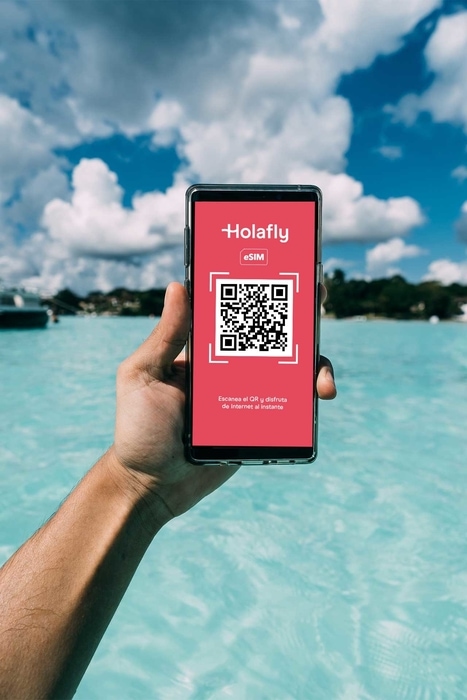
This European Internet card is ideal for travelers who don’t have a dual SIM slot on their devices. Since the eSIM is 100% digital, you don’t need to insert it and worry about keeping your original SIM safe while traveling. You can also keep your local number, making this a practical solution for people who need the Internet in Europe for work. Holafly’s European mobile plans with unlimited data also offer 60 minutes to receive calls and 60 minutes to make calls in Europe.
Before buying the international eSIM card , make sure you check your device’s compatibility here . Holafly works with all the latest smartphone models, but it’s always a good idea to check anyway.
We’ve used Holafly in over 10 different countries and have always had excellent coverage, so I highly recommend it if you want to have Internet in the EU . If you decide to get it, make sure you use our 5% discount on Holafly to save money.
2. SimOptions SIM card , another good way to get Internet in the EU
If the Holafly eSIM isn’t compatible with your device, or you prefer a physical card, I recommend the SimOptions SIM card . It offers several different plans at affordable prices, so you can get Wi-Fi in Europe without breaking the bank.
Installing this SIM is simple since you just have to insert it into your device. Of course, if you don’t have a dual SIM slot, you’ll have to remove your usual SIM and store it somewhere safe while you use the European one.

Another nice thing about SimOptions is that they can send the European mobile data SIM card to any part of Europe within 1-3 business days. This means you can have it sent to your hotel so it’s ready for you when you arrive. You can also order it before your trip and have it delivered to your house, but make sure you give yourself ample time since it’ll take up to 72 hours for it to arrive.
Depending on the card you choose, SimOptions can be more expensive than the Holafly eSIM . Also, Holafly offers unlimited Internet in Europe , so it’s my first choice.
3. Local SIM card, a cheap way to get Internet in Europe
For those who are on a budget, there are ways to get cheap mobile Internet in Europe . In this case, you can buy a local SIM card at your destination, as these cards are available in any country.
The downside is that you’ll have to spend time figuring out which option best suits your needs when you arrive at your destination. This involves comparing the different telephone companies and their prices and data plans depending on the first country on your tour.
To give you a head start, I’ll tell you that two of the most popular companies are Orange and Vodafone, which operate in many European countries. You can see an overview of their EU mobile Internet plans and prices below:
In my opinion, buying a local European Internet card can be useful for long trips. However, if it’s a short visit, you don’t want to waste time shopping around and comparing the different offers.
4. Pocket Wi-Fi, another option for using the European Internet
Another practical way to get Internet and data in Europe is by using a portable Wi-Fi device . There are different European pocket Wi-Fi options, such as this mini router , which we use and love. If you work remotely like us, this is the most convenient way to enjoy mobile Wi-Fi in Europe while ensuring a secure, encrypted connection.
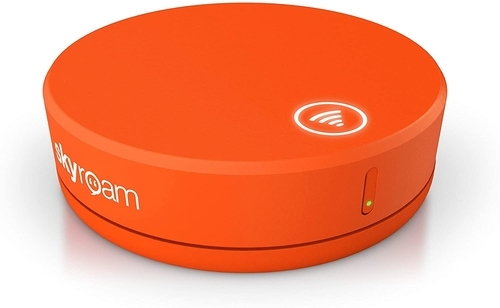
You can use EU pocket Wi-Fi even if your device is locked, and you won’t have to risk your information by using a public network. In addition to greater flexibility, having portable Wi-Fi in Europe allows you to connect several devices simultaneously. If you’re traveling as a group, this can work out great and save everyone money, compared to the other European Internet options. Otherwise, you should consider whether the benefits of a pocket Wi-Fi device outweigh their high mobile data plan prices.
5. Public Wi-Fi network, a way to get free Internet in the EU
The last option I’ll mention is using the public Wi-Fi network at hotels, restaurants, and airports during your trip. While you’ll be able to use the Internet in Europe for free , there are definite drawbacks.
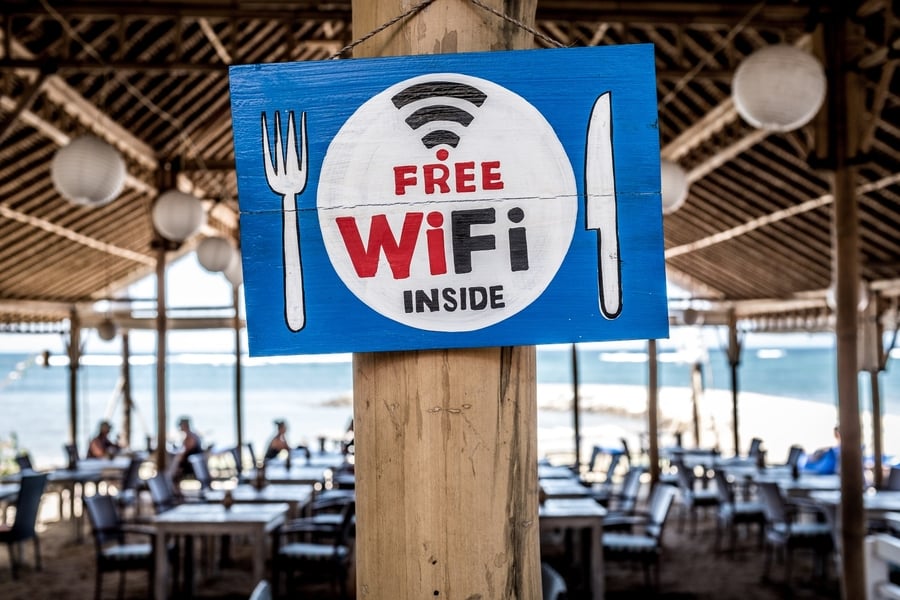
Public Wi-Fi network, a way to get free Internet in the EU
For example, the connection isn’t reliable, and may not even be secure, so you’ll risk having your data stolen. Also, the Internet speeds in Europe via public Wi-Fi are much slower since many devices are connected. You may even have a time or data usage limit per day, which can be frustrating. And of course, you’ll only be able to access the Web if you’re in that specific spot, so it’s not ideal for traveling.
If you only need to check your email and messages, then using public Wi-Fi in the EU may suffice. However, for working and staying connected to friends or loved ones, I recommend choosing one of the other options I mentioned, such as an international SIM card or European Wi-Fi router .
How much is roaming in Europe?
If you’re from one of the countries in the EU data roaming agreement, then there is no cost for roaming in Europe . Just go into the Settings menu on your device and make sure Data Roaming is activated.

How much is Internet in Europe if you roam?
For everyone else, including travelers from the UK or U.S., roaming in the EU could be pretty expensive, so I don’t recommend it. Rather, I suggest going with one of the options I mentioned in this guide, such as a European SIM card or mobile hotspot for Europe .
What is the best way to have Internet in Europe?
Hands down, the best way to have Internet in Europe is by using a European SIM card . If you don’t have one because you’re visiting from outside Europe, then I recommend getting the Holafly eSIM , a virtual SIM card with unlimited data for Europe . If your device isn’t compatible with an eSIM, then a physical card from SimOptions is the best option.
I hope this guide helps you get the best travel Wi-Fi in Europe for your needs and budget. Don’t hesitate to leave me a comment with any questions you have about accessing the Internet in Europe .
Stay safe and have a great European adventure!
Ascen Aynat

Leave a Reply Cancel reply
Your email address will not be published. Required fields are marked *
This site is protected by reCAPTCHA and the Google Privacy Policy and Terms of Service apply.

Russia is nearly isolated online. What does that mean for the internet’s future?

Russian author and journalist Andrei Soldatov used to regard his country as the most digitally connected in Europe. These days, he can barely recognize the Russian internet.
Websites with the .ru domain have been online only intermittently since the invasion of Ukraine. U.S. tech companies such as Microsoft and Oracle have stopped selling software there. Many Russians can’t pay for the private networking apps they use to get around government censorship of sites such as Facebook, after Visa and Mastercard halted operations there.
“Russia is so dependent on online services. Now, these things are falling apart,” said Soldatov, author of the book “The Red Web,” about the Kremlin’s battles over online surveillance.
Russia is three weeks into a test that the internet has never seen before: A major economic and global power is nearly isolated online after international sanctions cut off many services from abroad and the Russian government clamped down harder on online speech and access inside its borders.
How the situation plays out is likely to shape the future of the internet, not only for everyday Russians but also for the collective understanding of what was supposed to be a global network, not one divided by a “digital iron curtain.”
Experts said Russia is likely to turn to China to buy software and hardware products if it is cut off from U.S. and European products for too long. And Russia might have to scramble to find enough physical connections for its internet traffic if neighboring countries or non-Russian companies refuse traffic that runs through overland fiber optic cables.
The fiber optic cables and mobile networks that make up the guts of the internet have generally been apolitical, with a few exceptions, but the biggest land war in Europe in eight decades is challenging that idea.
“We didn’t have all those layers of politics interfering with the simple technical operation of these networks,” said Andrew Sullivan, the CEO of the Internet Society, a nonprofit organization formed in 1992 to strengthen the internet based on its original ideals, such as international cooperation and the free flow of information.
The Russian war in Ukraine is “obviously a very strong reason” in favor of some kind of response, Sullivan said, but he said he was worried about the precedent.
“The more we import those external concerns, the more likely it is that the network will be disrupted for other political reasons,” he said. “Once you open that door, there are a lot of reasons why you can imagine a network operator might disconnect.”
It’s a tension that’s always been part of the internet: U.S. military researchers created it, but it was California activists — including a former Grateful Dead lyricist — who built a mythology around it that the internet would be a universal, globalizing force for good.
Diplomatic maneuvers
Ukraine has lobbied in favor of Russia’s online isolation as one way to pressure President Vladimir Putin to cease his invasion. It even asked ICANN, a nonprofit organization that manages internet domains, to shut down .ru, a request that ICANN said went too far.
“ICANN has been built to ensure that the Internet works, not for its coordination role to be used to stop it from working,” CEO Göran Marby wrote in his response .
But the situation points toward a possible future internet divided up along national borders, in which each country’s government has what would amount to a customs office for imported internet content. Even before Russia invaded Ukraine, Russia and China were pushing a new, top-down internet protocol that would give internet providers the ability to block any website or app they choose.
“They want the ability to move to not one big global network but different networks where you can surveil your citizens more easily,” said Karen Kornbluh, a former U.S. ambassador to the Organization for Economic Co-operation and Development and a senior fellow at the German Marshall Fund, a nonprofit organization that supports stronger ties between the U.S. and Europe.
“In the longer term, Russia wants to be able to cut off access to Signal,” she said, referring to an app for secure and encrypted messaging.
The competing visions of the internet have been on display in a United Nations election campaign in which one candidate is American and another is Russian. At a conference in September, 193 countries will select the next chief of the U.N.’s telecom arm, the International Telecommunication Union, which is weighing the proposed internet protocol supported by Russia and China.
The Biden administration has also been adding diplomatic muscle to the international fight over the internet, announcing a new Bureau for Cyberspace and Digital Policy last year to be headed by an ambassador.
Concerns about the emergence of a “splinternet,” or a balkanization of the web, have been gaining momentum for other reasons the past few years. The Trump administration unsuccessfully sought to ban two popular Chinese apps, TikTok and WeChat, in 2020.
Social media’s foothold
For Russia, the isolation has been shockingly swift. Yandex, Russia’s biggest tech company and the operator of both the top Russian search engine and the top ride-hailing service, has said it is considering relocating 800 employees to Israel. Two directors have resigned, and the company has warned that it may not be able to pay its debts .
“It’s a sign of how desperate things have gotten,” Soldatov said in a phone interview from London. Yandex was the pride of Russia’s tech sector, he said. “Now it’s destroyed, and nobody knows what to do about it.”
Soldatov said many of the information technology specialists he knows in Russia are leaving for other countries or sending their children to live abroad, away from growing repression under Putin. The exodus of people overall is thought to be in the thousands .
The list of U.S. and European tech companies leaving Russia is long: Google halted ad sales, Netflix suspended service, Amazon cut off shipments, Apple pulled its products from its online Russian storefront, and other companies announced similar moves .
The big exception has been social media apps such as Facebook, Instagram and Twitter, which not only haven’t pulled out but are even fighting the Russian government to stay in as lifelines of uncensored information. YouTube, another forum for dissent, remains unblocked, but experts wonder for how long.
“Please do not cut off Russia from Facebook,” Soldatov said. “It’s the only space where you can have some sort of uncensored debate and you can talk about political news and you do not feel like you’ll be spied on by Russian security services.” (Apps for virtual private networks, or VPNs, allow people to disguise their locations and often evade government restrictions.)
It’s a role that helps to polish what has been a spotty record for social media’s relationship with democracy, and it’s a responsibility that U.S. tech companies have welcomed.
“Social media is bad for dictators,” Sheryl Sandberg, the chief operating officer of Facebook’s parent company, Meta, told CNBC at a conference last week.
Natalia Krapiva, the tech-legal counsel at Access Now, a nonprofit group that advocates for human rights online, said that whatever else happens to the Russian internet, Western powers should strive to ensure that Russians can read and hear different points of view — and not just via shortwave radio broadcasts.
“It’s not going to be helpful to isolate Russian citizens and leave them only with state propaganda that’s inciting them and urging them to hate Ukrainians,” Krapiva said.
“At the same time again, we’re hopeful that Russian civil society is resilient,” she said. “They have already been living under repressions, including digital repression, and during the past couple years it has really increased, and people have found ways to adapt.”
Above the fray?
Fights over government censorship aren’t new or unique to Russia. What’s different now is how geopolitics could affect the routing of internet traffic.
In general, a country and its local internet providers connect to the global internet by buying bandwidth wholesale from a handful of large corporations, paying by volume. Rostelecom, a Russian internet service provider, buys from about six companies, according to Kentik, a company that monitors internet traffic, and if one or more stopped selling, service could slow to a crawl depending on how much slack is in the system.
One wholesaler, Washington, D.C.-based Cogent Communications, has said it would stop selling service to Russia, while a second, Louisiana-based Lumen Technologies, has said it plans to follow suit .
“I’ve never seen this. I’ve never heard of this,” said Doug Madory, Kentik’s director of internet analysis. “Generally, the internet has been able to float above the fray. We’ve had wars, and most people in the industry feel like there’s a good reason to leave the internet alone.”
The difference this time, Madory said, appears to be the unity of the U.S. and European response, which has included other unprecedented actions, such as a partial ban from SWIFT, the global network for banks.
“This is sweeping and categorical — the amount of economic warfare to get the point across, to do everything short of shooting a bullet at a Russian soldier,” he said.
But Madory also said that, as of Monday, his company had seen little evidence in its traffic analysis of Cogent’s or Lumen’s cutting off Russian telecoms, raising the question of how far they would go in severing ties to Russia.
Mark Molzen, global issues director for Lumen, said in an email that the company was not providing any services in Russia and that its physical network there was disconnected. He added, however, that Lumen was servicing internet providers “outside Russia who are routing traffic into the country.”
Cogent said in an email that it had terminated services to customers in Russia to reduce the possibility that they “could be subverted and used for cyber attacks or other offensive activities.” But the company added: “As the Internet is by its nature a distributed system, traffic from Russian carriers may transit the Cogent network through an indirect connection via another provider.”
Not like Tonga
Regardless, Russia has connection points to its south and east that would keep it somewhat connected, even if the service is sluggish, said Nicole Starosielski, an associate professor of media, culture and communication at New York University.
“It’s not going to be Tonga,” she said, referring to the South Pacific country where an undersea volcanic eruption cut internet service entirely in December. It took five weeks before workers from a specialist ship were able to repair the undersea cable to Tonga.
“So many countries are so dependent on undersea cables and international internet traffic to function, and that’s much less true for Russia,” she said.
Putin has contemplated disconnecting Russia from the internet since at least 2014 , and he has spent years pushing to make its “sovereign internet” more independent of other countries through homegrown software. Russia even has its own suite of Microsoft-style office software , but experts said the efforts have fallen far short of Putin’s goals.
A Russian official said last week the country had no plans to disconnect from the internet.
There are other problems for Russia, such as finding replacement switches, routers and other hardware. At least one bank began stockpiling equipment before sanctions hit. The typical life cycle for such parts is two to three years, said Paul Barford, a computer science professor at the University of Wisconsin.
“In the medium term, there could be a serious impact on their ability to maintain standard levels of communication capability,” he said.
Barford said Russia may look to buy Chinese replacements, but for now, the U.S. has threatened Chinese manufacturers with consequences if they step in. Taiwan, a major chip manufacturer, is complying with international sanctions against Russia.
Building internal internet controls like those in China to monitor and censor traffic may be tempting for the Russian government, experts said, but doing so would take years of effort and enormous resources and talent that Russia doesn’t have.
“Russia could evolve something like that if there’s a will to do that over time,” Barford said. “But that is very, very difficult to do, especially if people are not aligned behind it — if there are people who are in any way subversive.”
David Ingram is a tech reporter for NBC News.
Inside Kyoto
A Kyoto Travel Guide
Internet In Japan For Tourists: Wifi, Pocket Wifi, SIM Cards, Rental Phones etc
Wifi is plentiful in Japan and there are several good options for cheap and fast data when you’re away from wifi. Here’s a full guide to wifi, pocket wifi and SIM cards in Japan.

The Takeaway
- Wifi is widely available in Japan. You’ll find it at hotels, ryokans, cafes, on shinkansen and in airports. In addition, Starbucks offers free wifi for customers (and they’re everywhere).
- Many people find that their home phone plan offers an international roaming plan that is reasonably priced and sufficient for their trip, but check with your carrier.
- You can buy data-only SIM cards in Japan (but you need an unlocked phone).
- You can buy data-only SIM cards online before your trip.
- A pocket wifi is a great solution, especially for families and groups. You can order them online and pick them up at Kansai International Airport (for Osaka and Kyoto) or Tokyo’s Narita Airport .
- For full details on all of this, see below.
Check Hotel Availability
Destination, check-in date, check-out date.

Wifi in Japan
Almost all hotels and ryokan have free wifi. While you’re out, you’ll find it in many restaurants, cafes ( Starbucks has free wifi in every store ), bars and some other public spaces like airports and museums. Wifi in Japan is almost always fast and reliable.

Data-Only SIM Cards in Japan
You can buy data-only SIM cards easily in Japan, at major airports like Narita and Kansai, and at electronics shops in any city. Just be aware that some of these cards have a brief registration process. The safest thing to do is buy them from places that will install the card for you (they can call or log on via another device if there’s a registration process). For details on which SIM to buy and where you can buy one in Tokyo, see our How To Buy A SIM Card In Tokyo page. For Kyoto, see our Where to Buy a SIM Card in Kyoto page. For Osaka, see our SIM Cards in Osaka page.

Starbucks Wifi
Starbucks are all over Japan, with multiple branches in most cities, as well as in airports and train stations. They all offer free wifi to their customers.

Pocket Wifi Rental
A great way to stay online wherever go in Japan is a pocket wifi. These are a great option for families or groups, since everyone can log onto the same unit. They’re usually fast and they offer more data than a SIM card. You can rent one from counters in the arrivals halls of major airports like Narita and Kansai. You can also easily rent a pocket wifi device with unlimited data online and it will be waiting for you at the airport.
International Roaming Rates in Japan
In case all of the above is just too confusing to deal with, you can always just bring your smartphone with you to Japan and pay international roaming rates to use it in Japan. If you’ve got the right carrier, you might be able to purchase an international add-on that allows some calls, texts and data usage for a surprisingly reasonable rate. For details on American, British and Australian carriers’ roaming rates in Japan, see our International Roaming Rates for Japan page on our sister site TrulyTokyo.com.
Kyoto Vacation Checklist
- For all the essentials in a brief overview, see my First Time In Kyoto guide
- Check Kyoto accommodation availability on Booking.com and Agoda.com - often you can book with no upfront payment and free cancellation
- You can buy shinkansen (bullet train) tickets online from Klook - popular routes include Tokyo to Kyoto , Kyoto to Osaka and Kyoto to Tokyo
- Need tips on where to stay? See my one page guide Where To Stay In Kyoto
- See my comprehensive Packing List For Japan
- You can buy an eSim to activate in Japan or buy a data-only SIM card online for collection when you arrive at Tokyo's Narita or Haneda Airports or Kansai International Airport . You can also rent an unlimited data pocket wifi router
- Compare Japan flight prices and timings to find the best deals
- If you're making frequent train journeys during your visit, you might save money with Japan Rail Pass – see if it's worth it for you
- A prepaid Welcome Suica card makes travelling around Kyoto easy – here's how
- World Nomads offers simple and flexible travel insurance. Buy at home or while traveling and claim online from anywhere in the world
- Do you want help planning your trip? Chris Rowthorn and his team of Japan experts at Japan Travel Consulting can help
Kyoto District Map

- Central Kyoto
- Northwest Kyoto
- Northern Higashiyama
- Southern Higashiyama
- Downtown Kyoto
- Kyoto Station Area
- South East Kyoto
Disclosure: InsideKyoto.com is a participant in the Amazon Services LLC Associates Program, an affiliate advertising program designed to provide a means for sites to earn advertising fees by advertising and linking to amazon.com and amazon.co.uk. World Nomads provides travel insurance for travellers in over 100 countries. As an affiliate, we receive a fee when you get a quote from World Nomads using this link. We do not represent World Nomads. This is information only and not a recommendation to buy travel insurance.
You are using an outdated browser. Please upgrade your browser .
- Guide to Russia
- Travel Tips
Phones and Internet in Russia

How to buy a SIM card in Russia
- Step 1: Locate a mobile shop of your choice.
- Step 2: Don’t forget to bring your passport.
- Step 3: Make sure your phone supports SIM cards other than your local provider’s.
- Step 4: Tell the salesperson how long you’re going to stay and that you want the most basic option.
- Step 5: They will immediately set up the new SIM card for you.
Probably the 2 most pressing questions of the 21st century when it comes to traveling to another country are: is there internet? and: do I have phone service? The short answer for Russia is: yes! If you have a Russian SIM card, you’re connected basically everywhere during your Russian tour – in the depth of the metro or in cities and towns, mobile internet and service are there for you. Let’s have a closer look at communications in Russia.
First of all, the international Russian country code is +7. However, inside the country they dial 8 instead, which doesn’t work if you’re calling from abroad. Russia uses the usual GSM and LTE Networks. Inside cities such as St. Petersburg and Moscow, you’re guaranteed to have a highspeed LTE internet connection wherever you go. Outside of cities, service can be lost every now and then, but the general coverage is still good.
If you purchased your phone as part of a contract, chances are its SIM is locked. This means you cannot use SIM cards from any other provider. Call your provider to unlock your phone or buy a cheap mobile for as little as ₽1500 ($23) when you get to Russia. You can also ask your provider if they have any inexpensive foreign “add on” plans that work specifically in Russia.
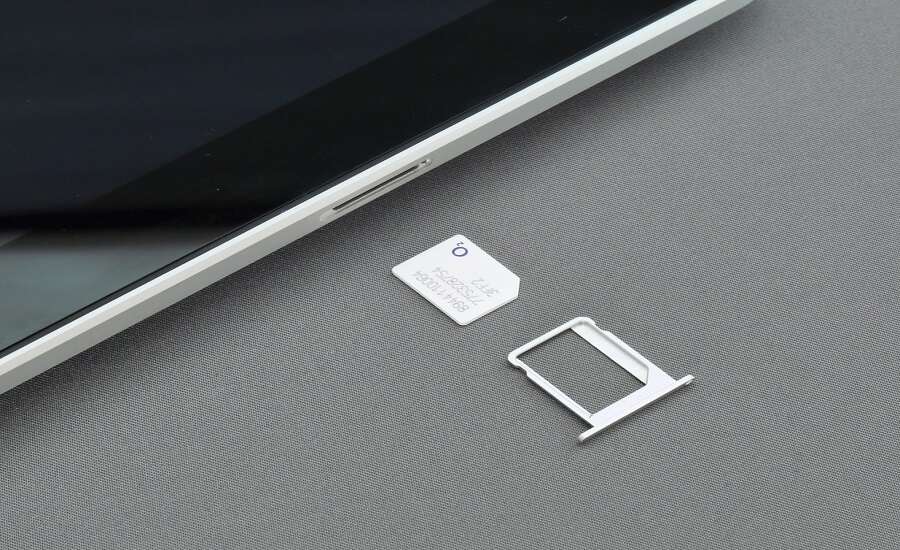
If you’re traveling between several different cities, you should check in advance if your card works all over Russia, since some SIM cards are restricted to their area code. Currently, you can purchase a prepaid SIM card for around ₽350 ($6). This will give you at least 2 GB of internet for a month, and a number of free calls and messages, depending on your tariff. Again, this is prepaid. You’re not signing up for any long-term contracts. Once your stay in Russia is over, just switch back to your original SIM card. Don’t forget to top it up if you’re in the country for longer than a month.
Most cafés, hotels, airports provide free WiFi access; however, and this is especially true for airports, this service might be restricted to owners of Russian SIM cards only. When signing up for the network, you usually get an SMS or a call. You don’t have to pick it up, just type in the indicated amount of digits from the calling number. A plus: the metro systems in St. Petersburg and Moscow have their own WiFi networks inside the trains.
Photo by Brett Jordan on Unsplash Photo by Creative Christians on Unsplash
Our travel brands include

Express to Russia
Join us on Facebook
We invite you to become a fan of our company on Facebook and read Russian news and travel stories. To become a fan, click here .
Join our own Russian Travel, Culture and Literature Club on Facebook. The club was created to be a place for everyone with an interest in Russia to get to know each other and share experiences, stories, pictures and advice. To join our club, please follow this link .
We use cookies to improve your experience on our Website, and to facilitate providing you with services available through our Website. To opt out of non-essential cookies, please click here . By continuing to use our Website, you accept our use of cookies, the terms of our Privacy Policy and Terms of Service . I agree

Moscow Hotels with Wi-Fi
Select your dates to find the best hotel deals in Moscow
- Search Hotels
Popular Moscow Hotels with Wi-Fi
- Price (High to Low)
- Price (Low to High)
- Star Rating (High to Low)
- Star Rating (Low to High)

Metropol Hotel
Outstanding

Azimut Hotel Olympic Moscow
172 Reviews

Radisson Blu Olympiyskiy Hotel, Moscow

Radisson Collection Hotel, Moscow

Hotel Baltschug Kempinski Moscow

Radisson Blu Belorusskaya Hotel, Moscow

Savoy Hotel

Park Inn by Radisson Sadu, Moscow Hotel

Hotel Continental

Azimut City Hotel Smolenskaya Moskva
See all moscow hotels with wi-fi, explore guest reviews of hotels in moscow.

Alekseevskiy Business-Hotel
5 / 5 Perfect

Cosmos Moscow Paveletskaya Hotel
4 / 5 Very Good

Metallurg Hotel

Apart Hotel Volga

Wellion Paveletskaya

Hotel Izmailovo Gamma
4.7 / 5 Outstanding
Frequently Asked Questions
How do i book a hotel on trip.com.
To book a hotel on Trip.com, simply enter your destination, travel dates, and the number of guests on the page. Then, browse through the available hotels and select the one you want to book. Follow the prompts to enter your payment information and complete the booking.
How to get cheap hotels on Trip.com?
There are several ways to discover affordable hotels on Trip.com. You can narrow down your search results by filtering hotels according to your preferred price range, or you can sort the results by price to view the least expensive options first.
Where can I find hotel deals on Trip.com?
Trip.com offers a diverse selection of hotel deals and promotions that are available throughout the year. You can easily find these special offers on our deals page . Moreover, if you are a member of our loyalty program, you can log in to your account and discover exclusive discounted rates at hotel list pages.
What is the way to get lower prices at hotels?
Sometimes booking hotels in midweek is cheaper, but it also depends on the season.
How many hotels are listed in Trip.com?
There are over 5,000,000 hotels in more than 230 countries or regions on Trip.com. Don't know which hotel to book? Browse the site to get ideas!
Can I cancel or change my hotel reservation on Trip.com?
It depends on the hotel policy and cancellation date. Kindly check the policy section of related hotel pages. To cancel or change your reservation, log in to your trip.com account, go to "My Bookings," and follow the instructions.
How do I contact trip.com customer service?
You can contact trip.com 24/7 customer service by visiting the trip.com help center and submitting a support request. You can also contact them by phone or chat, depending on your location.
Local Travel Info
Recommendations, find more hotels with facilities, popular hotels, flights for popular destinations, recommended for you.
- Customer Support
- Service Guarantee
- More Service Info

- About Trip.com
- Terms & Conditions
- Privacy Statement
- About Trip.com Group
Other Services
- Investor Relations
- Trip.com Rewards
- Affiliate Program
- List Your Property
- Become a Supplier

Advertisement
Supported by
Russia, Blocked From the Global Internet, Plunges Into Digital Isolation
Russian authorities and multinational companies have erected a digital barricade between the country and the West, erasing the last remnants of independent information online.
- Share full article

By Adam Satariano and Valerie Hopkins
Adam Satariano reports on tech in Europe, and Valerie Hopkins reports on the countries of the former Soviet Union, including Russia.
Even as President Vladimir V. Putin tightened his grip on Russian society over the past 22 years, small pockets of independent information and political expression remained online.
Any remnants of that are now gone.
As Mr. Putin has waged war on Ukraine, a digital barricade went up between Russia and the world. Both Russian authorities and multinational internet companies built the wall with breathtaking speed. And the moves have ruptured an open internet that was once seen as helping to integrate Russia into the global community.
TikTok and Netflix are suspending their services in the country. Facebook has been blocked. Twitter has been partly blocked, and YouTube’s future is in doubt. Apple, Samsung, Microsoft, Oracle, Cisco and others have pulled back or withdrawn entirely from Russia. Even online video games like Minecraft are no longer available.
The actions have turned Russia into a walled-off digital state akin to China and Iran, which tightly control the internet and censor foreign websites and dissent. China’s internet and the Western internet have become almost completely separate over the years, with few overlapping services and little direct communication. In Iran, the authorities have used internet blackouts during protests.
Russia’s cleaving off is a defeat for the once-held Western belief that the internet is a tool for democracy that would lead authoritarian countries to open.
“The vision of a free and open internet that runs all over the world doesn’t really exist anymore,” said Brian Fishman, a senior fellow at the New America think tank and former director of counterterrorism policy at Facebook. “Now the internet is lumpy. It has choke points.”
The internet is only one piece of Russia’s growing isolation since it invaded Ukraine on Feb. 24. The country has been largely cut off from the world’s financial system, foreign airlines are not flying in Russian airspace and global access to its oil and natural gas reserves is in question.
But the digital cutoffs stand out as the culmination of attempts by the Russian authorities to tame what was once an open and freewheeling internet. For years, officials stiffened a censorship campaign at home and tried to move toward what is known as a “sovereign internet.” The war led multinational companies to take the final steps.
While Russia is paying a stiff economic cost for being cut off, the digital isolationism also serves Mr. Putin’s interests. It allows him to clamp down further on dissent and information that does not follow the government line. Under a censorship law passed last week, journalists, website operators and others risk 15 years in prison for publishing “misinformation” about the war on Ukraine.
“This is going to feel like a return to the 1980s for people who lived in that era, because suddenly information is back in the hands of the state,” said Alp Toker, director of NetBlocks, a London organization that tracks internet censorship.
Internet censorship efforts in Russia have grown for the past decade, said Tanya Lokot, an associate professor at Dublin City University who specializes in digital rights in Eastern Europe. Mr. Putin first cracked down on government critics and independent news outlets online. Russia then began a campaign to install new censorship equipment to block or slow down access to websites like Twitter.
But the final break since the invasion began has jarred Russians who used the internet to stay connected with the wider world, get independent information and build their careers.
Aleksei Pivovarov, who quit his job on state television almost a decade ago in the face of growing censorship, said he had experienced a “second birth” when he started producing news shows and distributing them on YouTube. Almost three million people subscribe to his YouTube channel , where he and a team publish investigations and news reports that are unavailable on state media.
“I was completely sure that this part of my life was over forever, and I would never work as a journalist again,” he said in a recent interview. “I never thought before I came to YouTube that it was possible.”
Now the work risks putting Mr. Pivovarov in jail — or out of business. YouTube, which is owned by Google, last week blocked all Russian accounts from making money from their videos and barred Russian state television outlets from being shown across Europe. YouTube could be one of the next targets to be blocked by Russian regulators, experts predicted.
Mr. Pivovarov, 47, who is based in Moscow, said he planned to keep broadcasting on YouTube despite the risks. But he said it was unclear how long he could keep going.
“For the moment I do plan to work in Russia,” he said. “How this may change in the future, especially if YouTube will be blocked, I don’t know.”
Unlike China, where domestic internet companies have grown into behemoths over more than a decade, Russia does not have a similarly vibrant domestic internet or tech industry.
So as it is cordoned off into its own digital ecosystem, the fallout may be severe. In addition to access to independent information, the future reliability of internet and telecommunications networks, as well as the availability of basic software and services used by businesses and government, is at risk.
Already, Russian telecom companies that operate mobile phone networks no longer have access to new equipment and services from companies like Nokia, Ericsson and Cisco. Efforts by Russian companies to develop new microprocessors were in doubt after Taiwan Semiconductor Manufacturing Company, the largest maker of essential semiconductors, halted shipments to the country. Yandex, Russia’s largest internet company, with a search engine more widely used than Google in Russia, warned it might default on its debts because of the crisis.
“The whole IT, hardware and software market that Russia relies on is gravely damaged right now,” said Aliaksandr Herasimenka, a researcher at the University of Oxford’s program on democracy and technology. The Russian authorities could respond by loosening rules that have made it illegal to download pirated software, he said.
The Ukrainian government has also pressured internet service providers to sever access in Russia. Officials from Ukraine have asked ICANN, the nonprofit group that oversees internet domains, to suspend the Russian internet domain “.ru.” The nonprofit has resisted these requests.
Denis Lyashkov, a self-taught web developer with more than 15 years of experience, said Russia’s censorship campaign was “devastating” for those who had grown up with a less restricted internet.
“I was 19 years old when I bought my first computer, and it was the best investment in my life,” said Mr. Lyashkov, who emigrated to Armenia from Moscow in the past week because of the growing restrictions. “When I started, it was a whole new world. There were no borders, no censorship. Everyone could say anything they wanted.”
Mr. Lyashkov said that before he had fled Russia, the company where he worked received a demand from the government to install new government certificates on its website, a technical change that could allow regulators to monitor traffic and potentially close the country’s internet to all but Russian or other approved websites. Last year, Russia tested taking such a step.
Some Russian internet users appeared to be finding ways around tighter restrictions. Demand for virtual private networks, technology that lets people access blocked websites by masking their location, soared more than 600 percent since the invasion, according to Top10VPN, a service that tracks usage of the technology.
But other decisions by multinational companies to punish Russia’s aggression could make those circumvention tools harder to obtain. Many Russians who have VPNs pay for them using Visa and Mastercard, which have blocked payments in Russia.
“That move only helps the Kremlin in my view, unfortunately,” Mr. Pivovarov said.
Kate Conger contributed reporting.
Because of an editing error, an earlier version of this article misspelled the surname of an Oxford University researcher. He is Aliaksandr Herasimenka, not Herasmenka.
How we handle corrections
Adam Satariano is a technology reporter based in London. More about Adam Satariano
Valerie Hopkins is a correspondent based in Moscow. She previously covered Central and Southeastern Europe for a decade, most recently for the Financial Times. More about Valerie Hopkins

COMMENTS
3. Connect to Public WiFi Networks. Connecting to public WiFi networks is one of the easiest and cheapest ways to access the internet while traveling. Today, you'll find public WiFi networks in built-up areas in virtually every corner of the world; from trendy cafes in Melbourne to train stations in India.
To use it, you'll just need to remove your old SIM card, and insert the travel SIM once you arrive in your destination country. Pros: Affordable (generally under $50). Cons: Same as the previous one. To use internet on computers or other phones, you'll need to create a mobile hotspot connection (called tethering).
After reading through the options, you'll be able to make the best choice for your trip! In a nutshell, these are the 8 best ways to get Internet for travelers: Local SIM card. Holafly eSIM card. International SIM card. Unlocked portable router.
1. Use Your Mobile Provider. The first thing to do is check with your mobile phone company if they offer any form of roaming as part of your package for the countries you are visiting - often referred to as an international plan. This might be the easiest and cheapest way to get online when you travel.
Plug Your Laptop In. Probably the simplest tip of all: just plug your laptop into a power socket. Most computers will reduce the strength of their wireless card slightly when running on battery. That's great for giving you longer in front of the screen, bad for seeing that weak Wi-Fi network down the hall.
But for other travel, Verizon takes a more user-friendly approach through TravelPass, which is a super spiffy option to use your phone abroad exactly like you do at home. To get started, you simply text "TRAVEL" to 4004 and you'll be set. Whenever you use your phone abroad, you'll be charged $10 for the day.
A hotspot—whether it's the one on your phone or a separate mobile device—is the easiest and quickest tool you can use to get Wi-Fi while traveling. As long as you have a data plan and network coverage where you're traveling, all you need to do is switch on the Wi-Fi hotspot to provide internet access for multiple laptops, tablets, and ...
A pocket Wi-Fi or Mi-Fi device - works with a SIM card and allows you to connect multiple devices to it. You can use a Wi-Fi booster device to extend its coverage area and have good Wi-Fi in any spot of the RV. A personal Wi-Fi hotspot - turn your smartphone into a Wi-Fi hotspot and connect the devices that need internet to it.
Huawei E5576-320 4G LTE Mobile Wi-Fi Router. This high-speed mobile router and multi-mode wireless terminal is for use in Europe, Asia, the Middle East, and Africa. The hotspot offers 16 Wi-Fi connections at a time, and the unlocked carrier connection means you can use 3G signals from any provider.
This Starlink package gets you unlimited mobile global data inland, plus your choice of 50GB, 1TB, or 5TB of Mobile Priority data with faster speeds. Prices range from $250-$5,000 per month. It's pretty easy to decide on a plan. If you need either in-motion or global capability (or both), get the respective plan.
Reliable hotspot built for traveling, with 18-hour battery life and 450Mbps download speeds. $170.25. See At Amazon. The NETGEAR Unite Explore AC815S is a fast and reliable hotspot with 18 hours ...
The short answer is: more easily and cheaply than you might think. These days, traveling abroad with a mobile phone, tablet, or laptop (or some combination of the three), makes it easier than ever for you to inexpensively communicate on the run and keep in touch with friends and family back home. Plus, having a mobile device on hand can help ...
The Future of Travel Internet: Emerging Technologies. As we look to the horizon, the future of travel internet is as bright as the glow of a lightsaber in a dark room. Emerging technologies promise to make connectivity issues a thing of the past, like floppy disks and dial-up tones.
If you need a fast and reliable internet connection just about anywhere, Netgear's Nighthawk M6 Pro might be the solution. It's compatible with AT&T, T-Mobile, and Verizon in the U.S., and it ...
The Best Portable Internet Plans in 2024. While many mobile carriers offer mobile hotspots, the Big 3—Verizon Wireless, AT&T Wireless, and T-Mobile—gives the best coverage options in the U.S. Of the 51 mobile broadband providers, we believe the Big 3 are worthy of your attention. Mobile provider.
#2) TEP Wireless / Travel Wifi / Sapphire Review 2020. TEP Wireless is a pioneer in the worldwide Internet industry and has been recommended by top travel bloggers around the world since they launched in 2011. They have proven to be one of the most popular choices amongst my readers. Recently they merged with Travel Wifi (who were formerly #4 on this list) and Sapphire — and are now all ...
Inseego MiFi M2000 5G and 4G LTE Hot Spot for T-Mobile. Amazon. With 5G and 4G LTE connectivity and the ability to connect a whopping 30 devices with Wi-Fi 6 technology, this is an affordable hot ...
In my opinion, buying a local European Internet card can be useful for long trips. However, if it's a short visit, you don't want to waste time shopping around and comparing the different offers. 4. Pocket Wi-Fi, another option for using the European Internet. Another practical way to get Internet and data in Europe is by using a portable ...
Diplomatic maneuvers. Ukraine has lobbied in favor of Russia's online isolation as one way to pressure President Vladimir Putin to cease his invasion. It even asked ICANN, a nonprofit ...
You can buy data-only SIM cards in Japan (but you need an unlocked phone). You can buy data-only SIM cards online before your trip. A pocket wifi is a great solution, especially for families and groups. You can order them online and pick them up at Kansai International Airport (for Osaka and Kyoto) or Tokyo's Narita Airport.
Step 1: Locate a mobile shop of your choice. Step 2: Don't forget to bring your passport. Step 3: Make sure your phone supports SIM cards other than your local provider's. Step 4: Tell the salesperson how long you're going to stay and that you want the most basic option.
Find hotels with free WiFi from luxury accommodations to cheap and discount hostels in Moscow in Moscow, most with free cancellation policy. Read real guest reviews and ratings to book the best deal for you on Trip.com today!
Internet censorship efforts in Russia have grown for the past decade, said Tanya Lokot, an associate professor at Dublin City University who specializes in digital rights in Eastern Europe. Mr.